Protect Your Trip »
Vacation packing list: 27 essentials for any trip.
This vacation packing list covers the major essentials you don't want to forget.
Vacation Packing List

Getty Images
Make sure you have everything you need for your next getaway.
While every vacation packing list ultimately looks different based on a variety of factors – the destination, traveler(s), budget and more – consider this guide a jumping-off point for the must-haves. You can also scroll down to More Vacation Packing Lists to see recommendations for specific trips.

Vacation packing list
For the journey, for the vacation.

Courtesy of Coolife
Before your adventure begins, you'll want to decide what type of bag(s) to pack. To determine the type of luggage you'll need, consider:
- How many days will you be traveling? If you're traveling for a week or longer, you may want to bring a large suitcase that can be checked in at the airport, or perhaps a complete luggage set . For a shorter trip, a carry-on and personal item (such as a backpack or small weekender bag ) should be sufficient.
- Who are you traveling with? Determine if you can combine your belongings to avoid unnecessary checked luggage fees. If traveling with children who can help carry bags, consider some kids luggage they'll be excited to carry or roll along.
- What type of climate(s) will you be in? For cold weather vacations, you might consider stuffing all of your outdoor gear into a rolling duffel bag .
- What are the baggage restrictions for your mode of travel? Check carry-on size requirements for your specific airline to ensure your luggage will fit in the overhead bin. Cruise lines also have weight and quantity restrictions for luggage, so consult your cruise line's website for additional details.
- What kind of clothing will you need? Is this a casual trip or will you need formalwear for dinners and other gatherings? If you'll need the latter, you might want to purchase a garment bag to prevent wrinkled clothing.
Packing cubes

Courtesy of Eagle Creek
To maximize suitcase space and stay organized, invest in at least one set of packing cubes. Travel experts recommend any of the packing cubes by Eagle Creek , as well as this cheap, quality set on Amazon . For more options, check out The Best Packing Cubes, Chosen by Travel Experts .
Credit cards
When traveling, it's good to have at least two credit card options with you. That way, if there are any issues with one card (or maybe a merchant doesn't accept American Express or Discover, a common occurrence when traveling abroad), you've got a backup payment option. It's also helpful in the event your credit card gets compromised and subsequently locked.
Read: The Best Travel Credit Cards
Travel documents
Having your boarding pass and personal identification is essential no matter where you're traveling. For international travel, you'll want a passport wallet for your passport along with any visa or customs forms you may need. Be sure to keep these documents either on your body or in your personal item that you place in under the seat in front of you on the plane (not in the overhead bin, where you may not always have access).
Travel pillow

Courtesy of Cabeau
Whether it's a long flight, train ride or car trip, dozing off without support can be a literal pain in the neck. Depending on what's comfortable for you, the Cabeau Evolution S3 and the Trtl Travel Pillow are two of the top U.S. News travel pillows . If you're short on space, you may want to consider the multitasking Tube Travel Neck Pillow , which doubles as a packing cube.
Water bottle
Staying hydrated while on the go is essential, and traveling with a reusable water bottle is an environmentally friendly way to do it. The LifeStraw Go is dishwasher-safe (when you remove the filter) and made of BPA-free plastic; the flip-straw has a two-step filter to trap bacteria and more. To keep your water cold for hours, the YETI Rambler has a durable stainless steel construction in a variety of colors and is the perfect canvas for travel stickers you collect along the way. To save space, try the Nomader Collapsible water bottle.
Hand sanitizer and holder
Keeping your hands clean while traveling helps fend off germs and unwanted illnesses. Hand sanitizer is essential for any trip, and clipping a travel-size bottle of it to your carry-on or handbag makes it easily accessible when you need it. You can find hand sanitizer holders on Amazon or at your local dollar store. You may also want to consider some antibacterial wipes for your in-flight tray table and sticky situations.
Toiletry bag and toiletries
Organizing your makeup, hair products, personal hygiene items and shaving supplies in a quality toiletry bag – such as the well-rated Lug Trolley on Amazon – makes it easy to find your essentials while traveling. Depending on what you plan to pack, a hanging style like the L.L.Bean Personal Organizer Toiletry Bag , with a removable shower caddy and built-in hook, helps to save counter space and is especially useful in tight cruise ship cabins. To easily see everything at once, choose any of the clear cosmetics cases from CALPAK , which are available in multiple sizes and color trims.
For air travel, you'll need to keep in mind the TSA's 3-1-1 rule: that all liquids, gels and creams must be 3 ounces or less and placed into a one-quart clear bag. You can find refillable and travel-size toiletries and reusable quart-sized TSA-approved bags on Amazon .
Read: The Best Toiletry Bags
Medications and first-aid kit
You'll want to be sure to pack any prescription medications in your carry-on bag, along with other medications you may need while traveling, such as Dramamine . It's also helpful to have a travel-size first-aid kit with Band-Aids, antibiotic ointment and more.
Compression socks
For everything from long flights to walking miles exploring a new destination, compression socks can help provide additional support and reduce swelling. With varying levels of compression available, one medium-level option to consider is the Bombas Everyday Compression Socks – a U.S. News top pick .

Tips on Trips and Expert Picks
Travel tips, vacation ideas and more to make your next vacation stellar.
Walking shoes

Courtesy of Birkenstock
Every journey includes a fair amount of walking, and nothing can put a stop to the fun like foot pain. Before you depart, be sure to invest in a comfortable pair of walking shoes . For a sneaker style, the ASICS Gel-Contend is a U.S. News top pick. If you'd like a slip-on style, the Cole Haan 4.ZERØGRAND Loafer for both men and women provides comfort and stability, while being able to be dressed up or worn casually. For a sandal, consider a supportive option like the Birkenstock Mayari .
Travel purse/bag
One way to keep identification, credit cards and other personal information organized and protected while traveling is with a well-designed purse or belt bag , such as the Anti-Theft Classic Messenger or the Anti-Theft Active Waist Pack by Travelon . The Lug Convertible Carousel also includes RFID protection and can be worn as a belt bag or as a crossbody.
If you're looking for a fashionable bag that can easily go from day to night, check out the TUMI Voyageur Crossbody , which has a choice of leather or nylon construction with leather accents, multiple compartments and gold hardware. The sustainable and machine-washable Vera Bradley Utility Tote Bag is another great option, with a removable shoulder strap and exterior pockets for your phone and other essentials.
Read: The Top Travel Purses
Long-sleeved shirt
When you're traveling, there's a good chance you might be changing climates or find yourself a bit chilled from air conditioning. Pack a long-sleeve tee, such as the L.L.Bean Beyond Soft Tee for women or the Carefree Unshrinkable Tee for men . This basic wardrobe staple works as a shirt on its own, a base layer in colder weather or a pull-on style over a tee. For young travelers, consider the Kids' Graphic Tee from L.L. Bean for a bit of playful fun.
Button-up shirt
For a shirt that can truly multitask, pack a button-up shirt. A classic style – like a Calvin Klein shirt for men or a timeless white button-down for women on Amazon – can be dressed up for dinner or a museum visit, paired with shorts and rolled sleeves for exploring, or put it on with a bathing suit as a cover-up.
This wardrobe staple is a travel essential. Versatile black, white or navy tees can be worn alone, under a blazer or layered for added warmth as needed. Pack a few basic options like the cotton tees at Lands' End for women , men , girls and boys , then add a fun graphic tee or two.
Packable jacket

Courtesy of Patagonia
A jacket that can fold up small to be tucked into your luggage is essential for any vacation packing list. From rain jackets to lightweight puffer jackets, choose the perfect packable jacket to keep you warm and dry in any locale.
Evening outfit
Even if you're going to the beach or planning a casual retreat, chances are you'll go out for a nicer dinner at least one night. Women may want to consider a black travel dress on Amazon , which can be dressed up with evening sandals and a necklace (or worn during the day for sightseeing). Men can invest in a packable travel blazer and wrinkle-free dress pants.
Reusable/foldable bag
Whether you're heading to the local market or going on a day trip, a packable tote like the CALPAK Compakt Tote Bag is ideal for stowing your daytime essentials and finds you buy along the way. If you're the type that likes to buy a lot of souvenirs from your travels, the Lug Packable Boxer is ideal to use for a day tote while traveling and as a personal item on your return flight. One of these reusable bags can also double as a beach bag. Or, if you want to bring a beach bag to double as your everyday travel bag, check out the best beach bags from U.S. News for additional recommendations.
Read: The Top Travel Accessories, Chosen by Our Editors
Focus on the moment (and enjoy the visual later) with a digital camera like the Panasonic Lumix G100 4K . A mirrorless model with both the ability to capture video and still images offers versatility whether you want to record the waves at sunset or snap a selfie in front of a museum. To get creative angles or have a tripod on the go, the Joby GorillaPod is a flexible and bendable option for travel.
If you're an active traveler, a GoPro HERO9 is a must-pack item. It has built-in stabilization features, and you can livestream your endeavors, film video or shoot images with this waterproof design. For a vintage-infused photo gallery, the Fujifilm Instax Mini EVO Instant Camera is a hybrid camera that allows you to store images on a memory card or print them directly from the device. It's the perfect way to document your travels along the way.
Reef-safe sunscreen
Protect your skin and the oceans with reef-safe sunscreen . Depending on your destination, some places – including Hawaii; Key West, Florida; Aruba; parts of Mexico and the U.S. Virgin Islands, to name a few – have laws against the sale of sunscreens with reef-harming ingredients such as oxybenzone and octinoxate. Many of the traditional brands of sunscreen have these ingredients, so look for an effective mineral-based sunscreen like Blue Lizard or Sun Bum .
In addition to sunscreen, a hat protects your face from the sun's harmful rays. What's more, it can be a fashionable addition to your beach attire. A packable style like the San Diego Hat Company women's large brim hat can be rolled and packed into a suitcase or carry-on, and provide a generous amount of shade at the beach, by the lake and beyond. For more recommendations, see U.S. News' list of the best beach hats .
While there's an endless array of bathing suit options, classic styles like a black tank suit for women can be paired with a long skirt to be transformed into an outfit. Or, a classic men's swim trunk can be worn with a polo top to maximize your vacation wardrobe. For the kids, Lands' End offers cute and functional designs for girls and boys .
Beach towels
Whether you want to add something soft to your favorite beach chair or you want to lay it right on the sand, a beach towel that repels sand and dries quickly is a vacation must-have. Consider a quick-drying oversized Turkish towel from Amazon or an attention-grabbing Lilly Pulitzer beach towel . You may also want to invest in a beach blanket .
Ideal as added sun protection or for walking through the air-conditioned corridors of a resort or cruise ship, a cute swimsuit cover-up is another packing essential. Some options include a chic J.Crew beach shirt , a stylish romper or a sheer La Blanca kimono .
Read: What to Wear on a Cruise
Nothing says laid-back vacation like a pair of flip-flops. Havaianas has styles for the whole family , in an array of colors and prints to coordinate with your beach attire.
Water shoes
Cuts on feet from coral, shells or even glass can be extremely painful. To protect the soles of you and yours, consider the Native Jefferson shoes , available in both children's and adult sizes. Designed for street wear, these versatile shoes are also water-friendly, making them ideal for everything from strolling the boardwalk to tubing down the river. For a more traditional water shoe, check out the Keen Newport sandals .
Sunscreen and cover-ups may protect your skin, but the sun can really hurt your eyes (especially when it reflects off the water). Top off your vacation style with Ray-Ban aviators or a classic Wayfarer . If you're seeking a chic retro vibe, you can't go wrong with a Kate Spade cat-eye frame.
More Vacation Packing Lists
Check out these other packing guides compiled by U.S. News:
- Beach Packing List
- Cruise Packing List
- Alaska Cruise Packing List
- Road Trip Packing List
- Camping Packing List
- What to Pack in a Carry-on
Why Trust U.S. News Travel
Rachael Hood loves the entire packing process. From finding the right suitcase to curating the ideal wardrobe and accessories for every trip, Hood has been perfecting her vacation packing list for years. Her must-pack items include a TUMI handbag, a Lug cosmetic case and a CALPAK packable tote. She used her personal experience along with retail merchandising background and research skills to create this list.
You might also be interested in:
- The Best Vacation Rental Travel Insurance Plans
- How to Renew Your Passport
- TSA Precheck vs. Global Entry: Which One Is Right for You?
- Can I Use My Own Airplane Seat Belt Extender?
- What Is Allowed in a Carry-on Bag?
Vacation Ideas for Every Traveler

Tags: Travel , Travel Gear
World's Best Places To Visit
- # 1 South Island, New Zealand
- # 4 Bora Bora
If you make a purchase from our site, we may earn a commission. This does not affect the quality or independence of our editorial content.
You May Also Like
The best charleston tours.
John Rodwan April 4, 2024

The Best Napa Valley Wine Tours
Amanda Norcross April 4, 2024

The 10 Best Denver Tours
Lyn Mettler April 4, 2024

Top Memorial Day Weekend Getaways
Nicola Wood April 3, 2024

The Best Way to Renew a Passport
Amanda Norcross April 3, 2024

The Best Checked Luggage
Erin Evans , Rachael Hood , Catriona Kendall , Sharael Kolberg , Amanda Norcross and Leilani Osmundson April 3, 2024

The Best Venice Tours
Lyn Mettler and Marisa Méndez April 2, 2024

The Best Travel Toiletry Bags
Amanda Norcross April 2, 2024

U.S. News Best Bed & Breakfasts Rankings
U.S. News Hotels Editors April 2, 2024

The Best Carry-on Backpacks
Rachael Hood , Erin Evans , Catriona Kendall , Amanda Norcross and Leilani Osmundson March 29, 2024


49 Things You Need to Do to Plan Your Best Trip (Free Travel Research & Planning Checklist)
- Updated: 01/02/2024
Before you jet off on your next adventure, ensure you have all your travel research and planning in order. To help, use this ultimate travel research checklist to guide you through the necessary steps for more enjoyable planning and a stress-minimized trip.
I love to travel, though I do not necessarily enjoy all the tedious steps required to get out the door and start having fun. So, I rely heavily on checklists like this planning list , a packing list , and a prep and close-the-house list to streamline my departure. Leaning on these saves me time and money and helps to avoid unexpected situations, making for worry-free trips. I hope they can do the same for you.
So, whether you are a seasoned traveler or a first-time adventurer, I have designed this travel research and planning guide to cover the things you must cross off your to-do list before leaving for a trip.
From the fun stuff like flights, accommodation, and local attractions—to the necessary details, especially for more complicated international travel, like getting visas , knowing about local customs, and purchasing travel insurance , use this list to explore the world confident you have things covered.
Table Of Contents
Download your free travel planning checklist here.
Prefer not to print? Jump to my explanation of the 14 stages of trip planning with 49 separate things you should do below. Otherwise, click the image beneath to access and print my free Travel Planning Checklist .
The Importance of Travel Research
Before setting off on any adventure, it is crucial to do your research. Travel research helps you gather information about your destination, allowing you to make informed decision s and avoid unnecessary stress. By taking the time to research and plan, you can uncover hidden gems, know about local events, find the best deals, and arrange your itinerary to maximize your trip enjoyment.
Plus, conducting research helps travelers be more thoughtful and respectful visitors by being aware of local customs.
Sign up for my monthly Discovery Newsletter & get a free Trip Budget Calculator !
Learn how to further simplify your trip research, planning, and organization for every stage of your trip in “ 5 Proven Ways to Simplify and Organize Your Travel Research .”
When to Start Planning a Trip
When is the ideal time to start planning a trip? Whenever you decide to go! Though—several months, or at least six months in advance , is generally best.
However, some destinations, like high-demand national parks with limited visitor and lodging capacity, may require planning up to 12 months or more in advance.
Plus, it depends who is traveling . Solo or couple travelers can more easily plan last-minute trips as they tend to have more schedule flexibility (i.e., not following family school break schedules) and can choose from more affordable double or single-room lodging options, which tend to be more abundant.
Because families usually require more of everything , from plane tickets to more spacious lodging and even bigger rental cars, planning further in advance becomes more necessary, especially as it allows them to secure the best of these resources at the best pricing. If you are a family traveler or part of a big multi-generational group, you will want to begin planning further in advance—six months to a year is ideal.
14 Stages of Trip Planning & 49 Tips
How you follow these 14 stages of travel planning depends on how long you have before you depart for your trip and your comfort level with leaving things to the last minute.
Because I do not enjoy the feeling of big to-dos being undone or last-minute scrambles, I aim to complete all 14 stages of travel planning anywhere from one to several months in advance. Alternatively, you may feel more comfortable playing your timeframes looser.
Step 1: Decide on Your Destination (7 Questions)
Step 2: International Travel: Understand Visa & Vaccination Requirements & Travel Restrictions/Warnings (4 Tips)
Step 3: On Budgeting, Know What You Can Spend (Budget Template)
Step 4: Set a High-Level Itinerary (Get Shortcuts)
Step 5: getting there, find the best deals on airfare (3 resources).
Step 6: Getting Around, Rental Cars & Local Transportation Options (6 Tips)
Step 7: Choose Where to Stay (Shortcuts & Resources)
Step 8: Decide, Save & Book the Things You Want to Do (4 Tips)
Step 9: Focus on Food, Reserve Restaurants & Learn About Local Dishes (2 Recommendations)
Step 10: Create, Update & Finalize a Detailed Trip Itinerary (Resources)
Step 11: Plan for Emergencies & Unexpected Situations (3 Tips)
Step 12: Packing & Prepping Your Home Before Your Trip (Resources)
Step 13: Make Your Finances Accessible on Domestic & International Trips (13 Tips)
Step 14: Stay Connected While You Travel (Resources)
You may have several destinations in mind for an upcoming trip—or none at all. To get assistance narrowing down your options, consider your travel wants, needs, and limitations by answering the seven questions below to help you figure this out.
How long do you have to travel?
Your work and school schedules or family obligations may dictate the duration of your travel. Or perhaps budget constraints cap the number of your away-from-home vacation days.
So, before you choose where to go, know how long you can spend there. If your holiday break is limited, you will want to minimize the time or expense of transportation, guiding you to pick closer destinations or places with direct flights.
What do you want to do?
Do you want a warm week lounging on the beach within reach of an easy and affordable nonstop flight? Or are you looking for a city trip with cultural activities? Perhaps the pull of nature is strong, and you want a hiking adventure? Or a bit of all of the above? Know what experiences you or your group would like to have during your time away and pick a place that meets it best.
This question is linked to the one above but digs deeper. Confirm your potential destination offers the right breadth and depth of activities and cultural or culinary highlights. Are there enough things to do and experience to last your trip and meet your wants and needs? Determine whether these options will make for an ideal visit.
How to get there?
Explore how to get to your potential destination. Does getting there require a multi-day drive? Or a flight with a long layover? Gain a high-level idea of the time and cost involved with the “getting there” part of travel and confirm your time off can easily accommodate long transit times if required. Then, further dive into this step by learning your best options for getting around once you arrive, here .
When is the best time to go?
To avoid destinations during their rainy seasons and less ideal temperature times, look up historical weather averages for your potential vacation spot before you commit. Use a helpful site like SunHeron to look at month-by-month temperatures and rainfall for nearly any destination. Doing this will give you a better chance of having the weather be a helper for a great experience instead of a hindrance
What do you want to pay?
It is never fun to start digging into a trip to an incredible place only to realize a few steps in that you cannot afford it. This exact situation happened to us. Several summers ago, we did not plan far enough in advance for a family summer trip to pricey Jackson Hole, Wyoming. Limited availability and expensive lodging options forced us to backtrack and find a more budget-friendly alternative destination—surprisingly, Vail, Colorado.
So, before committing to a spot, set your budget , then do quick hit searches on the costs of available transportation, lodging, activities, and dining to confirm they fit what you can afford.
Is it safe?
Ensuring your health and safety during your trip should be a top priority, especially when visiting an international destination and you are unfamiliar with the customs and language. Before you go, look up travel warnings , read recent traveler accounts on blogs or social media channels, and even message the account owners with your safety questions. Then, check the local news sites.
Gathering information about recent on-the-ground experiences will help you decide if this destination is right for you.
Step 2: International Travel: Understand Visa & Vaccination Requirements & Travel Restrictions/Warnings (4 Tips)
This step is for international travel. Before buying your plane tickets, understand entry requirements related to passports and visas, if applicable.
Ensure you have an up-to-date passport & learn about visa requirements.
For international travel, always ensure your passport will not expire soon and it will be valid for your dates of entry. A good rule of thumb is your passport should be valid for six months after entry . However, sometimes it is less. Confirm exact entry requirements by researching this with the official government customs and tourism organization for the country you plan to visit.
A quick online search should get you the answers you need. For US travelers, check and confirm destination requirements on the helpful “ Learn About Your Destination” page of the US State Department website.
If your passport is expired or set to expire within a validity window, like six months, take immediate steps to renew it. In the US, obtaining a new one can take weeks, if not several months. Get all the details you need about obtaining and renewing US Passports here .
Review travel advisories, security alerts, vaccination & other health requirements.
For US citizens planning to travel abroad, search for your destination on the US State Department website , look for travel advisories, security alerts, and detailed information about health matters, including links to vaccination requirements. Or go directly to the US Centers for Disease Control & Prevention (CDC) Destinations page for extensive health recommendations.
Additionally, maintain your safety by booking lodging in busier and well-known areas and following the tips I recommend here to prepare for unexpected emergencies .
If traveling to Europe, know about EITAS, a coming-soon travel permit requirement.
Also, if you plan to travel to Europe, learn about the new electronic travel authorization (ETIAS) for visiting Europe. This coming-soon authorization is not a visa. It is a travel permit. As non-EU Schengen members, US travelers must eventually apply for this new travel authorization before entering Europe.
US travelers, enroll in STEP.
For US travelers for an extra measure of security and safety, consider enrolling your trip with the US State Department as part of their Smart Traveler Enrollment Program, or STEP . Doing this will share your travel status with the US government which will allow you to receive important safety information about your destination country and help the US Embassy contact you in an emergency. Enroll here.
Step 3: On Budgeting, Know What You Can Spend
Does your budget determine where you can go? Or does your destination determine your budget?
An essential part of your travel planning is being realistic about what you can afford . There are few better ways to ruin the effect of a top-notch vacation than to return home after it, realizing you overspent, and then having to contend with the pain of outsize credit card debt and the regret that comes with it.
Instead, book a trip to a place that meets you where your money is. Memorable travel experiences do not have to cost a fortune.
Use a budget calculator like the one I provide for free with signups to my monthly Discovery travel newsletter , shown above. Or create your own budget that includes the major expense items like transportation, lodging, activities, meals, and incidentals that cover anything from souvenirs to travel insurance to pet sitting.
Once you decide on your destination , determine if you will stay in one place or move around and make multiple stops. Will your path of travel be circular—where you end up in the original place you began so that you are flying into and out of the same airport? Or will it be linear? A linear path means you will fly to one destination and return home from another—requiring plane tickets commonly referred to in the travel industry as open jaw tickets.
Your budget and available vacation time may dictate staying in one place. Or it will allow you to include several different stops in one trip. Get shortcuts to quickly determine a high-level itinerary for any destination in this article .
Flights and related on-the-ground transportation costs can often be the most significant expenses of any trip.
To find the best airfare deals, compare prices across multiple airlines. Consider flexible travel dates to take advantage of cheaper fares and rates. Additionally, look to redeem frequent flier miles or sign up for travel credit cards that give you miles bonuses.
Maximize your savings by learning to find the best fare deals using Google Flights Explore and Google Flights price tracker . Or read this overview of how to track down the best airfare deals .
Step 6: Getting Around, Rental Cars & Local Transportation Options (6 Tips)
Familiarize yourself with these six transportation tips for taxis, public transit, rental cars, and safe walking routes applicable to any new destination.
Plan for how to get around.
Knowing in advance how you plan to get around your vacation spot will impact where you decide to book your lodging . If you plan to rent a car and drive, you will want vacation accommodation that provides easy vehicle access—and ideally nearby and free parking. Or, if you plan to rely on ride shares and public transportation, you may want to ensure close lodging proximity to taxi stands or train or bus stops.
Familiarize yourself with local transportation options.
Before you arrive at your destination, familiarize yourself with the local transportation . Research different options, such as public buses, trains, ride shares, and taxis, to determine the most convenient and cost-effective ways to get around. These alternatives can be very different in international destinations.
For example, the most recommended rideshare in Malta, which we visited for a spring break trip , was Bolt, followed by a few others I was unfamiliar with, like eCabs and Ryde.
If you learn about these things in advance, you can pre-download the apps , set up an account, and link payment methods before you arrive. Additionally, consider purchasing local transportation cards or passes, as these often offer discounted rates for multiple journeys.
Get rental car tips & gather resources.
If you plan to rent a car, review these 15 rental car tips which will save you money, reduce potential hassles, and explain how to get complimentary upgrades. Then, understand whether you need to buy rental car insurance —something that even the most experienced travelers get confused by—with this thorough overview .
When traveling internationally, research to find out if you need an international driving permit for your destination. If you do, get this permit in advance, as sometimes the paperwork may take a few weeks. Check to see if you need an international driving permit via this helpful article .
Learn the (local) rules of the road.
For any international travelers, you will want to familiarize yourself with the local driving rules in the country you plan to drive in advance. Doing so can help you avoid unintentional penalties and minimize the chance of on-the-road incidents.
US travelers can understand driver safety abroad by referencing this State Department page . This page provides helpful country links and outlines local driving rules—from default speed limits to signaling requirements to where to park.
Consider pre-booking an airport pickup.
Especially for international trips, if you do not feel confident about your understanding of local transportation options, make things easy for yourself upon arrival. Consider requesting your lodging to arrange a pickup for you . This reserved ride will likely be more expensive, though it will give you peace of mind that you will not get things “wrong” when you arrive.
Then, when at your destination, ask for assistance from your accommodation manager or concierge to help better explain your on-the-ground transportation options .
After an international overnight flight, our family sometimes pre-books airport taxis, as we did on a visit to Rome . When exhausted and running on empty from a long and likely sleepless flight, it is a relief to know our in-town transportation is reliably taken care of.
Know safe walking routes.
If you plan to explore a new destination on foot, familiarize yourself with safe walking paths . Research this ahead of time. Or ask once at your accommodation. The front desk staff and management, who generally live locally, are a valuable resource for sharing the best routes, areas, and times for moving around safely.
Step 7: Choose Where to Stay (Shortcuts & Resources)
Pinpointing the right location for lodging is never easy. To figure it out fast—my first stop is to use the “ Where to stay ” button on Google Hotels , which will show neighborhood-by-neighborhood descriptions and ratings for all major destinations, allowing you to quickly zero in on the right neighborhood for you to stay in. See where to find it in the quick clip below.
Alternatively, run an AI or online search on “ best places to stay in [your destination] ” and review the results. Or, reference up-to-date travel guidebooks , which generally provide a helpful point of view on the best areas to stay.
Additionally, since I find great lodging in top locations has an outsize positive impact on our travel experiences, I put a lot of effort into finding the best places to stay.
Get tips on how to do this for your lodging searches in this article .
Step 8: Decide, Save & Book the Things You Want to Do (4 Tips)
Now that you have the framework of your trip set, it is time for the most fun part—figuring out things you want to do once you get there.
Search for things to do online.
If your best trip experience includes seeing top attractions and activities, you will want to research the top things to do in a destination that best fits your interests. Run AI searches or look online for “things to do in [your destination].”
Travel blogs, social media, and sites like Pinterest or Reddit are helpful for this. Or read a guidebook or visit Google Travel , searching your destination to get an idea about the top attractions and get recommendations for more things to see or do.
To determine what you want to do most, read reviews from fellow travelers to understand what to expect. Then, consider purchasing tickets or making reservations for the most popular attractions to avoid long queues and secure your spot.
Save your favorites.
My preferred way to keep track of things I want to do in a destination is to save them to a custom list in Google Maps . Doing this gives me quick access to my favorites on my mobile phone via my Google Maps app while traveling. I share why and how to create similar custom lists in this article .
Check out the guided activity and tour options.
Another good way to round out your research for what to do in any area is by checking out tour booking sites like Viator , Get Your Guide or Airbnb Experiences . Use them to look at the top-rated experiences for your destination. You might discover a cooking class, photo tour, guided hike, history walk, and so much more—activities that could be one of the more memorable parts of your vacation.
Ask for recommendations.
Before your trip, ask your friends, family, and acquaintances for suggestions for what to do in your planned destination if they have already been there.
And then, when your trip is here, and you finally and excitingly arrive— connect and chat with your lodging managers, taxi drivers, tour guides, servers, and any other locals you can befriend to ask for their recommendations.
By doing this, we have learned about many things we would have missed if we did not connect with locals, like off-the-radar restaurants, event-related parades, holiday processionals, or the best spots to catch sunsets. While traveling, we value these local recommendations so highly that we often will reshape our entire plan for how we spend a day to accommodate them.
Step 9: Focus on Food - Reserve Restaurants & Learn About Local Dishes (2 Recommendations)
Does your culinary experience matter to you on vacation? I have a food blogger and cookbook author friend who makes researching places to eat and reserving restaurants her immediate third activity after booking airfare and lodging for any trip. So, if incorporating an epicurean experience into your travel is important, include the two steps below in your pre-trip planning.
Make restaurant reservations.
Search online to get a list of top eateries in your destination. Reference Google Maps, articles, blog posts, or run AI inquiries. Or ask other travelers who have been to the area recently, as they are always happy to share their favorites.
Prioritize the places you want to eat and make reservations. If you cannot do this in advance online, do not sweat it. Do it in person when you arrive. Or ask your lodging for dining recommendations and assistance with booking reservations.
Learn about the food before you go.
Although international trips provide ample opportunities for new food experiences, you do not have to go far from home to indulge in regional food specialties while on vacation. For example, on a fall getaway to Door County, Wisconsin , near our hometown of Chicago, we were sure to order cheese curds, a Badger State specialty, paired with local brews.
Before your trip, search online for “best food to eat in [your destination]” to see what tops the list. On a spring trip to Rome , it was Jerusalem artichokes. When in Malta , it was a rabbit dish and many other unfamiliar foods.
Eating at different places and trying new dishes, drinks, and snacks can be one of the most memorable aspects of your travel. To get a head start, take a global tour from these food guide and cookbook recommendations .
Step 10: Create, Update & Finalize a Detailed Trip Itinerary (Resources)
Now that you have your transportation, lodging, activities, and possibly even your dining planned or loosely set, it is time to put it all down to paper.
Use an online app like TripIt to keep track of your bookings and day-to-day plans. Or go semi-old school like I do and put it in an Excel document . Since I have yet to find an app that functions exactly how I want, I created my own itinerary framework that includes all the elements I prefer.
I share this free framework downloadable in four file types in this article . In it, I also link to more places to find free or affordable trip itinerary templates.
Then, for safety purposes , share your itinerary with family and friends so they know where you will be when you are away from home.
Step 11: Plan for Emergencies & Unexpected Situations (3 Tips)
Follow these three recommendations to help you avoid or quickly recover from emergencies and unexpected situations while traveling.
Conduct practical safety prep.
Before each trip, familiarize yourself with local emergency service numbers and healthcare facilities in your planned destination. When traveling internationally—particularly to an area at risk for conflict, know where to find your local embassy or consulate.
Additionally, ensure your family and friends know where you are going and how to reach you. If you created a detailed itinerary share it with them. Then, continue to check in throughout the trip.
Buy travel insurance.
It is an extra expense every traveler would love to skip. However, given the cost of your vacation and what is at risk—your trip budget, your health, and your property—the cost of travel insurance should be considered an essential and non-negotiable expense, especially for international trips.
Read about why to get travel insurance and where to find it in this article .
My preferred resource for buying travel insurance is InsureMyTrip , an online travel insurance agent and search engine that I use to shop policies from different insurers, buying from the ones with the highest user ratings.
Know what to do in case of theft.
Do you have a plan for what to do in case your wallet, phone, computer, or passport is taken or goes missing? Do you know how to protect your sensitive data? Or how to quickly replace credit cards or a phone? Or get a replacement passport so you can get home?
If not, familiarize yourself with these steps in case your phone goes missing , or read this account of a traveler who had to navigate getting her phone stolen out of her hand in Cartagena, Colombia.
Then, make front-and-back print and digital copies of all IDs, passports, credit cards, and travel insurance policies, keeping copies easily accessible in case of emergency, theft, or loss. Share copies of all items with a trusted friend or family member who can quickly send them back to you if needed.
Step 12: Packing & Prepping Your Home Before Your Trip (Resources)
Taking care to pack efficiently will make your trip a more comfortable one. Before you go, research weather conditions at your destination and plan accordingly. Make a checklist of essential items, such as toiletries, medication, electronics, and travel adapters. Pack versatile clothing items that can be mixed and matched for different occasions and temperatures. And remember a travel first aid kit with essential medical supplies.
Because I bring many repeat items every time we travel, I spent a year carefully crafting, updating, and tweaking a universal and printable packing list to reuse for every trip. Using this helps me avoid “recreating the (packing) wheel” every time I leave home, which helps save time and minimizes prep.
Access, download, and print this universal packing list , which includes a comprehensive medical kit, here .
Additionally, since I am a fan of checklists and streamlining tasks, I created a second checklist to close the house and prep for packing—that includes to-do items like buying trip-specific gear or picking up medical prescriptions in advance to avoid last-minute scrambles. Check out the list here.
If you are new to traveling and packing, get 25 of my best packing tips that I follow for every trip.
Step 13: Make Your Finances Accessible on Domestic & International Trips (13 Tips)
Before you go on any trip, be sure to have a plan for how to pay for all expenses, access your cash, and use your credit cards.
On domestic trips: two tips on spending and cash.
If your getaway is domestic, this step should be relatively easy, as how you spend will be similar to what you do at home. However, there are two things you may want to consider before you leave. Getting extra cash from a local no-fee ATM and ensuring you have up-to-date logins with mobile pay apps like Zelle or Venmo.
Even in this age of high connectivity, it is still relatively easy to encounter a market vendor, fair, or pop-up snack shop that does not accept credit cards. So, you will want a cash supply handy . Doing this will help you avoid unnecessary and out-of-the-way stops at high-fee and out-of-network ATMs. Sometimes, vendors will also accept mobile payments from apps like Venmo or Zelle.
For example, during a recent domestic trip to New Orleans, our family enjoyed listening to musicians who accepted tips via Venmo, allowing us to scan their QR code and drop some cash—in appreciation of their talent and time. So, before you leave for your trip, if you use these apps, ensure you are actively logged in and can access your accounts.
On international trips: 11 tips for spending, credit cards, cash, and safety.
Prearranging and maintaining comprehensive and secure financial access requires a few more steps when traveling internationally. Here is a list of 10 things you will want to plan for:
1. Determine which credit card(s) you plan to use . Ideally, choose the one(s) that offers the lowest, or zero, foreign transaction fees.
2. If you use a mobile hands-free payment like Apple Pay, ensure your default credit card linked to your mobile payment account is the card with the lowest foreign transaction fees.
3. For travelers who do not already use a hands-free payment method like Apple Pay, consider setting it up, as it is a convenient wallet-free way to pay when traveling. Keeping your wallet tucked away may also make you less of a target for potential pickpockets who tend to mark international travelers.
4. If you plan to use a credit card while traveling internationally, process your transactions in the local currency . At the point-of-sale, avoid converting the transaction to your home currency since this often translates into a less advantageous exchange rate.
5. Know the currency exchange rate between your home and destination country before you leave home—this will help you better manage your spending and budget. Download a currency converter app like XE , to easily translate local prices to your home currency.
6. Plan to take out the local country currency from an ATM when you arrive. Some travelers prefer to pre-buy foreign currency at their local hometown bank before they leave for their trip. However, we are always comfortable doing this at the airport upon arrival.
Know which local ATMs offer the lowest fees for international visitors for cash withdrawals and which charge the highest—and should be avoided. Visit traveler forums and social media groups , or read guidebooks to learn this information.
7. Bring back up cash in your own currency , which you can exchange in an emergency. Include small bills if you can. You can often use these in a pinch for tips and when you run short on small denominations of local cash. However, local currency—depending on the country—is generally preferred.
8. Remove all unnecessary credit , identity, membership, and banking cards from your wallet that you do not plan to use while traveling and store them safely at home. Doing this is preventative in case of wallet loss or theft. Keeping so many cards at home means you will have fewer to cancel or replace.
9. Make copies of both sides of your banking and credit cards . Keep print or digital copies accessible. For a backup— share them with a friend or family member who will be staying home and can send them to you in the event of loss or theft.
10. Have a plan for keeping your wallet and valuables safe while on your trip. Assume on an international trip, you may be a target for pickpockets. Make it difficult for would-be thieves by using secure carrying bags and backpacks with zippered pockets.
Practice never leaving your personal items unattended or on the back of chairs. If you need to set a bag down, wrap a strap securely around a leg or arm. Also, ensure all openings are fully zipped and face inward toward your body. Depending on your destination, consider sewing hidden interior pockets to pants or using money belts under clothes to keep cash and IDs secure.
Another helpful step you can take includes being aware of your surroundings and avoiding being distracted in public by your phone while traveling. It is relatively easy for a cyclist or motorcycle rider to whip by and grab an unlocked phone from unsuspecting hands.
11. Finally, before you go, move ample cash into your checking or ATM-linked account to fund your trip and to fully process automatic bill withdrawals to eliminate the possibility of overdrafts or other unpleasant financial surprises that could happen while you are away. If you do not have auto bill payments set up, pre-pay all upcoming bills before you leave.
Note: Many credit cards and banks no longer require you to alert them when you plan to leave the country as they track trip-related purchases like plane tickets, taxis, and hotel bookings.
However, check with your banking and credit card companies before you go to understand their travel recommendations and to avoid possible suspicious-activity freezes on your accounts.
This step is easy for domestic journeys, as depending on your data plan, you can ideally use your mobile phone to text and call to stay in touch like you would at home.
However, constant connectivity gets more complicated for international trips. When traveling abroad, you want to determine how you plan to use your mobile phone .
Will you stay off-network and use it only when connected to Wi-Fi? Or pay a daily network international roaming fee—up to a pricey $10 per day with networks like Verizon? Or, instead, buy a data plan from a local network using e-sim technology?
Does this feel complicated? Even to me, a regular international traveler, and others—it does also. Based on your budget and connectivity needs, you will want to figure out which way of staying connected is right for you. To decide, price out international plans from your mobile carrier and then learn more about going the eSIM route with info in this helpful article .
Once you know how you plan to stay in touch, download apps you anticipate you may need to use. When traveling internationally, this may include downloading What’sApp , a global messaging app and voice-over-IP service heavily used outside of the United States.
When abroad, I frequently use this app to communicate with lodging contacts and tour guides and to confirm reservations.
Additionally, be sure to have all lodging or tour booking apps downloaded and updated on your phone. You will want to access the messaging functionality within apps like Airbnb, Booking.com, or other hotel apps, which you may need to use to send and receive communications.
Hands-down, thorough travel research is the key to a stress-free adventure. By taking time to gather destination information so you can make informed planning decisions, you can ensure a smooth and memory-making journey.
From researching your destination and finding the best deals to understanding local customs and preparing essential travel documents, each step plays a vital role in creating your best travel experience.
So, before you embark on your next adventure, check off the items on this ultimate travel research checklist. With research and planning complete, you can explore the world with confidence and peace of mind. The more you know, the better prepared you will be for any unexpected challenges or opportunities that come your way. Happy travels!
Related Reading
If you are searching for more travel planning assistance to help you save time and money and to stay organized, check out the related articles below.
- Google for Travel: Plan Better with These 8 Tools
- Why You Will Love Google Maps for Trip Planning
- Travel Better: How to Best Use Google Flights Explore
- How to Save Time & Money with Google Flights Price Tracker
- 5 Proven Ways to Simplify and Organize Your Travel Research
- Rental Car Insurance: When You Need It & When You Don’t
- Pack Faster & Better with This Universal Printable Packing List
- 25 Expert Packing Tips to Help You Travel Better
- Pre-Trip: A Practical Checklist to Close the House & Pack
Additional Trip Planning Resources
To further help you with travel planning, I share my go-to resources for every trip below.
Google Flights. Save money and time by searching this free flight search engine for affordable and direct flight options. Learn more about why to use it here .
Google Hotels . Use its “Where to stay” button to discover which neighborhood to stay in and which hotel to book. Learn more in this video clip .
Booking.com. You will love its more flexible cancellation and payment options, user reviews, discounts, and easy-to-use interface for hotels and rentals.
Viator , Get Your Guide , & Airbnb Experiences . Search any of these tour and experience booking platforms to find and pre-purchase highly rated guided activities.
Google Travel Things to Do & Google Maps . Discover more travel things to do on Google Travel, then record the places you want to visit on your own Google Maps lists.
AllTrails . Use AllTrails to find top hiking and biking trails. Get up-to-date route info, like trail difficulty ratings, what to expect, user reviews, and access points. Sign up for AllTrails+ to download offline maps.
Guide Along . For U.S. road trips and National Parks. Download these 5-star self-guided audio tours that are GPS-compatible and work offline. Hear stories, fascinating facts, and tips for visiting. We loved the Glacier National Park tour .
Insure My Trip. Stay protected using this online travel insurance agent and search engine to shop policies from different insurers. Buy from the ones with the highest user ratings. Learn why to buy it here .
Want to know the 15 travel apps I have downloaded and updated for every trip? Check them out here .

About the author: Janice Moskoff is a travel writer and blogger who loves hiking, exploring the world, and reading. She writes to inspire travel-loving families, adult friends, and couples on her blog, Gather and Go Travel . Check out her bio , learn how she became a blogger , and discover how to work with her . Sign up for her monthly Discovery Newsletter to get her latest travel recommendations and how-to’s .
Love to travel? Sign up for m y monthly Gather & Go Travel Discovery Newsletter and get a free trip budget calculator .
Affiliate Disclosure: Some of the links on this page may be affiliate links, and at no additional cost to you, I earn a commission if you make a purchase. I only recommend products and companies I use. And the income goes to keeping the site community-supported and ads minimal.

35 Places You Will Love for Your Next Ladies’ Trip

How to Make the Most of Missoula in 3 Days

39 Amazing Ideas for Things to See & Do in Missoula

The Best Places to Eat Around Glacier National Park

The Best Places to Stay Near Glacier National Park

Glacier NP: Ultimate Guide Where to Stay in the Park
Leave a reply.
Your email address will not be published. Required fields are marked *

Welcome to Gather and Go Travel , a blog inspiring families, adult friends, and couples to explore US and international destinations and to get outdoors. I am Janice, an experienced traveler to over 50 countries and a travel writer, book lover, and blogger. Learn more about me , read our story , and how to work with me .

Need an Itinerary for a Spring Trip to Europe? Here are 25 Amazing Ideas

Rental Car Insurance: When You Need It & When You Don’t
Your Family Will Love These 30 Road Trips Near Chicago

Pack Faster & Better With This Universal Printable Packing List

How to Spend 10 Days In Rome, the Amalfi Coast & Sorrento

25 Excellent Books You Will Love Reading About Hawaii
Instagram....

gatherandgotravel
📍US & 🌎 travel for families, friends + couples 📝 Itineraries, destination guides and ideas + tips ❤️ hiking🥾, mountains + 📚books 🏡 Chicago

love this info?
And receive our F REE Budget Trip Calculator .

© 2023 All Rights Reserved
Travel planning.
Amazeballs Better Travel Guide
Travel Planning Tips
Destinations
Travel Learning
Conversations With Travel Pros
Blogs I Love To Follow
Work With Me / Contact Me
Journey From 100 To 10K
Terms of Use
Privacy Policy
Get A Free Trip Budget Calculator
Sign up for my monthly gather & go travel discovery newsletter packed with tips and vacation ideas and get my trip budget calculator for free..

51 Things To Do Before Vacation (+ free vacation preparation checklist printable!)
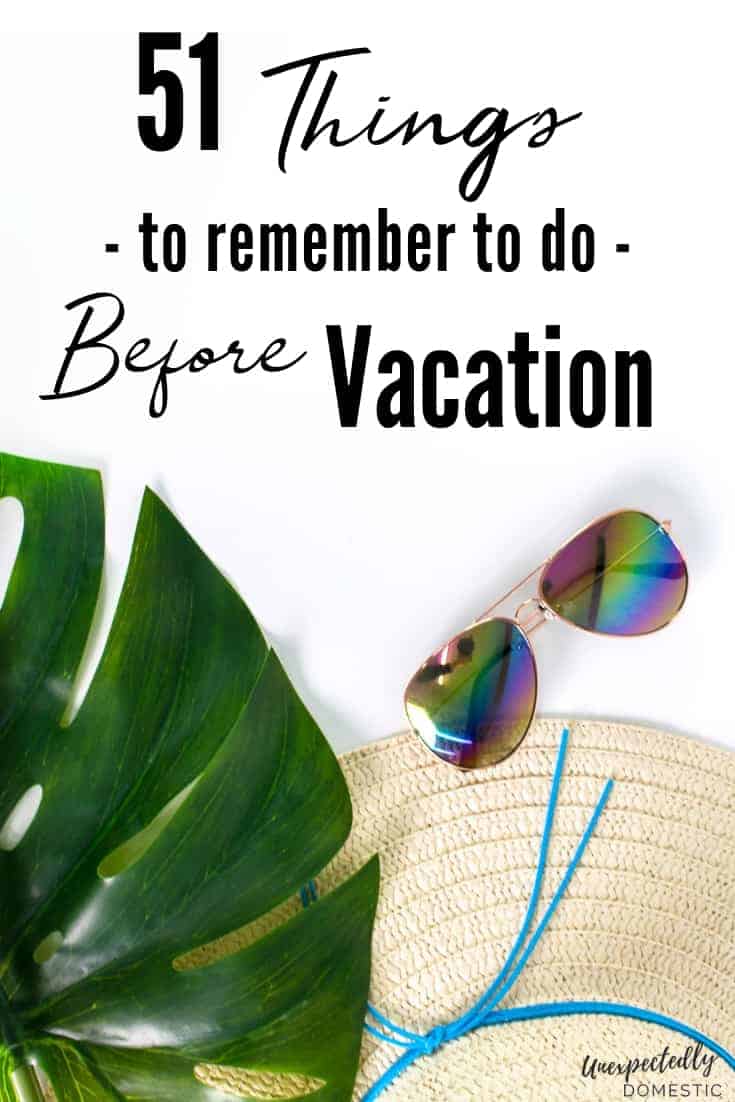
Do you have a fun trip planned?
Sometimes the day or week before going out of town can get pretty hectic!
You’re racking your brain, trying to think of all the things you need to get ready before leaving.
Here’s your answer!
Whether you’re preparing your house for an extended vacation, or leaving on a last minute trip, here’s a list of the things to do before vacation.
This vacation preparation checklist is broken up by what to do the week before, day before, and morning of leaving for your trip.
Be sure to grab your printable copy of the vacation preparation checklist at the bottom of the post!
This post may contain affiliate links. You can view my full disclosure policy here .
What to do 2-7 days before vacation
1. put in your request to have your mail held.
Or ask someone to pick it up for you while you’re away.
An overfull mailbox is a sure sign to robbers that your not home.
2. Put a hold on newspaper delivery
Does anyone get a physical newspaper delivered anymore?
If so, be sure to put a hold on yours.
You might be able to skip deliveries and save a little cash as well.
3. Stop ordering things online that might not come in time
The last thing you want is a bunch of packages on your porch when you’re not home.
4. Start eating up perishable foods
This will ensure that you don’t come home to a stinky fridge full of rotting food.
Also stop buying new perishables in the days before your trip.
5. Pay any bills that will be due while you’re gone
It’s such a peace of mind to know your finances are caught up.
You can avoid late fees and feeling behind when you return from your vacation.
6. Make arrangements for your pets
Call the kennel or ask a friend or relative to take care of your furry friends while you’re gone.
You may even want to do this earlier than a week in advance to ensure your sweet pets are taken care of.

7. Check your prescription medications
Get any necessary refills to make sure you won’t run out during vacation.
8. Load up on entertainment
Download ebooks or audio books (your trip is the perfect opportunity to try an Audible 30 day Free Trial , and receive 2 free books!), movies, music you’ll want to listen to.
Or visit the library!
9. Brainstorm packing list
Start writing a list of what you want to bring, and think about what your vacation outfits will be.
You’ll be able to pick up any items you’ll want to have on hand.
10. Check your supply of toiletries
This gives you time to pick up any travel sized items you’ll need for your trip.
Related: 75 Travel Essentials You Can Buy at the Dollar Store (+ free checklist!)
11. Double check the time of your flight and destination check-in
Things change a lot at the airport, so be sure to check and triple check the details.
12. Jot down a list of fun things you’d like to do at your destination
Check out the Visitor’s Bureau website of where you’re going to come up new ideas.
Have a ready-made list (or itinerary if you’re thorough) will ensure you’ll never get bored.
Be sure to include some rainy day options as well!
23. If traveling internationally, let your bank and credit card company know
This way they won’t be alarmed at foreign charges.
Many banks offer a travel notification form online you can fill out instead of calling.
24. Do any before-travel grooming or beauty activities
Gotta make sure those brows and feet look nice!

15. Make a copy of your passport, ID and the front and back of your credit cards
And keep somewhere safe, in case anything happens to your wallet.
16. Take a picture of your prescription labels
This way you’ll have all the relevant information, in the event that any of your bottles get lost or stolen.
17. Ask someone to keep an eye on your home while you’re gone
It’s so reassuring to have someone make a quick check to make sure the mail and newspapers aren’t being delivered, or that a pipe hasn’t burst or something.
Now let’s look at what you need to accomplish the day before your trip!
Things to do the day before vacation:
18. clean or tidy your house .
Nothing makes the end of a vacation worse than coming home to a messy house.
Tidy up, clean the bathrooms, wipe down kitchen counters, and you’ll feel so happy to be home when you return.
19. Throw away any food that will spoil
There’s nothing worse than a stinky fridge, so get rid of anything that won’t last.
Read next: How to Keep Your Fridge Smelling Fresh Naturally
20. Do your laundry
Make sure any clothes you want to pack are clean.
You’ll really thank yourself if you wash your sheets too!
21. Check in online for your flight
Do anything you can to avoid long waits at the airport.
Especially if you’re traveling with kids!
22. Check the weather report for your destination
Adjust your packing accordingly to the weather report.
Be sure to bring a jacket and umbrella if you have room, because you just never know.
23. Fully charge all the electronics you’re bringing
Including phones, tablet, laptops, bluetooth headphones, etc.
And be sure to pack their chargers and any appropriate adapters afterward.
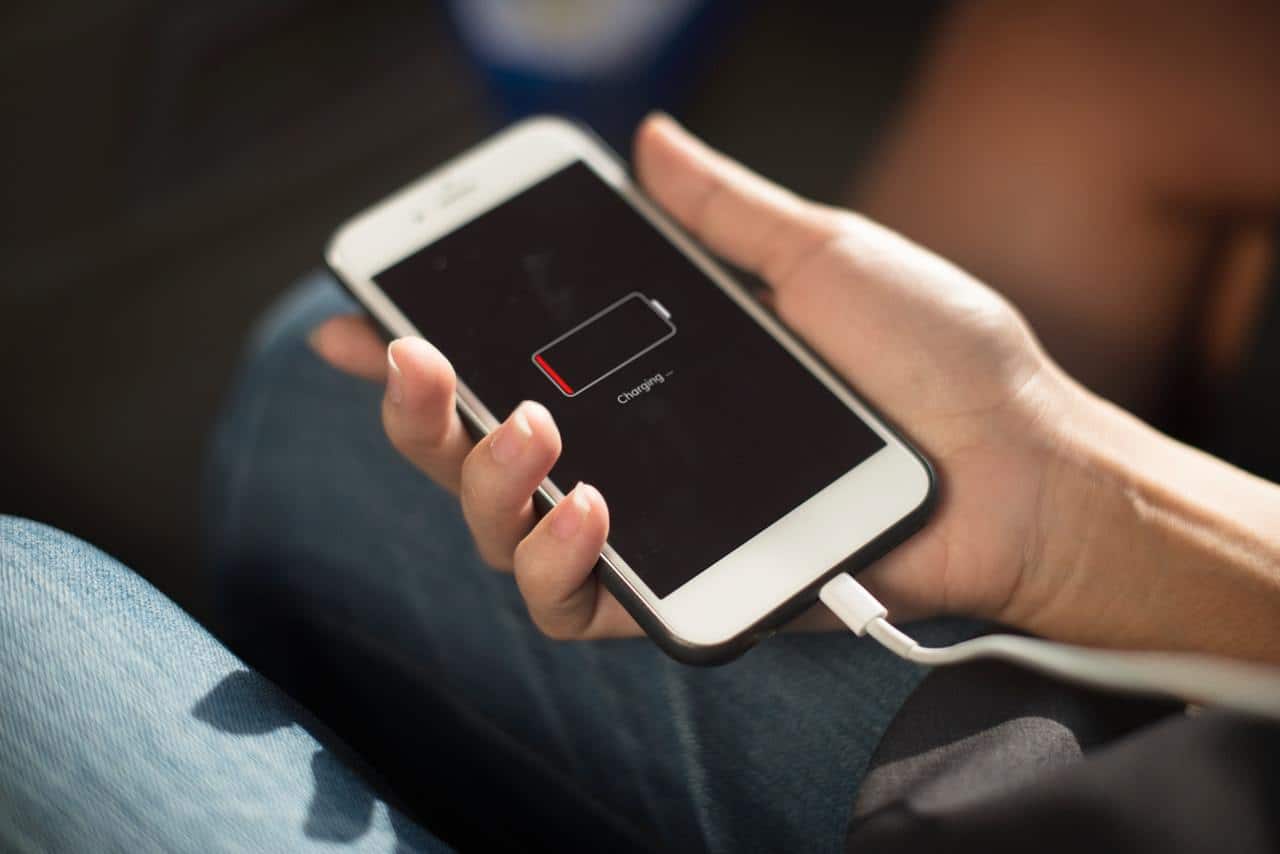
24. Stop at the bank for cash
You may want to get some small bills for tipping shuttle drivers and baggage carriers.
25. Get packed
Aside from last minute items, pack everything you can the day before.
26. Write yourself a note for last minute things to pack or do in the morning
You might think you’ll remember everything, but you probably won’t.
27. Do anything your pets might need
Pack their stuff if they’re staying elsewhere, or leave out extra food and water if they can stay home alone.
28. Remove anything from your wallet and purse that you won’t need
This lightens your load, and makes life easier if anything happens to your wallet while traveling.
29. Label or personalize your luggage if flying
Put a ribbon or sticker (or some easily identifiable personalization) on your suitcase so you can find it quickly on the conveyor belt. Just don’t put your phone number or address on it!
30. Hide your spare key
You could bring it in, or hide it better, so no one messes with it in your absence.
One of these fake rock key-hiders can come in handy, as long as you hide it well also.
31. Mow the lawn
Do any necessary yard work before you leave, so it stays looking nice.
If you’re going to be gone for a long time, hire someone to handle it while you’re away.

Now get a good night’s sleep. You should be tired from your busy day of vacation preparation!
Things to do the morning you leave:
32. empty trash cans in your house.
You’ll definitely appreciate empty, non-stinky trash cans when you return.
33. Do the dishes
Not to beat a dead horse, but coming back to a tidy house will help those post-vacation blues a little.
34. Make your bed
You’ll appreciate your own bed all the more if it’s made and ready for you to crawl into.
35. Pack any last minute toiletries and items from the note you wrote yourself
Don’t forget your medications and chargers!
36. Pack snacks
Bring snacks for the car or plane ride, so you don’t have to stop anywhere (and overpay), or get all cranky from hunger.
37. Make sure all the doors and windows in your home are locked
Be sure to include your garage or shed when locking everything up.
38. Water house plants
Give those plants one last water, unless you have a really trustworthy house sitter to take care of it.

39. Set timers for your lights
To make it look like you’re home when you’re not, put a lamp or two on timers .
And if you’re returning at night, it’s nice to come home to a couple lights on.
40. Lower or raise thermostat
Depending on what season you’re traveling, you’ll want to lower or raise the temperature at home to save money and energy.
41. Close all curtains and blinds
Not only does this help save energy on home heating and cooling, but it’ll ensure the looks-loos don’t peek in your windows and realize you’re not there.
42. Be sure that you have your ID and passport
Double and triple check that you have all the documentation you need to travel.
Multiple forms is preferable!
43. Double check all travel info
Make sure you have any tickets or passes you need to bring, and triple check that you have your phone.
44. Unplug unnecessary electronics
This will save on electricity, and lower the risk of fire.
45. Weigh your luggage if flying
Make adjustments accordingly to the weight limits of your airline.
It would stink to pay extra, or have to remove items at the last minute.
Next, this list wouldn’t be complete without a few tips for what to take care of at work before you leave town!

Things to do at work before vacation:
46. confirm vacation approval .
Make sure you turned in your vacation notice, and that it’s been approved!
47. Set up your away email message
Even if you plan on checking your email, this will make you feel less pressure about responding right away.
48. Wrap up any projects you need to finish
And don’t agree to anything new, if possible!
49. Let others know if they’ll need to handle things in your absence
The last thing you want is to come back to a bunch of neglected tasks that someone else could have taken care of.
50. Make a list of what to tackle upon your return
It’s so hard to remember where you left off when you come home from a trip.
Do your future self a favor and make a checklist.
51. Tidy up your desk
It will make going back ever-so-slightly less horrible. : )
Now go have fun!
I hope this list of last minute things to take care of before vacation gives you some reminders and peace of mind.
You can rest easy knowing that you’ve properly prepared your home and yourself for your trip.
Even though it can be a hectic time, it’ll be so worth the energy you took to take care of these details!
Sign up below to get your copy of the Vacation Preparation Checklist!
You’ll access to get access to tons of other printables that make taking care of your home, your finances, and yourself a little easier!
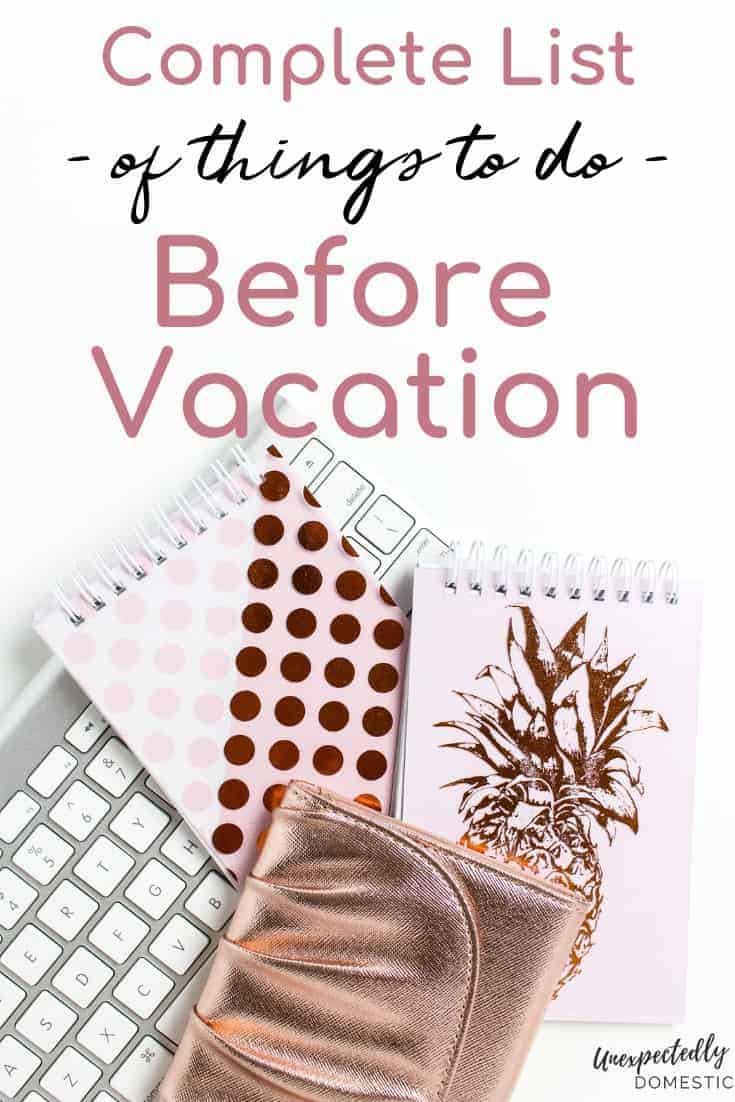
Similar Posts

65 Bright Spring Dessert Ideas to Sweeten the Season

Learn How to Be a Better Gift Giver with these 15 Easy Tricks

Printable Party Planning Checklist Template
Free Printable Christmas Gift Tracker

Decluttering Clothes: 5 Quick & Easy Steps to Downsize Your Wardrobe Today

5 Productive Steps to Overcome Overwhelm
Home » Vacations
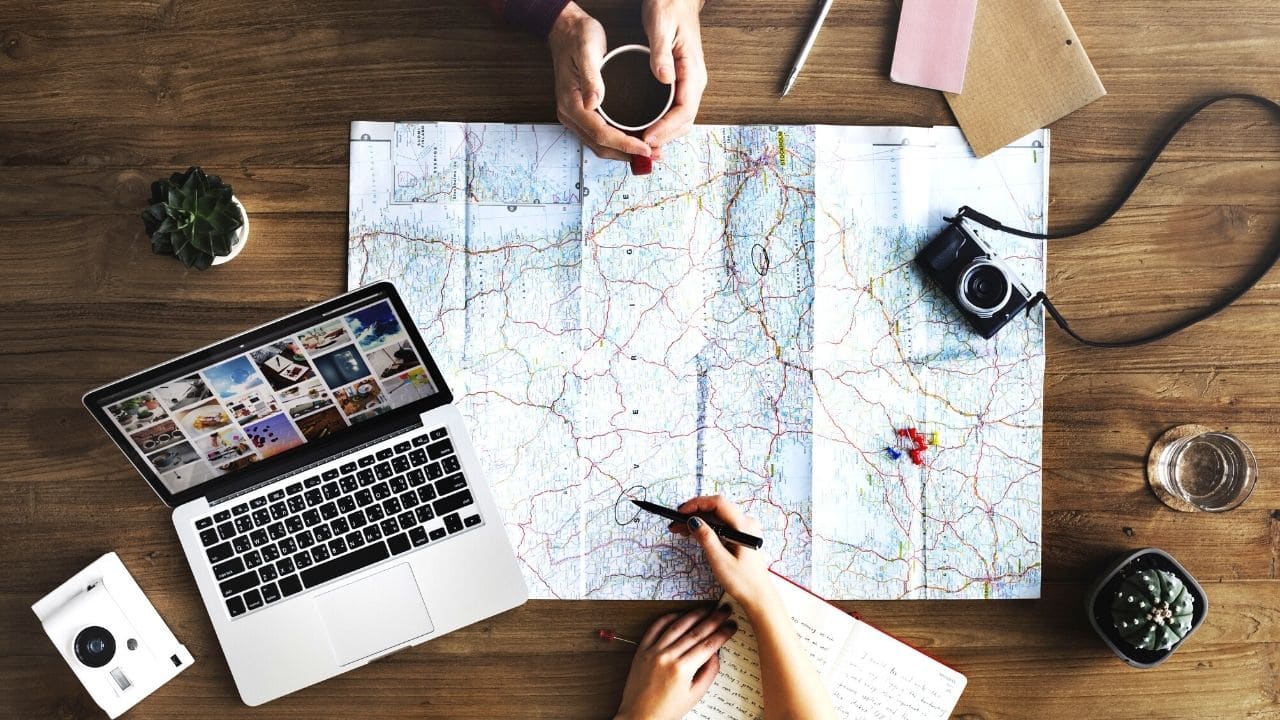
How to Plan a Vacation: 12 Tips for Planning the Perfect Trip
We all could use more vacations. That should go without saying. But as far as planning our next great trip goes, well, let’s just say sometimes we end up needing a vacation from planning our vacation.
And let’s face it, some of us have been out of the vacation planning game for a long time now.
Between travel restrictions, being married to work, or simply being a terrible planner, you’re here because you’re struggling to put together a solid plan for your next vacay.
But there’s no need to stress. We’ve put together 12 helpful tips to take you from troubled to triumphant and leave you with a foolproof plan for how to tackle your vacation planning one step at a time.
Table of Contents
1. choose your destination.
- 2. Pick Your Travel Partners
3. Determine Your Budget
4. decide when you’ll go, 5. research travel deals, 6. ask for time off, 7. find a great place to stay, 8. research the area, 9. plan your itinerary (or don’t), 10. get your documents in order, 11. decide on travel insurance, 12. minimize travel risks.
When planning a trip, the first step is one of the most fun … deciding where you want to go for your vacation. The options here are endless, from vibrant and energetic cities to magnificent national parks and palm-studded islands.
Whatever you’re looking for, you can find the perfect travel destination to make your dream vacation a reality.
It doesn’t even have to be a specific place to start. If you find yourself too spoiled for choice, try narrowing it down first by region to give yourself multiple destinations to choose from.
Suppose you know you want to have a boozy getaway in wine country. Then you can start narrowing down your travel destinations to include places like Napa Valley, Bordeaux, and Tuscany.
Or maybe you want a relaxing vacation in the tropics. Then you know you can cross off most of the continental US and start looking to places like the Caribbean for your ultimate getaway.
You don’t have to start off married to a specific destination just yet.
In fact, it may be better to start with only a vague idea instead.
This way, you can adjust your plans to allow for changes in your budget and your time-off schedule and score the best deals possible for your trip.
2. Pick Your Travel Partners
We’ve all heard the saying: “It doesn’t matter where you’re going. It’s who you have beside you.”
Well, when it comes time to plan a trip, that couldn’t be more true.
Trips—and how you plan them—are defined by the people who take them, from family vacations to epic bestie adventures.
Sometimes, other travelers aren’t a requirement at all.
Solo travel is on the rise, and more and more women are doing it by themselves , from planning a quick weekend trip somewhere close by to traveling abroad and visiting a foreign country solo.
And, of course, the answer to how to plan a vacation will differ immensely if you travel with family , plan a trip with friends, or even go it solo.
With a family, you may need a more disciplined plan, with precise itineraries for what you’re going to do and when. Whereas with friends or alone, you may be more inclined to go wherever your feet take you. You also may be less picky about where you stay and not mind traveling off the beaten path when something catches your interest.
These are all things to consider as you make your travel plans.
Now that you have at least a basic idea of the where, why, and who of your how-to-plan-a-vacation master blueprint, we can start talking budget.
This is usually the worst part of trip planning—at the very least, it’s in the top three.
Don’t worry, it isn’t nearly as bad as it sounds.
Okay, yes, this is the part where most of us have to start saving money and figuring out how much we need to afford our next trip and what that’ll cost in terms of time and effort. You have to start asking yourself questions like, will you need to work more hours, set aside more money each month, or cut back spending in other areas to afford your trip?
But most people think of their travel budget as an obstacle to their dream trip. Of course, there’s bound to be some bad blood in the mix if you think of it like that. Instead, think of your travel budget as the little piggy bank or money jar you kept as a kid.
Remember the incomparable joy you felt at adding more money to your stockpile, whether Christmas money, weekly allowance, etc.?
Think of your travel budget just like that piggy bank and know it’s going to need filling before you can start booking all your plans. Use that to incentivize your decisions and give you that little boost of joy as you put each dollar away, knowing the cause is a worthy one.
And this is where having a more general destination comes in handy, too, as you can plan a trip around your budget. Set on an escape to wine country but looking for a less expensive option than Tuscany? Maybe Napa Valley will do the trick instead.
When you’re going to go is almost as important as where because the timing can affect just about everything in the trip planning process, from how much money you spend to how you spend your time .
This is one of our key takeaways for how to plan a perfect vacation: travel during your destination’s shoulder season.
The shoulder season is that time between peak season and low season. And this sweet spot is the gift that keeps giving, with cheaper flights, lower hotel rates, smaller crowds, and more.
On the other hand, if you plan your next trip for a holiday or peak travel time, prepare for inflated prices and larger crowds. If it takes place at a specific time—like during a famous festival or peak tourist season—then start your planning process early .
Savvy budget travelers know that having a solid budget in place before you start your planning process is key to getting the best deals and saving money.
Two reasons.
- You want to look for specific ways to save money, not go overboard because you found “deals” that you didn’t want to pass up.
- It’ll be that much more satisfying to see how much money you save—and how much you come in under budget—from all the deals you nab during your travel planning.
Take advantage of countless online resources to help you compare prices and score the cheapest deals. Here are just a few to get you started.
- Google Flights – for comparing flight prices from multiple airlines
- Kayak – for finding cheap hotel room bookings
- Airbnb – for locating fantastic vacation rentals
While accommodations can take up a sizable portion of your budget, airfare tickets are arguably one of the most expensive parts of travel. To make matters worse, finding and booking flights can often be a nightmare.
If you want to be sure you never miss out on great flight deals in the future, try signing up for Next Vacay ! You may even find yourself with some new travel inspiration, as NV sends you all the best airfare deals to domestic and international destinations available right out of your home airport.
You can even book directly through the airline to use travel points for a discounted or even free flight!
With a budget in place, you can search for the deals that’ll keep you at your budget thresholds or below. So, when a great deal from Next Vacay comes in several hundred dollars under budget, you’ll know it’s one you won’t regret snatching up right away!
Get Secret Flight Deals
If you’re not planning this trip because you already have time off approved, schedule time in your calendar to speak with your boss or submit your time off request as soon as you’ve nailed down the dates you want.
Try not to schedule your request off during your busiest time at work or when you have a lot of unfinished projects awaiting completion.
The earlier you get your request in, the better positioned you are to have your time off approved. Then you can start cementing your travel dates and itinerary.
Also, make sure you get the confirmation of your time off in writing. This way, if something happens, you can refer your boss back to the written confirmation and dispel any confusion.
Booking accommodation for your trip shouldn’t be complicated. We touched on this a bit earlier when talking about how to score the best deals on your travel, but plenty of search engine websites exist to help you compare prices on accommodations and get the best rates. We recommend starting with a few at a time:
- Airbnb
- Booking.com
- Google Hotels or Google Vacation Rentals
- Hostelworld
Who you travel with could also affect your accommodation plans, so keep the needs of your travel group in mind.
Are you looking to stay in boutique hotels, secure a whole vacation rental for yourself, or simply book a single bed in a hostel? Do you need to make meals or wash clothes during your trip?
Approach how you plan a vacation with this mindset of asking questions to hone in on what will work best. This way, you ensure you’ll find something to accommodate your group and fit your travel budget.
There’s more fun to be had in your travel planning. One of our favorite parts of planning a vacation is detailing the trip! That means once you’ve gotten some of the particulars, like budgeting and finding deals, out of the way, you can start researching where you’re going!
This research can be as brief as or in-depth as you want. However, we always vote to do a bit more research than not here, especially if you’re visiting a foreign country. We can think of fewer things worse than finding out about an incredible sightseeing destination or local eatery on the last day of our trip. Trust us, it’s happened before, and it’s not fun.
Not to mention, doing some recon on your destination is a great way to drum up excitement for your trip. It can also help you iron out an itinerary—if you’re into those.
Here are some helpful travel tips to get you started:
- Look up famous sights or experiences at your destination (research travel blogs, recommendations from locals, and Google’s handy Things to do feature).
- Note the average length of any activities you’re interested in.
- Check out distances between activities and your lodgings (try checking out multiple locations with Google Maps).
Once you’ve got a list of things you’re interested in seeing and doing, you can narrow it down further. Consider this intro lesson 101 for the itinerary portion of our how-to-plan-a-vacation breakdown.
Start with the things you:
- Want to do most
- Fit in your budget
- Are easiest to get to
Then you can purchase tickets or time slots based on how busy you want your day to be and travel times between different attractions.
If you’re not the itinerary type, don’t feel like you have to be just to check this off your travel planning list.
Instead, try making plans for must-see attractions and purchase those tickets. Then leave the rest of your schedule free to wander down random streets, linger somewhere with a scenic view, or slip into other attractions that have same-day ticket slots open.
And for those by-the-book travelers, don’t stick to an itinerary at the cost of your enjoyment.
Just because you’ve planned to visit something one day doesn’t mean it can’t be moved around or struck from your itinerary entirely if needed. Sometimes, you just need a day to sit and do nothing but enjoy the fresh air or have a drink with a newly made friend.
Make plans, but don’t be afraid to break them.
Okay, now that you’ve gotten a chance to have some fun, it’s time to wrap up the last few details of your trip planning.
First and foremost, that means getting all your documents in order.
A quick and relatively painless way to make sure nothing gets left at home is to create a checklist for all your essential documents and confirmations:
- Passport or visa
- Drivers’ license/ID card
- Flight booking confirmation
- Accommodation booking/order confirmation
- Tickets to attractions
- Vaccination record or negative COVID-19 test result
- Travel insurance
The more digital options you have, the better, as that’s fewer physical documents to carry around. You’re also less likely to forget your phone on a major trip. But a checklist will do the job of making sure you get everything you need together, so you don’t have any last-minute panic attacks at the airport.
Travel insurance isn’t always necessary when you decide to hit the road. Still, it can help relieve some stress knowing that you’re covered if something happens before or during your trip.
Different types of travel insurance will ensure coverage in different situations, so it’s crucial to familiarize yourself with the primary forms of coverage available:
- Trip cancellation, interruption, or delay insurance
- Travel medical insurance
- Emergency medical evacuation coverage
- “Cancel for any reason” coverage
- Baggage and personal belongings
- Car rental collision insurance
You may find that some of these are covered already through things like your credit card, renters or homeowner insurance, or even your current health plan, so double-check before adding on the expense of travel insurance.
Keep in mind there are benefits and drawbacks to adding travel insurance to your trip, so give time to consider all of them and determine if travel insurance is right for you.
- Provides peace of mind
- Offers compensation for lost items
- Covers medical expenses
- Helps save money if something drastic does occur
- Can be expensive
- May not cover pre-existing conditions
- Claims could be rejected due to technicalities
Whether or not you need travel insurance will be up to you and if you’ll feel comfortable traveling without. Take the time to do your research and find out what you may already have covered!
At this point, we’re so close to being ready to fly you might be inclined to zip up your suitcase and call it a day. We’re almost there, we promise. Before you fly out, there’s just one last check you need to do in your travel planning: prepare for the worst.
It’s the last thing we want to imagine, especially on a trip abroad, but taking a few precautions ahead of time will doubtlessly save you lots of anxiety and dread should you run into trouble on the road.
So, how can you prepare for the worst when you’re not sure what the worst might be? Here are a few things you can do ahead of your travels to make sure you’re not caught unprepared.
- Sign up for the Smart Traveler Enrollment Program (STEP) – helpful for getting in touch with your local embassy and friends and family during emergencies
- Make copies of your essential documents – keep a physical copy of your ID and passport with you and keep electronic copies of documents like travel insurance, credit cards, etc.
- Research common scams – familiarize yourself with typical scams at your destination to avoid risky situations and tourist traps
- Inform your credit card companies you’ll be traveling abroad – ensure your credit card companies know you’ll be out of the country so your accounts aren’t frozen
- Bring backup credit cards – try carrying one card on you and leave another at your accommodations in the event one is lost or stolen
- Secure your valuables – ensure your valuables are locked up tight at your accommodations or kept in hard-to-reach places on your person to reduce the chances of theft
It’s never fun to imagine all the ways your trip might go wrong, but taking the time to make a few plans for what-if scenarios can help you avoid these situations during your vacation. And if they do still happen, you can minimize their impact on your travels and hopefully still enjoy what remains of your trip.
Which helps make all the planning, checklists, and scheduling worth it!
Related Posts


The Ultimate Travel Checklist: 9 Steps to a Stress-Free Trip
A step-by-step guide to making sure you don’t forget anything important in the rush to get out the door..
- Copy Link copied

Got your passport? What about travel insurance and compression socks?
Courtesy of Glenn Carstens-Peters/Unsplash
While some things, like booking flights and hotel rooms, are obvious to-dos before a big trip, other tasks—like remembering to double-check whether you need a visa or an international driver’s permit—sometimes slip through the cracks. That’s why having a pretravel checklist can make for a smoother departure and reduce stress.
Here are nine things you should do in the run-up to your trip and before you leave for the airport, from preparing your home and choosing a phone plan to packing the essentials.
Make sure your passport is up to date
While a standard adult U.S. passport is valid for 10 years from the date of issue (or renewal), you should renew sooner than that .
Many countries (currently around 75 worldwide) require at least six months of passport validity beyond your departure date. If your passport is going to expire less than six months after you leave for your trip, you could be denied entry or deported. Additionally, some nations require that your passport have between one and three completely blank visa pages, so be sure to check the rules for your destination .
Similarly, if your passport has details that are no longer accurate (for instance, you’ve gotten married and changed your last name), you’ll want to have that corrected or have your airplane ticket changed to match the passport information.
Check if you need a visa and immunizations
To enter certain foreign countries, you’ll need some specific visas and immunizations before you can board the plane.
Start by researching the entry requirements for your destination. Most governments have official websites or consular offices that provide detailed information about what is necessary to visit.
For visas, whether or not you need one often depends on your nationality and how long you plan to stay. Additionally, some countries have non-negotiable immunizations that need to be obtained before entry (for instance, a number of countries in Africa require yellow fever vaccinations and certifications ). Other countries may have suggested, but not mandatory, requirements for medications (such as antimalarial tablets). It’s a good idea to consult with a healthcare professional or travel clinic for up-to-date information on vaccinations and health advisories.
Consider travel insurance
No matter how well you plan your vacation, there’s always the potential for accidents and unforeseen circumstances that can derail everything.
Travel insurance can help safeguard you against unexpected events, like trip cancellations, medical emergencies, lost luggage, or flight delays. Not only does it mitigate financial losses, but it also ensures you have someone to help you if things go wrong far from home.
In some scenarios, like an expedition cruise to a polar region, the company organizing the trip makes travel insurance mandatory, so be sure to check what requirements your tour has ahead of time. Some cruise lines offer insurance directly through their booking process, which makes it an easier—if not always the most economic—option.
Keep in mind that credit card insurance covers some things, but not all, and that different cards cover different things. Cancel For Any Reason Coverage (CFAR) is another option in the insurance toolkit to review: It gained popularity during COVID and can still be useful in certain cases.
Even if you don’t end up needing your travel insurance, having it can provide peace of mind.
Make a safety plan for yourself
No matter your destination, it’s wise to familiarize yourself with local laws and customs, and to read up on potential safety concerns, particularly those related to current political and health situations specific to that area. The Department of State website is a good place to start, although it is usually quite conservative in its approach to safety issues. You might also consider looking online for blog posts about “important things to know before visiting (insert destination here)” to see what else pops up.
Be sure to share your itinerary with a trusted friend or family member so they know your whereabouts in case of emergency. Another option is to share your location with them via your phone, so they can keep track of you in real time. Signing up for the State Department’s Smart Traveler Enrollment Program (STEP) is another good idea. It is a free service for U.S. citizens and nationals who are traveling abroad, which allows them to input information about their trip (where they’re going, how they can be contacted, etc.), so that the State Department can help in emergencies (ranging from finding local attorneys and doctors to fleeing the country in the event of war or natural disasters).
Confirm whether you’ll need a special driving permit
Different countries have different rules and regulations when it comes to driving, and in some cases, the driver’s license issued by your home state doesn’t quite cut it. Depending on where you’re going, you may need an international driving permit instead.
Luckily, they’re easy to get . The Automobile Association of America (AAA) issues permits in their various offices countrywide and by mail for $20; all you need to do is submit a simple application, two passport-type photos, and a photocopy of both sides of your driver’s license. They’re currently valid in more than 150 countries. However, there are some countries, like China and Ethiopia, that don’t consider international licenses valid and instead offer their own temporary driving permit for travelers, so be sure to look up what the rules in your destination are. Websites for U.S. embassies in those countries and the Department of State can help in that matter.

Fliers will soon be able to use their phones to text, call, and stream videos in the air, in the same way, they would on the ground, at least within Europe.
Shutterstock
Choose an international phone plan (or plan for a different option once on the ground)
If you want to use your phone internationally , check to see if your current carrier offers international roaming options. If it doesn’t offer international data (or the cost is prohibitively expensive), consider purchasing a prepaid plan from a local carrier at your destination (though if you go that route, make sure your phone is unlocked and compatible with the local network). Often you can purchase local SIM cards at booths in the airport. You can also now buy eSIM cards (a digital version of a SIM card) online from companies like Airalo .
Note that some carriers, like Google Fi, offer automatic international service with no preauthorization or extra packages or SIM cards necessary, at the same price as in your home country.
Another option is to rent a Wi-Fi hot spot (available at phone stores for as little as $7 a day; or Travelers Wifi will mail you one). You could also just leave your phone in airplane mode and use free Wi-Fi when you can get it.
Prepare your home for while you’re away
You know the basics (taking out the trash, setting your thermostat, double-checking that all doors and windows are locked), but there are plenty of other steps to remember. Consider, for instance, unplugging any non-essential appliances to prevent energy waste and reduce the risk of electrical issues. While you may already know to empty your refrigerator of perishable items, do you always sweep and clean up any food crumbs that might otherwise attract pests? Also, if you can’t arrange for someone to care for plants in your absence, consider buying a self-watering device, like those from Cowbell Plant Co.
If you’re going on a longer trip , it’s also a good idea to forward your mail or ask a neighbor to collect it to avoid the appearance of an empty home; you can also arrange for the USPS to hold it . You might want to equip your home with camera security systems ( Ring and SwitchBot are solid options), so you can keep an eye on it while you’re away.
Download in-flight entertainment
Nobody wants to be stuck on a long-haul flight without something to keep them occupied. Sure, most airlines offer in-flight movies and TV shows, but there’s a chance the options don’t interest you (or aren’t in your preferred language). On the other hand, many streaming services allow users to download movies and shows for offline watching, so you can ensure you’ll have something you’ll enjoy.
It’s also a good idea to check with your specific airline to see if its in-flight entertainment service is available only through a personal device, which would require you to download an app before boarding (like United ).
Pack your bags
What you need to bring on a vacation depends in part on where you go, what the weather will be like, and what activities you have planned. But the following lists are a good starting point.
- Footwear (including hiking boots or water shoes ; our editor at large packs this boot on every winter trip)
- Socks (we’re partial to Bombas )
- Layers of cold-weather gear (remember that merino wool holds in heat, wicks away moisture, and is naturally antimicrobial)
- Jackets/outwear (outdoor gear companies are making progress in the plus-size category too )
- Swimwear and other beach necessities
- Hat (for sun or the cold)
Personal documents
- Hotel, flight, tour confirmations
- Insurance card and travel insurance contact number
- Documentation for any medication that might be controlled in other countries (e.g., Singapore has a list )
Electronics
- Chargers/adapters
- Earbuds / noise-canceling headphones
- AirTags if you’re checking a bag
- Travel apps that travel editors use
- Medications (keep prescriptions in their official bottles)
- Compression socks for the flight
- Packing cubes
- Water bottle
- Neck pillow
Packing lists
- The Essential Cruise Packing List
- The Ultimate Camping Checklist for a Comfy Night Under the Stars
- What to Pack for a Road Trip
- The Ultimate Beach Packing List
- The Ultimate Ski Trip Packing List

- PRO Courses Guides New Tech Help Pro Expert Videos About wikiHow Pro Upgrade Sign In
- EDIT Edit this Article
- EXPLORE Tech Help Pro About Us Random Article Quizzes Request a New Article Community Dashboard This Or That Game Popular Categories Arts and Entertainment Artwork Books Movies Computers and Electronics Computers Phone Skills Technology Hacks Health Men's Health Mental Health Women's Health Relationships Dating Love Relationship Issues Hobbies and Crafts Crafts Drawing Games Education & Communication Communication Skills Personal Development Studying Personal Care and Style Fashion Hair Care Personal Hygiene Youth Personal Care School Stuff Dating All Categories Arts and Entertainment Finance and Business Home and Garden Relationship Quizzes Cars & Other Vehicles Food and Entertaining Personal Care and Style Sports and Fitness Computers and Electronics Health Pets and Animals Travel Education & Communication Hobbies and Crafts Philosophy and Religion Work World Family Life Holidays and Traditions Relationships Youth
- Browse Articles
- Learn Something New
- Quizzes Hot
- This Or That Game New
- Train Your Brain
- Explore More
- Support wikiHow
- About wikiHow
- Log in / Sign up
- Planning Travel
How to Plan a Trip
Last Updated: January 29, 2024 Approved
This article was co-authored by Amy Tan . Amy Tan is a Travel Planner and the Founder of Planet Hoppers, a boutique travel design team founded in 2002. Planet Hoppers specializes in brainstorming and creating itineraries for dream vacations, honeymoons, exotic adventures, family reunions, and group trips. Planet Hoppers is a TRUE accredited travel agency and a member of the Signature Travel Network, the Cruise Lines International Association (CLIA), and Travel Leaders. Amy earned a BA in Communications and a BS in Physics from the University of California, Davis in 2000. There are 8 references cited in this article, which can be found at the bottom of the page. wikiHow marks an article as reader-approved once it receives enough positive feedback. In this case, 94% of readers who voted found the article helpful, earning it our reader-approved status. This article has been viewed 552,137 times.
Before planning a trip have a current passport. Purchase traveler's checks. Keep the receipt in a safe place in case of being stolen. Whether for travel or pleasure, schedule some fun. All trips are meant for adventure, relaxation, and enjoyment. By planning well, you can ensure you that you and your family or friends can enjoy a hassle-free trip with only the good kind of surprises to ensue.
Planning Help

Choosing the When, Where, and How

- Keep in mind weather and climatic conditions, merits and demerits of the place, types of recreation (beaches, culture, shopping), and facilities (transport, eating out, etc). What clothes are suitable? How removed from civilization will you be? What does your destination require?

- Do you want to go during the off-season or while tourism is booming? The off-season will offer discounts, but it will also mean closed doors and reduced availability.
- When it comes to weather, do you want to deal with winter or the rainy season? How about when it's hot and muggy?
- And then there's ticket prices – if you're flying, when is it the cheapest to fly? If you are planning to fly on a long weekend , then you should book the tickets well in advance to get the best deal.

- Make a list. Write down the places you want to visit, including restaurants, museums, malls, and other places of interest. This will help give you ideas and prevent being completely lost when you arrive and do not know what to do.
- Include how you're going to get around. Does your itinerary involve cab rides? Using the subway? Trekking on foot? If you are taking public transportation, make sure you know how that's done wherever you're going.

- Companies that help you in the actual "planning" phase of your trip, would be like Gap Travel Adventures, Get A Trip.com, the Automobile Club of Southern California Travels Division (and their counterparts in each of the 50 States), and the American Express Corporation, whereas the giant travel conglomerates, such as Expedia, Travelocity ,Orbitz.com and Priceline (the 4 largest travel vendors in "gross profits" within the United States), aim at the end booking process.
- The five things you can do to help yourself and your budget (that you don't need a travel agent for) are the following: 1) Book your flight and hotels at the same time, not separately 2) Be willing to fly mid-week and off-hours 3) Be willing to fly or land at a neighboring airport within 30 miles (48 km) of each other 4) Pay an all-inclusive price when possible, so that meals and gratuities are included, and 5) The actual season you travel – i will differ the rates by 30-40%.
Figuring Out the Logistics

- Always add some wiggle room, overestimating rather than underestimating. There are always costs you don't foresee or things you want to do that you haven't accounted for.
- If the trip is more than you are willing to spend, make cuts where you can. If it ultimately means cutting the trip short, so be it.

- Ditch that daily sugary latte. If you get a $4 coffee drink three times a week, that's $12 a week, and about $50 a month. That's $300 in six months right there.
- Eat from home more. Restaurants are great, but they're expensive. If you cook at home, you can save money not only because it's cheaper, but because you'll have leftovers that can last you days.
- Quit the luxuries for a while. That last drink on Saturday night? Pass. A movie next week? Nope. Heck, cable? Who needs it when you have Netflix? Take a look at what little things are fun, but that you could live without.

- It is said that you should book airfare around two months out for the best deals – this is that happy place where airlines start discounting their trips to sell tickets, but haven't yet jacked prices up because they're last-minute.
- If you're going somewhere that speaks a different language, take the time to brush up on the basics. You'll be glad you did, and the people you interact with will be, too.

- Many airlines also pair with major retailers, like Target, Amazon, and Apple. If you buy from those stores, you get miles. What's not to like? You're shopping there anyway – you might as well get a free flight for it.
Setting Your Plans in Stone

- And anything else for that matter, too. Many attractions have ticket sales online where you can skip the lines and go right in. Sure, the idea of waiting in line right now doesn't sound so bad, but for three minutes of work right now you can not waste hours of your vacation standing in a line with strangers wishing past you would've had better sense.

- Only you know if you are one of these people that changes their mind often, or often does re-scheduling – or if you are one of these people that will fly out in a hurricane, no matter what!

- Keep your passport, travel documents, visas, and similar items in a safe pouch. You may want to make copies, too, and keep them in a safe place. It will make it so much easier to replace anything that you lost.

- If applicable, put vacation notices on your e-mail, and remember to set your answering machine. Those messages will just have to wait until you get back.
Wrapping Up the Details

- Traveling in a car? Make sure to get lots of foodstuffs, water, and things to do. A CD on tape about a road trip or your specific destination will be great to get you in the mood. Consider "On the Road," " Lost in My Own Backyard," "A Walk Through the Woods," or "Washington Schlepped Here," amongst others. Good music is a must, too.

- Stick to basic pieces and a couple pairs of shoes – it's really all you need in terms of clothes regardless of how long your trip is. A few basic shirts and a few basic pants, shorts, or a skirt will do the job. You can then mix and match as necessary.
- Roll your clothes when packing. This will save you a ton of room and mean you can buy that authentic-looking tiki torch when the mood strikes.
- Create and use a checklist for packing, which helps consistently remind you of all the odds and ends of packing. You don't want to arrive at the airport and remember you forgot the needed documents at home.

- Don't be tempted to take work or home problems with you – then all this planning will be for naught, making it feel like you're still mentally back home. Leave that laptop and your phone off – now is all about exploring and going on an adventure.
Expert Q&A

Reader Videos
- If planning a trip on a severe budget is your number one priority, there are literally hundreds of money saving tips for the actual daily travel plans, that can save you in the hundreds if not thousands of dollars. Thanks Helpful 0 Not Helpful 0
- If peer reviews are more important than shopping by rates, than websites like Trip Adviser.com and some of the top ranked travel blogs, like with Budget Travel and Travel Zoo.com all have stellar reputations for providing unbiased reviews. In Europe, a similar counterpart would be found within Auto Europe.com (full service European travel vendor, not just cars) The Asian markets probably have the widest variety of travel providers. The only reason mentioning names is relevant, is according to Forbes Research many of the other smaller affiliate travel resources have been known to delete from their databases the low-25% of the negative reviews, thus obstructing true peer review analysis. This does not mean however, that one should not consider one of these smaller travel affiliates, though one should do their research and due diligence on that company's trust factor. Many have value-added services the larger companies do not have. Thanks Helpful 0 Not Helpful 0
- Start learning the language of the country you are going to if you are traveling overseas. Thanks Helpful 0 Not Helpful 0

- Don't keep sharp objects in your luggage. Security has been greatly beefed up, and your luggage may be checked. Thanks Helpful 4 Not Helpful 0
- Traveling can be hectic. If traveling to a new place, make sure you keep medication (especially for children). Keep your documents and precious possessions safe. Mugging and theft is common. Thanks Helpful 5 Not Helpful 1
You Might Also Like

- ↑ https://www.theglobetrottingteacher.com/how-to-successfully-choose-your-travel-destination/
- ↑ Amy Tan. Travel Planner. Expert Interview. 12 March 2020.
- ↑ http://www.seat61.com/spreadsheet.htm#.VBx5XvldUss
- ↑ https://www.lonelyplanet.com/travel-tips-and-articles/how-to-budget-for-a-big-trip/40625c8c-8a11-5710-a052-1479d2772aa0
- ↑ http://www.nomadicmatt.com/travel-blogs/planning-a-trip/
- ↑ http://www.nomadicmatt.com/travel-tips/how-to-find-a-cheap-flight/
- ↑ https://www.travelpulse.com/news/features/the-importance-of-travel-insurance-3.html
- ↑ http://www.roadtripamerica.com/tips/How-To-Plan-A-Great-Road-Trip.htm
About This Article

To plan a trip, start assessing your costs by determining where you will stay, like a hotel or a hostel. You should also go online and compare flight prices a couple months in advance for the lowest rates. Additionally, be sure to consider ways of getting around your destination, like rental cars or subways, based on the place you’re traveling to. If you’re traveling internationally, get your necessary documents in order 6 months in advance, like a passport and travel visa, and keep them in a safe place. For more tips on planning a vacation, like how to make a budget, keep scrolling! Did this summary help you? Yes No
- Send fan mail to authors
Reader Success Stories
Angela Heart
Apr 20, 2017
Did this article help you?
Sep 2, 2016
May 5, 2016
Benjamin Hsieh
Alex Walker
Nov 15, 2019

Featured Articles

Trending Articles

Watch Articles

- Terms of Use
- Privacy Policy
- Do Not Sell or Share My Info
- Not Selling Info
wikiHow Tech Help Pro:
Develop the tech skills you need for work and life

- Meet the Team
- Work With Us
- Itineraries
- Italy Travel Guide
- Hawaii Travel Guide
- Travel Tips
Travel Preparation: How to Plan for the Perfect Vacation
Travel preparation? It sounds like work to prepare to go on vacation, right? After doing all the planning and itinerary building , you’d think the only thing left to do would be to go, right? You’re eager to leave work behind, get unplugged, and get to the airport to start your much-needed and deserved vacation abroad.
But don’t rush off before making a few very important travel preparations first. These extra steps could save you time, money, and even a few headaches.
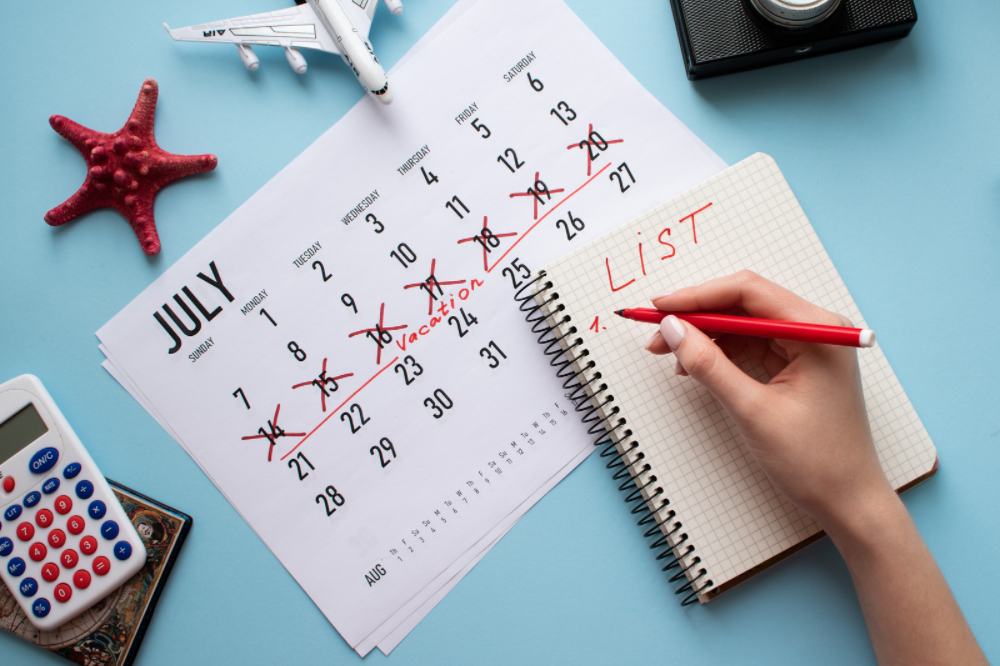
Taking the time to properly prepare will inevitably lead to a more satisfying and relaxing vacation. Each time we leave for a trip, we run through the same preparation checklist to make sure we’ve covered all our bases and aren’t forgetting something important.
Below, you’ll find the list that we follow. It’s not incredibly tedious and it will give you a better peace of mind while you’re getting ready to go.
Be Prepared For Travel Planning is the most important part of any successful trip. Do it the easy way:
🧳 Travel Packing List | ✔️ Why You Need Travel Insurance | ✈️ What to Do Before You Leave Home
- Find and book the best hotel (our favorite booking site is Expedia)
- Research flight options (our favorite tool is Skyscanner )
- Book a tour (we always use Viator to find the best tours)
- Rent a car through Discover Cars (they search the best deals for you!)
Table of Contents
Travel & Trip Preparation for Your Getaway
Travel planning checklist.

When you sign up for our newsletter , you’ll get a FREE reusable packing checklist that will help you remember everything.
Up to One Month Before
- Go over your plans again to make sure there aren’t any missing pieces — have you booked all your hotels , car rentals , transfers, and dinner reservations?
- Call or email all tour companies to reconfirm excursions and double-check times and pick-up locations.
- Give a copy of the first page of your passport to someone back home, along with your itinerary details. Also keep a copy in your carry-on bag , separate from your actual passport, in case it gets lost.
- Buy a travel guide and map for your destination. Read through and circle or highlight important information.
- Research and pack the proper adapters for the country you’re going to.
PRO TIP: Figure in buffer time. Don’t work right up until the minute you leave or arrive home the night before you return to work. Leave yourself a buffer on both ends. It’s a real relief to have an extra day before heading back to the office so you can ease back in, adjust from jet lag, and do an advance cleaning out of your email inbox before being slammed with work.

One Week Before
- Get any COVID tests, fill in our passenger locator records, and check all regulations and rules for your destination.
- Sign up online at USPS.com to have your mail held by the post office. Suspend paper delivery.
- Download any entertainment you might want onto your tablet, computer, or Kindle for the plane ride trip or beach reading.
- Pay or schedule all bills that might be due while you’re away.
- Clean out the refrigerator. There’s nothing worse than coming home to a smelly house.
- Prepare meals that use up the last fresh food in your fridge.
- Transfer money into your checking account. Sometimes money in a savings account can’t easily be accessed through an ATM.
- Withdraw the cash you’ll need during your trip if staying in country. You can also pre-calculate how much you might need in foreign cash, so you’re prepared to pull out money when you arrive.
PRO TIP: The easiest and cheapest way to get cash in a foreign country is to use the ATM at the airport. Just be sure you’ve alerted your bank that you’ll be traveling overseas.

A Few Days Before
- Arrange for someone to water your plants.
- Find boarding for your dogs or find someone to come over and feed your cat . You can also purchase an automatic cat feeder for shorter trips.
- Begin to pack your bags, taking care not to overpack. Here’s our guide on packing light . Everything should be packed and ready to go at least two days before you leave. This will give you time to remember any items you’ve left out or to rethink unnecessary items.
- Print out or save all of your important travel documents, including flight, hotel, and car confirmations, details for excursions, plus driving or walking directions you’ll need.
- Clean the house and do the laundry so you’re not overwhelmed by it when you return.
- If you live in a city with grocery delivery, order ahead for delivery the day you arrive home, so there will be food in the fridge..

One Day Before
- Pack snacks and/or a sandwich for the plane ride.
- Reconfirm your ride to the airport. Make sure you’ve left plenty of time so you’re not rushing and stressed about missing your flight departure.
- Get a good night’s sleep before the trip.
- Turn off all appliances. Be sure to unplug your air fryer and Instant Pot , if they’re sitting out.
- Turn off or down heating or air conditioning.
- Leave an away message on your work and home emails and phones.
- Check in for your flight.
- Print boarding passes, or download an online boarding pass to your phone.
- Confirm that your seat assignments haven’t changed (i.e. make sure you’re still sitting together)
- Take out the trash.
- Try to turn off your phone and go unplugged at least 2 hours before you leave for the airport to avoid unnecessary distractions and stressors.
PRO TIP: If you check in the moment it becomes available, you may be able to get better seats, or pay a small amount for premium seats — always double check the seating chart.

During Your Vacation
- First and foremost: Remind yourself that you’re on vacation . There will inevitably be things that go wrong, but you won’t let them ruin your mood because YOU’RE ON VACATION!
- Check out our list of beach drinks to order at all inclusive resorts.
- Stay unplugged. Is there really any need to update your Facebook and Twitter every minute? If you must, keep it to 30 minutes per day.
- Out of sight, out of mind. If something is happening back home or in the office, there’s nothing you can do about it now, so don’t let home problems creep in and destroy your relaxation.
- Save the best activity for last. You’ll be so busy looking forward to that last activity that you won’t have time to dread the going home part.
PRO TIP: If you suffer from jet lag, follow these tips to minimize the effects. Ease back into your schedule. You can easily get back to normal by adjusting your bedtime by 15 to 30 minutes each night. See how to detox from your vacation when you return.

Travel Insurance for International Travel
Travel insurance isn’t just for long or expensive trips. It’s there to help you if something unexpected happens, even on short trips. With travel insurance , you can feel secure knowing that if you have a medical emergency, you’ll get the help you need for your health, like medical treatment or evacuation.
Whilst international travel insurance isn’t cheap, and can end up being quite pricy there are times when it can definitely come in handy and other times when it could save you from financial ruin. Travel insurance can also provide additional advantages for lost luggage or trip disruptions like delays so you are prepared just incase.
Many travel insurance plans offer round-the-clock support, including a helpline to assist you with emergencies or travel-related issues wherever you are, which provides peace of mind if you are taking a long international trip.
Frequently Asked Questions on Travelling and Packing
How can i avoid overpacking for my trip.
To avoid overpacking, make a packing list, choose versatile clothing items that can be mixed and matched, and pack items that serve multiple purposes. Be realistic about what you’ll actually need and leave unnecessary items at home. Be sure to research your accommodation as they might have items there that you won’t need to take with you.
Are there any packing tips for traveling with children?
When traveling with kids, pack snacks, entertainment (books, games, or electronic devices), for the trip, and any essential items like diapers, baby food, or medications. Keep important documents, like passports, within easy reach.
What should I do if my luggage is lost during my trip?
If your luggage is lost, immediately report it to the airline and provide a detailed description of your bag. Keep important items like medication, a change of clothes, and essential documents in your carry-on to tide you over until your luggage is found or replaced.
How can I prevent wrinkled clothes when packing?
To prevent wrinkles, roll your clothes instead of folding them. You can also use packing cubes or plastic bags to separate and compress clothing items. Consider packing wrinkle-resistant fabrics if available.
What should I do if I have issues with my accommodation during my stay?
If you have problems with your accommodation, such as cleanliness issues or noisy neighbors, start by addressing the issue with the hotel or host this usually will always resolve any issues.
Preparing for a vacation trip can be very daunting and you might be tempted to leave everything to the last minute, which will just stress you out more. Use this helpful guide to plan ahead and have a peaceful, stress-free vacation.
YOU MIGHT ALSO LIKE
![Ultimate Beach Packing List [+ Free Reusable Checklist] 1 beach packing list](https://www.savoredjourneys.com/wp-content/uploads/2020/11/beach-packing-list-featured.jpg)
Ultimate Beach Packing List [+ Free Reusable Checklist]

50 Things to Know Before You Go Abroad
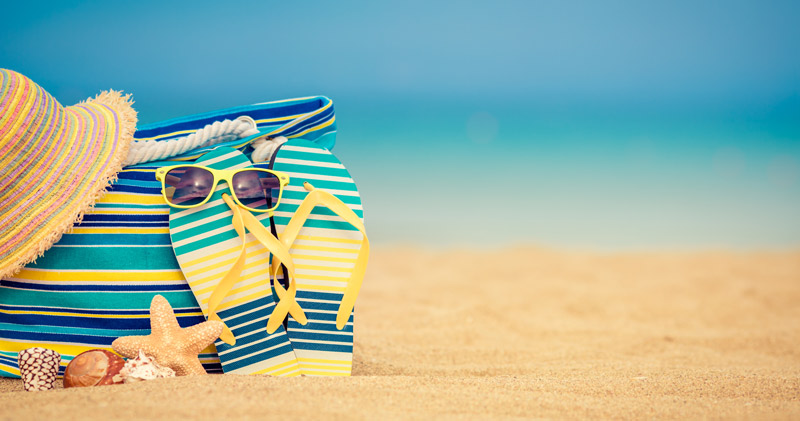
Ultimate Summer Europe Packing Guide
Like this post? Save it for later or share it on Pinterest by clicking the PIN button. We appreciate it when you share our content with your friends on social media!

Laura Lynch, creator and writer of Savored Journeys, is an avid world traveler, certified wine expert, and international food specialist. She has written about travel and food for over 20 years and has visited over 75 countries. Her work has been published in numerous guidebooks, websites, and magazines.
20 thoughts on “ Travel Preparation: How to Plan for the Perfect Vacation ”
Make sure that is everything is well planned from Flights, Hotel accommodations or place for you to stay, cash and credit cards and don’t forget to bring along a dictionary if you are traveling to a country with different language.
Very true, Rosemary! We always have Google Translate within reach!
Wonderful! !!!! So so helpful! Thanks so much!
In addition to the great comments above, tell a neighbor your travel dates. They can help watch your home while you are gone. Also, turn off the water to your washing machine. The hose is under pressure from the water and you don’t want that breaking and pouring water all over while you are away. I would not recommend leaving an away message on your home phone. Your friends and work know you are traveling. Anyone else calling may just be trying to find out if someone is home or not! Put lights on variable timers so they go on and off at different times during the day/week. Have them start a few days before you depart (aka while you are still home) so anyone watching your home would not know if you are actually home or have left the residence. If you live in a snowy climate, make arrangements to have your driveway shoveled if needed to make it look like you are home. Have neighbors park in your driveway now and then while you are gone too. Taking steps before you leave will make for a worry free trip.
Thanks for your tips, J! These are great.
You get so busy planning your trip that it can be easy to forget about your home. I agree with J that you should make sure someone is watching your house while you are gone. If you don’t know or trust your neighbors, you can probably hire a service or a security company to check on your house while you enjoy your vacation.
It sure was nice when you said that during the vacation, it is best to take the mind off the house and the office and just focus on relaxing and having fun. That is especially true if the family has chosen such a wonderful vacation rental to spend their vacation in. We haven’t chosen yet, but I will still take note of this advice because I want to make the most out of my vacation. Thank you!
It’s a difficult decision, but you should love where you stay, so also a very important one.
It was helpful when you suggested reconfirming the ride to the airport the day prior to the trip so that the person can avoid unnecessary problems that may cause them to miss their flight. I will be sure to call the transportation company again tomorrow morning because my brother and I will be traveling to the Dominican Republic for our vacation. Of course, we want to make sure that to and fro, we won’t have any issues whatsoever. Thanks!
Very good idea, Dino.
Check with the CDC and make sure you don’t need to have shots where you’re going . You can pull them up online.
Great tip, Ginny. Thanks.
Even better than keeping the cell usage to 30 minutes a day, try to make those 30 minutes WiFi only. If you need a reminder to make sure that you don’t get a surprise $1000 cell bill, download a reminder App like Hoogo – On the Move Alert.
Thanks Audrey
I would add that at a week out you should double check any medications that you are taking. If you will be close to needing a refill, it is best to do so in case of flight delays, etc. you don’t want to run out!!!
Great article!!!
That’s a very good point. I’ve been caught without a few times myself.
I have a lot of friends who love to travel, and I was looking for a nice article which describes what a perfect checklist for a trip should be. Love it thanks.
Awesome! Travel tips is a really amazing , it gives me a very clear idea about travel.
It’s great that you explained how to plan a vacation and what to do one month before your trip. My wife and I are excited to travel for our summer vacation, but we have no idea where to go or what activities to do, so we think we’ll start looking for fun things to do while we read your tips. Thanks for the advice on preparing your tour and excursions and verifying their confirmation with anticipation.
Having a plan at least one month before going on a hotel vacation is an idea that really makes sense to me. You would want to make sure that you know what you want to do and have a good idea of the location first before you go so you don’t waste time getting lost. I’ll make sure that this is something I prepare beforehand so I’m ready to book a hotel & lodging close to where I want to hang out.
Leave a Reply Cancel reply
Your email address will not be published. Required fields are marked *
Save my name, email, and website in this browser for the next time I comment.
- Travel Resources
Get Daily Travel Tips & Deals!
By proceeding, you agree to our Privacy Policy and Terms of Use .

The Essential Pre-Trip Checklist
Caroline Costello
Caroline Costello's travel accomplishments include surviving a 2 a.m. whitewater rafting excursion in the Canadian wilderness, successfully biking from Dusseldorf to Cologne without a map, and gaining access to a covert pizza speakeasy in New Orleans.
Caroline is an active member of the Society of American Travel Writers (SATW). Her work has appeared on USA Today , the Boston Globe , AOL.com, MSNBC.com, ABC News, TODAY Travel, and CruiseCritic.com, among other publications.
Travel Smarter! Sign up for our free newsletter.
For a stress-free, tranquil trip, preparation is key. If you’re getting ready to go on vacation, download our pre-trip checklist to help you take care of the essential tasks before embarking on your getaway. This customizable and editable chart includes everything you’ll likely need to do before heading out the door, from arranging pet care to taking care of finances. Download the list and add in any extra preparations you might need to complete—and you’ll be well on your way to a worry-free adventure. NEW: Download a mobile-friendly version of the pre-trip checklist.
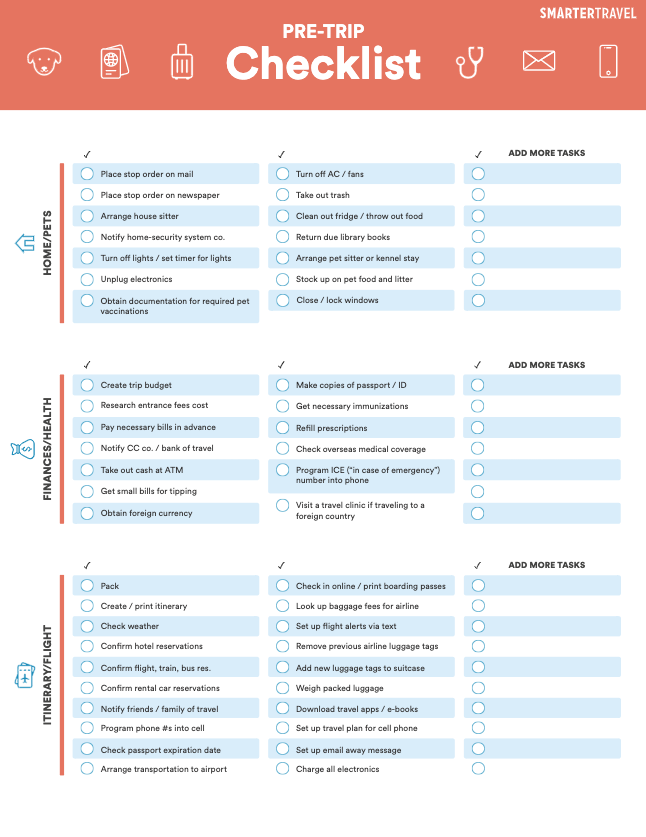
Pre-Trip Checklist for Home/Pets
- Turn off AC/fans
- Take out trash
- Clean out fridge/throw out food
- Return due library books
- Close/lock windows
- Unplug electronics
- Turn off lights/set timer for lights
- Notify home-security system co.
- Arrange house sitter
- Place stop order on newspaper
- Place stop order on mail
- Stock up on pet food and litter
- Arrange pet sitter or kennel stay
- Obtain documentation for required pet vaccinations
Pre-Trip Checklist for Finances/Health
- Visit a travel clinic if traveling to a foreign country
- Program ICE (“in case of emergency”) number into your phone
- Check overseas medical coverage
- Refill prescriptions
- Get necessary immunizations
- Make copies of passport/ID
- Notify CC co./bank of travel
- Pay necessary bills in advance
- Research entrance fee costs
- Create trip budget
- Take out cash at ATM
- Obtain foreign currency
- Get small bills for tipping
Pre-Trip Checklist for Itinerary/Flight
- Look up baggage fees for airline
- Add new luggage tags to your suitcase
- Download travel apps/e-books
- Set up away message
- Set up flight alerts via text
- Weigh packed luggage
- Set up a travel plan for cell phone
- Charge all electronics
- Remove previous airline luggage tags
- Check in online/print boarding passes
- Confirm rental car reservations
- Confirm flight, train, bus reservations
- Confirm hotel reservations
- Create/print itinerary
- Check weather
- Notify friends/family of travel
- Check your passport expiration date
- Program phone numbers into cellphone
- Arrange transportation to the airport
More from SmarterTravel:
- The Essential Beach Packing List
- 10 Things You Should Never Pack in Your Checked Bag
- 10 Things to Pack That Will Save You Money
Editor’s note: This story was originally published in 2012. It has been updated to reflect the most current information.
We hand-pick everything we recommend and select items through testing and reviews. Some products are sent to us free of charge with no incentive to offer a favorable review. We offer our unbiased opinions and do not accept compensation to review products. All items are in stock and prices are accurate at the time of publication. If you buy something through our links, we may earn a commission.
Top Fares From

Don't see a fare you like? View all flight deals from your city.
Today's top travel deals.
Brought to you by ShermansTravel
Madrid to Malaga: 8-Nt Southern Spain...

Luxe, 12-Night Spain, France, Monaco &...
Regent Seven Seas Cruises

Ohio: Daily Car Rentals from Cincinnati

Trending on SmarterTravel

How to Prepare for a Trip: Essential Steps to Take Before Your First Travel Experience
Planning for a trip can be overwhelming, and even if you prepare all the necessary aspects ahead, there is still some great chance of something going wrong: some flight delays, payment problems, or simple miscommunication with the local service providers. An experienced traveler is ready for everything, but if this is your first time traveling, your planning must be most cautious.
While sometimes the unexpected can be good, like when you spot a whale on your boat tour or stumble upon some free local festival on your way, it may also be downright frustrating, like when you miss your flight home or get your reservations lost or mixed up in a system. To try to avoid unpleasant surprises, be sure to follow this list of essential steps while you plan your very first adventures.
1. Book Your Flights in Advance
The first step in planning your trip is booking your flights. This will help you get an idea of how much your entire trip will cost. Compare flight offers and keep a list of important details, including departure and arrival airports and times, fees, and cancellation policies.
You can find some flight deals online or use a travel agency or airline app to book your flights. Once you’ve done this, it’s time to start researching your other valuable aspects, like accommodation options, transportation, and the activities you plan to do. And don’t forget to free your schedule for the trip by using a free essay writer service or any help from your coworkers and relatives.
When traveling internationally, choosing lodging in or near the city center can be helpful so you can easily walk to places of interest. Many hotels and Airbnb offer bonus rewards on certain credit cards . You can also find great hotel and flight bundle deals on many booking sites.

2. Find and Prepare Your Accommodations
It’s no secret that booking travel accommodations ahead of time can save you money and lots of nerves. Many experts recommend booking accommodation a month or more in advance to keep tabs on the prices, wait for them to decrease, and then book your trip.
You should also determine your transportation needs and look for hotels in safe neighborhoods. If you’re traveling for work, you may need to stay near a venue where you have meetings or other obligations. Especially if it is your first time in a new country or city, living near your company-assigned meeting venue will make sure you won’t get lost on your way through unfamiliar streets.
If you’re traveling on a budget, consider hostels and other shared accommodation options. These can be great places to meet people and connect with other travelers. You can also find group tours easily in hostels, or simply create your own group with your newly-met neighbors.
3. Book and Plan Your Tours and Activities
Whether traveling solo or with a group, planning for the activities and tours you’ll do will make your trip much more enjoyable. From visiting some area-exclusive local festivities to shopping at a local market for souvenirs, every day of your trip needs to be planned and prepared in advance. Some events even offer discounted prices for early booking, so be sure to take advantage of them if you can.
A good place to start is by looking at a local travel guide and researching the top attractions, as well as off-the-beaten-path spots. Also, consider checking out some special apps like Airbnb Experiences, Viator, and Urban Adventures for day trips that cater to your interests.
If you stay with some locals or your hostel neighbors are more experienced travelers, be sure to ask them to join you for a quick walk or at least to recommend some great places to see nearby. Getting a sightseeing partner can help you feel less alone, anxious and afraid as you explore – and can be helpful if anything goes wrong!

4. Rent a Car if You Need One
Whether you’ve never driven on foreign soil before or put your car rental plans on hold during the pandemic, your first travel experience will surely be new and exciting.
If you decide to rent a car, do your research and choose a reliable company with plenty of pick-up and drop-off locations around the city. If your friends and relatives had some experience in it, be sure to ask them for a recommendation.
There are plenty of destinations around the world that are amazing for road trips and easy to navigate. There are some obvious ones like North America, Australia, or France. Talking about Europe, you could also choose to visit islands such as Majorca or Sicily with a rented car. Or what about Corfu, in Greece? You can check Corfu car hire prices , you will see that it is totally affordable.
Once you’ve selected a service and found a nice car, you can easily book it by choosing your pick-up and drop-off dates, selecting if you want a full tank or not, and adding any add-ons you want. This will help you get on your way faster with peace of mind and cross another reason of worries out of your list.
Final Words
When it comes to booking your tours and preparing for your adventure, it is always best to have a general idea of what you want to do. However, even the most well-calculated plan may fail or go off the rails, so it’s also important to be flexible and embrace uncertainty. After all, that’s one of the best things about travel – discovering unexpected gems you would never find in a guidebook!
When in doubt, prioritizing quality over quantity is a good idea. It is far more rewarding to thoroughly explore fewer locations at a comfortable pace than frantically trying to fit whole countries into your trip.
Be sure to take care of most important aspects like flights, accommodations, means of transportation and experiences way before your actual trip dates and make sure to free your schedule to enjoy your experience to the most.
It’s common for first-time travelers to feel overwhelmed at the outset of their trips. But if you take the time to prepare for your first trip, it can make all the difference in having a great experience or a disappointing one!
Now you know how to do it and will be less likely to get lost in the tedious preparation process, so go for it, and may your first experience be the adventure of a lifetime.
Julien is an exploration-minded, curiosity-driven traveler and blogger. On a mission to witness the planet's natural beauty and diversity, he shares his experiences on this website through articles, videos, and photography, including interactive virtual tours.
Fascinated by animals and plants since young, he is also fond of outdoor and so-called extreme sports, often discovered while traveling and practiced back at home where he focuses on improving his knowledge and skills - so he can explore further on the next trip!
More About Me
You May Also Like

Enhancing Comfort: Expert Advice For Seamless Group Travel

Travel & Learn: Educational Adventures in Natural Wonders

The Importance of Knowing Local Laws When Dealing with a Travel Accident

Building a Sustainable Approach to Business Travel

How to Ensure the Entire Family is Prepared for a Holiday

Traveler’s Legal Companion: How Lawyers Can Assist with Travel-related Issues?
Leave a comment cancel reply.
Notify me of follow-up comments by email.
Notify me of new posts by email.

Things to Do Before Going on Vacation: An Essential Checklist
Travel preparations can get complicated! To help you get ready for your next trip, we’ve created this checklist of things to do before going on vacation.
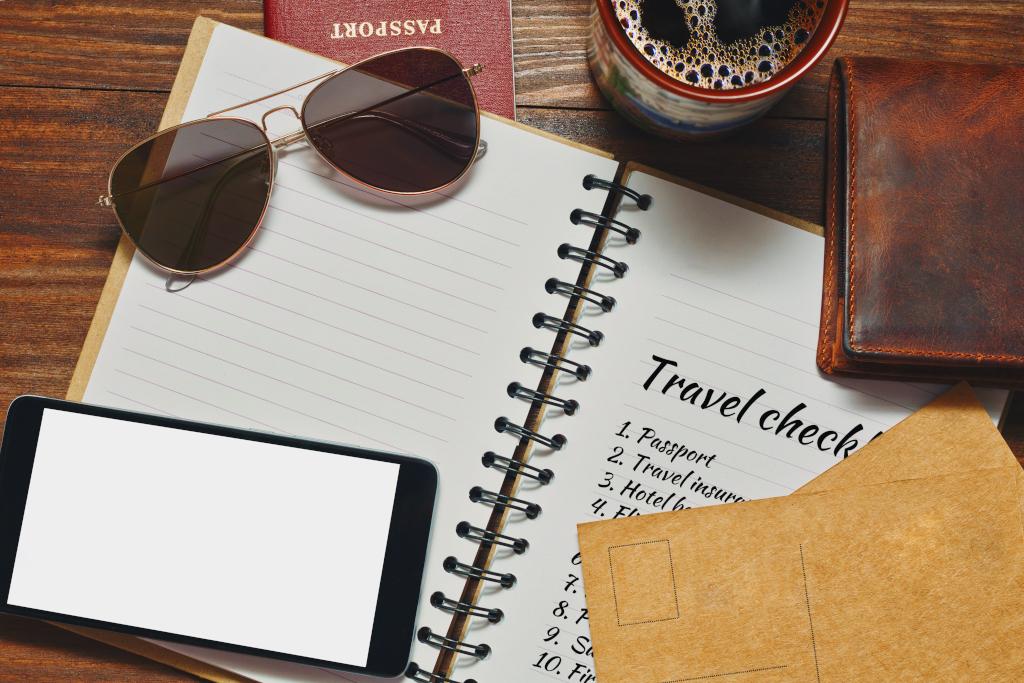
Getting ready to go on a trip can be very exciting, but it’s also a little stressful. From booking your flights to double-checking your accommodation details, it’s easy to forget some of the tasks you need to do before locking up your home and heading for the airport. To help make it easier for you to get ready for travel, we’ve put together a list of things to do before going on vacation that includes tips, hacks, and pre-departure must-dos.
Prepare for adventure!
Before you go on vacation, download our app and search for nearby scavenger hunts ! With competitive sightseeing tours, bar crawls , art walks, ghost hunts in over locations around the world , you’re sure to find at least one for you and your traveling companions to enjoy!
Things to Do Before Going On Vacation
1. save money for the trip. .
This one is kind of a given but it’s important to save money for your trip. While traveling is certainly a wonderful adventure, it’s decidedly less fun if you’re counting your pennies all of the time or having to skip things that you really want to do because you can’t afford it.
If you’re a woman traveling alone , it’s also incredibly important that you have enough money with you to pay for any unexpected emergencies. I have met many travelers who will stay on the road until they spend their very last cent. This is a really bad idea because you never know what may happen and having access to money can go a long way in helping you get out of a bad situation.
Also, try not to get into the habit of putting everything on your credit card and worrying about it later. This is a good way to get into debt and that vacation may end up costing you a lot more than you thought in the long run.
2. Check and re-check your packing list.
There are generally two types of travelers. First, there are those that diligently prepare a list of things that they need to bring with them on a trip. They will often use handy little packing cubes that make packing a breeze and help you keep your things organized throughout their trips.
And then there are the rest of us. We are the ones that throw the things that we need into our bag without too much thought and hope that everything magically fits. This could be because we are barely unpacked from one trip before we are getting ready for the next (yah!) or because we simply don’t have the time or the energy to really prepare before the very last minute.
Regardless of what type of traveler you are, it’s always a good idea to have at least a mental checklist of the things that you will need and that you double-check that you have everything. Even if you’re constantly on the road and think you have packing down to a science, you should still take a quick look through your bags to make sure that you aren’t missing anything. I once flew to Singapore for a business conference with a suitcase full of light-colored shirts but only the black bra that I was wearing. Yikes.
3. Research transportation options.
If you’re a frequent traveler, you may find yourself forgetting to research transport options in your destination until the very last minute (I am very, very guilty of this). However, not researching transport options before you book your flights can end up wasting you a lot of money in the end.
This is particularly true if you’re arriving or departing early in the morning or late at night. Most airports do not offer 24-hour public transport options or car rental. If this is the case, you may find yourself paying inflated prices for taxis or hotel pick-ups. While in some cases this is unavoidable, try not to book flights that have odd departure or arrival times until you have confirmed how much transportation will be on the other end.
4. Organize a house sitter.
Depending on how long you will be traveling and whether or not you have pets, you may want to consider hiring a house sitter or a pet sitter. The job description of a house sitter can be someone who stops in every few days to water the plants and make sure that nothing catastrophic has happened. A pet sitter is a person who stays in your house for the duration of your vacation, feeding and loving your pets and taking care of any issues that arise.
If you don’t have any animals, it’s still worth considering getting a house sitter if you’re going on a long trip just for the peace of mind that someone is keeping an eye on everything.
In case you don’t have a trusted housesitter and aren’t even quite sure how to find one, you may want to check out Trustedhousesitters.com . For a small annual fee, they help match people looking for housesitters with those who are looking for a place to house sit.
5. Contact your bank.
Another really important thing that you must do is contact your bank and your credit card company to let them know that you will be traveling. If they are not made aware of this, they may block your credit cards and debit cards when you try to use them in a foreign country.
Depending on the bank, this is usually relatively straight forward and you may even be able to do it online or through their app. It only takes a few minutes but it can save you major headaches in the long run.
Pro tip: If your credit card doesn’t work when you try to make a purchase, try contacting your bank immediately to tell them you’re trying to make a purchase overseas. It’s likely that they can just release the hold on the purchase immediately and when you try again, the transaction will go through.
6. Turn down the thermostat and water heater.
If you live in a cold climate, don’t forget to turn down the thermostat before you lock up. This will keep your furnace from heating an empty home and can save you money on your next utility bill. The suggested temperature is around 55-60 degrees. This is enough to keep your pipes from freezing, but it’s not so high that it will eat up a lot of electricity.
While you’re doing this, don’t forget to turn your water heater to vacation mode or to turn the temperature down to around 50 degrees.
7. Eat all your perishable foods and clean your disposal.
We’ve all done it before. Just a few days before we go on vacation, we go to the grocery store and buy a ton of food. For some inexplicable reason, most of it just happens to be fresh fruit and vegetables. There is no reason why we do it but it seems that our logic is temporarily overrun and we soon find ourselves at home with a kitchen full of food wondering what the heck happened.
At this point, there is really only one thing to do—it’s time to eat all your perishable foods. Salads and sandwiches may be the only thing that you eat for the next few days but it sure beats throwing away food or coming home to a kitchen that resembles a petri dish!
While you’re cleaning out your fridge, make sure that you also clean out your garbage disposal so that you don’t come home to a stinky sink. You simply need to throw in a half cup of baking soda and some vinegar. Once it has sat for 10 minutes, you can turn on the hot water and flush it out. it’s easy, fast, and definitely worth taking the time to do!
8. Make close friends or family aware of your travel plans.
If you’re about to head off on an adventure, make sure that someone in your family or a close friend knows what your travel plans are. While it’s nice to think of going completely off-the-grid for a few days, not letting anyone know where you’re going could end up making the difference between life and death.
Make sure to leave the phone numbers of the hotels or guesthouses that you will be staying at. Do not forget to let them know if there are any changes that happen last minute so that they know how to get in contact with you if necessary. If you buy local SIM cards at your new destination, make sure that they have those phone numbers too in case you’re unable to contact to wifi or data.
I personally like to check in on Facebook when I am at the airport waiting for my flight and when I arrive at a new destination. I only mention what city I am in rather than an exact location (that can cause other safety issues, especially for female travelers) and it makes me feel a little safer that someone knows roughly where I am in the world.
9. But do not broadcast your travel plans on social media.
At the risk of contradicting my last statement, you also need to make sure that you don’t make it too obvious that you’re on vacation or how long you will be away. This is unfortunately a way that many burglars are able to know that no one is home and it may make your home a target for robbery.
10 Turn on your home security system.
If you have a home security system or a video doorbell, make sure that they are turned on and working properly before you leave. While it’s great to have everything set up, it’s not going to be very useful if it isn’t working. You may also want to let the alarm company know that you will be on vacation so they can monitor if there are any unexpected entries into your home.
11. Hold your mail at the post office.
Another easy way for robbers to find out that no one is home at a house is when mail starts piling up outside. It’s always a good idea to have your mail held even if you generally do not get much mail anymore.
If you’re expecting a package that has been delayed, you can also let any neighbors with whom you have a good relationship know so they can keep an eye out for it.
12. Make digital copies of all of your important documents.
Before you set off on your adventure, it’s important to always have digital copies of your important documents, especially your passport, health insurance card, driver’s license, COVID vaccination card, etc. This can be extremely helpful if your bag or wallet gets stolen and you need to replace anything.
If you’re traveling abroad , it’s also a good idea to have a printed copy of your passport with you at all times. Depending on where you are, carrying your passport with you may not be safe and a paper copy is usually sufficient if anyone needs to see it.
13. Set up an out-of-office response on your work email.
There is very little that can be worse than being on vacation and seeing an urgent email pop up in your inbox (stop checking it!) that you absolutely must respond to. Setting up an out-of-office response before you leave can let the other person know that you’re out of the office so they can find another way to resolve the issue or, at the very least, it buys you some time so that you don’t need to respond to it right away.
14. Unplug appliances at home.
Even when appliances are not on, they can still drain your electricity as long as they are plugged in. It’s a wise idea to switch off and unplug things like your TV, microwave, toaster, washing machine, etc. before you leave. This not only can save you some money from your electricity bill but it can also help the environment.
15. Put all of your valuables in your carry-on luggage.
While we always recommend that you travel as lightly as possible , there are some things that you simply can’t leave home without. Make sure to put everything valuable that you’re bringing with you in your carry-on luggage. This includes your laptop, tablet, jewelry, money, camera, etc.
You never know what happens to your luggage when it’s out of your sight, and if you have everything of value with you, you can rest assured that it won’t disappear somewhere along the way. However, keep in mind that the only way that you can be absolutely sure that nothing will happen to it’s to keep your bag under the seat in front of you. Sadly, there have been reports of people’s things getting stolen from the overhead bin and it’s always better to be safe than sorry.
16. Check in online.
If you’re taking a flight, make sure to check in online before heading to the airport and download a copy of your boarding passes on your phone. This can save a lot of time at the airport. Considering what a zoo they have become, this can make a big difference as to whether or not you make your flight.
17. Pre-order any specialty meals.
If you’re taking a flight where they are serving complimentary meals, make sure to order a special meal at least one day before you leave if you have any dietary restrictions. Most airlines will only let you request a meal at least 24-48 hours in advance and, trust me, the last thing that you want is to be sitting there hungry watching everyone dig into their meals around you.
18. Buy travel insurance.
When you’re organizing your trip, it’s easy to forget to purchase something that, frankly, you hope that you will never need to use. Yep, you guessed it, I am talking about travel insurance. Unless you have an international health insurance plan, it’s important to remember that most American health insurance policies will not cover you if you’re out of the country.
Costing roughly around $1 per day for a decent policy with a low deductible, travel insurance is very inexpensive and can save you a ton of money in the event of an unexpected illness or an emergency. There are some travel insurance aggregators that make it easy to find a policy that works for you so make sure to put this at the top of your to-do list.
19. Pay any upcoming bills.
If you don’t have all of your bills on auto-pay, make sure to pay any outstanding or upcoming bills before you leave. Coming back to a mountain of late fees can be a real buzz-kill after an amazing vacation.
20. Turn off your water.
If you’re going to be away for more than a few days, it’s always a good idea to turn off your water supply before you leave. This can help prevent any potential flooding that could occur as a result of broken pipes or leaks.
This is very important if you live in a cold environment where there is the chance that your pipes may freeze and burst. Water in your pipes can freeze after just six hours of being at 20 degrees or below and the last thing that you want to do is come home and find a huge mess.
21. Have your car serviced.
If you’re heading out on a road trip, it’s also a very good idea to have your car serviced at least a week before you leave, especially if it’s an older model. This can help you catch any small issues that could become much bigger ones while you are on the road, putting an abrupt end to your vacation.
22. Carry your necessities in your carry-on.
If you’re planning on checking luggage, make sure to keep any necessities that you may need for the first day or two of your trip with you in case your bag gets lost. This includes things like contact lens cases, glasses, a toothbrush, underwear, a spare change of clothes, and a bathing suit.
If you’re traveling abroad, it’s also very important to carry travel adapters with you as well as your phone, laptop, and tablet chargers. If you don’t have an adapter, you can order them from Amazon before you go. Although you can sometimes get them at the airport, they are generally very expensive and not as good of quality as what you can find online.
Ready to roam?
We hope that this checklist has left you feeling a bit more prepared for your next trip. If you need some more tips and tricks, make sure to check out our list of the “ Dos and Don’ts of Air Travel ,” our international travel checklist , and the other expert travel advice contained within our Explorer Blog !
There are some important things to do before going on vacation . Unplug non-essential appliances, turn off your water, and consider turning down the heat and hot water heater.
While preparing to leave for vacation , lock your doors and windows and notify your security company that you’ll be away. Hire a house sitter if possible, and don’t announce your vacation on social media!
If you’re taking a trip, use a checklist of things to do before vacation so you don’t miss any key preparations. Don’t forget to download the Let’s Roam app to access fun adventures while you’re away!
Featured Products & Activities
- Search Please fill out this field.
- Manage Your Subscription
- Give a Gift Subscription
- Sweepstakes
- Travel Tips
- Packing Tips
How to Pack Lighter, Smarter, and Faster, According to T+L Editors
Since 1971, Travel + Leisure editors have followed one mission: to inform, inspire, and guide travelers to have deeper, more meaningful experiences. T+L's editors have traveled to countries all over the world, having flown, sailed, road tripped, and taken the train countless miles. They've visited small towns and big cities, hidden gems and popular destinations, beaches and mountains, and everything in between. With a breadth of knowledge about destinations around the globe, air travel, cruises, hotels, food and drinks, outdoor adventure, and more, they are able to take their real-world experience and provide readers with tried-and-tested trip ideas, in-depth intel, and inspiration at every point of a journey.
No matter the length of the trip — be it a weekend beach getaway or a three-week Himalayan trek — you'll need to pack a bag, and you'll want to pack it right .
There's a lot to consider when determining what to bring: the type and length of your trip, your itinerary, the weather, the size of your luggage, and any weight limits imposed by your mode of transportation. And with so many factors at play, it's easy to overpack or underpack, especially if you've waited until the last minute.
Enter: the editors at Travel + Leisure , most of whom can be ready for a trip at a moment's notice. We're sharing our favorite ways to keep your clothes wrinkle-free, your cosmetics spill-proof, and your souvenirs safe, whether you're packing for a solo trip or for your entire family (kids included).
You'll learn how to best organize your carry-on luggage , how to pare down to avoid those excess baggage fees, and a few easy tricks to help you remember the little items you're most likely to forget .
With these travel packing tips, you'll be packing like a pro in no time. The only question that remains: Where will you and your impeccable packing skills be heading to next?
Pack by Outfit
"There's nothing more annoying than struggling to stuff everything back into your suitcase at the end of a trip only to realize you didn't even wear half the clothes you brought. That's why I started strictly packing by outfit — not individual item — and only letting pieces I had a plan for make the cut. I'll take a skirt only if I know I'm bringing a top and shoes that I would wear with it, and I'll think about the activities on my itinerary and what I see myself wearing while doing them. I hate checking a bag but love clothes, so being realistic and planning ahead is key." — Nina Ruggiero, Deputy Digital Editor
Lay Things Out First
"Even when I pack at the very last minute, I take time to lay everything out before any item goes into my bag. Grouping things together on my bed helps me see quickly what items don't pull their weight. A pair of pants that can only be worn with one top, or that requires shoes I wasn't already planning to pack? Back in the drawer. Seeing everything clearly before I start also helps me fit things into my bag in a logical way. For me, this means starting with my bulkiest items, then cherry-picking lightweight items to tuck into gaps around them to form a sturdy base layer to build up from." — Skye Senterfeit, Photo Editor
Have a Dedicated, Pre-packed Travel Dopp Kit
"One of the most frustrating parts of getting ready for a big trip is realizing that you can't zip up your bag until after you've brushed your teeth and packed the products you need in your toiletry bag. I keep a travel-only toiletry bag that has duplicates of everything I ever travel with ready to go in my suitcase." — Tanner Saunders, Associate Digital Editor
To buy: Rains Small Dopp Kit, nordstrom.com , $34
Choose a Soft-Sided Bag
"Packing in a soft-sided weekender or duffel gives you the flexibility (literally!) to shape your bag to what you're packing instead of the other way around. My canvas overnighter takes on a different shape depending on what I need it to hold and will squish, even when packed almost beyond its means, into spaces a hard-sided roller bag just won't go. I hope my current bag will last forever but I'm eyeing this simple weekender from Makr as its eventual replacement." — Skye Senterfeit, Photo Editor
To buy: Makr Fold Weekender Revised in Navy Canvas, makr.com , $185
Have a Ready-to-go Health Kit
"After going on international adventures and suffering food poisoning, sudden fever, cuts and scrapes, terrible bug bites, and other ailments — and then having to navigate a foreign pharmacy — I've learned to always pack a small medical kit . I keep a toiletry bag ready to go stocked with Band-aids, Neosporin, pain relievers, cold medicine, medicine for stomach trouble, itch relief ointment, antibiotics (you can ask your doctor for an emergency prescription before you travel), and ear plugs (life savers on long-haul flights and trains). And if you never have to use it, all the better!" — Karen Chen, Editorial Producer
To buy: First Aid Kit, amazon.com , $20.57
Separate Jewelry With Snack Size Bags
"Buy 'snack size' plastic bags for packing necklaces. To prevent tangling, give each one its own bag and fasten the clasp." — Kathy Roberson, Copy & Research Chief
To buy: Ziploc Double Zipper Storage Bags, amazon.com , $19.94
Check the Hotel Closet
"In the closet of most high-end hotel rooms, you'll find draw-string fabric bags for laundry and shoes. They're semi-disposable, but fantastic for packing. Trust me, using them to separate shoes and dirty laundry will totally transform your return-journey packing experience." — Flora Stubbs, Executive Editor
Be Prepared for Wet Swimwear
"I always pack a plastic grocery bag — or steal the shower cap from the hotel if I forget — to stash a wet bathing suit in for the return home. That way, we get to enjoy every last second on the beach." — Jacqueline Gifford, Editor-in-Chief
Use Marie Kondo's Folding Method
"All memes aside, I've been living the Konmari lifestyle for a few years now, and her folding method may be one of the biggest takeaways. Not only does the method save room in drawers at home, but the folded clothes can go quickly in a bag or suitcase for extremely fast packing. Another perk of using the Marie Kondo method is being able to see your entire wardrobe at once so you don't have to waste time digging in boxes of storage for off season clothes when taking a warm weather vacation in winter months." — Mariah Tyler, Visuals Editor
To buy: "The Life-Changing Magic of Tidying Up: The Japanese Art of Decluttering and Organizing" by Marie Kondo, amazon.com , $17
Roll, Don't Fold
"I always overpack, so rolling up my clothes so that they take up less space in my luggage is essential." — Devin Traineau, Associate Photo Editor
Keep Essentials Packed and Ready to Go
"I am a terrible packer. No matter where I am going, or for how long, or how far in advance I booked my trip, I will inevitably be up at 2 a.m. the night before, just one misplaced sneaker away from a complete meltdown. I've accepted this as an inevitability and tried to streamline the process where I can, so now, I always keep a clear toiletry bag packed with all my favorite products, so I can see at a glance what I have and add in a couple essentials (sunscreen for a lake trip, bug spray when there's hiking planned, etc.). I also keep a few plane go-to's — chargers, lip balm, eye mask, neck pillow — in my favorite travel bag, which helps me speed through the personal-item prep so I can get back to bemoaning my lack of good shoes and waffling on how many caftans and books I'll need for a four-day weekend." — Lila Battis, Senior Editor
To buy: Travel Smart by Conair Transparent Sundry Kit, amazon.com , $12.99
Invest in Luggage You Love
"For most of us, no matter how organized we are or how many times we do it, packing will just never be pleasant. The best way to make it more enjoyable? Invest in luggage you look forward to using, be it for functionality or style — or, ideally, both. As professional travelers, the T+L team spends a whole lot of time packing and unpacking, so we worked with top luggage brand TravelPro on a collection we knew we'd actually love to use. I have a set (including a checked bag, hardside carry-on, and tote), and all three pieces are sturdy, spacious, and basically do the organizing for you as you pack in their various compartments. I'm always happy to take them out of my closet and prep for a trip, and I feel good deplaning and exiting the airport in a new city with them in hand." — Nina Ruggiero, Deputy Digital Editor
To buy: travelpro.com
Create a Capsule Wardrobe
"No matter how hard I tried, I could never streamline my packing list — until I started thinking of it in terms of a capsule wardrobe with a specific color palette. I always start with a neutral (usually black or blue) and then build outfits based on the main events or activities happening during the trip. Usually it ends up consisting of two dresses, two pairs of pants, two tops, 1-2 sweaters, and a jacket. More brands, including Aday and Summersalt, are designing their lines so that everything mixes and matches easily, which makes building a functional but flexible packing list that much easier." — Sarah Bruning, Senior Editor
To buy: Wing It Sweater, thisisaday.com , $265
Wear Your Heaviest Clothes on the Plane
"As a chronic overpacker, and someone who never, ever checks a bag, weight limits are no friend of mine. That's why I always stick to the following motto when it comes to packing light: If it's heavy, wear it. Bulky jacket? Cute boots? Chunky sweater? I'll wear them all, then throw the jacket in the overhead bin, slip off my boots and into some compression socks, and usually keep the sweater on – a warm and cozy antidote for those often chilly airplane cabins." — Alisha Prakash, Senior Digital Editor
Keep Masks and Hand Sanitizer at Hand
"If you're traveling during the pandemic, you'll want to pack essentials like face coverings and hand sanitizer in your checked and carry-on luggage so you're never without. Keep them in an easy-to-access pocket so you can grab a fresh mask, wipes, or sanitizer whenever you need it." — Elizabeth Rhodes, Associate Digital Editor
Prepare for Travel Shopping
"Admittedly, packing light isn't easy for me. The only way I can get myself to not prepare for every possible scenario (and end up packing ski goggles next to swimsuits for the same trip) is by promising myself a little shopping while I'm at my destination. This helps me to pack only essentials and a couple of favorite items I know I'll wear or use. Then, I leave at least a quarter of my suitcase empty, ready to be filled with souvenirs. If I don't end up shopping, it's even more of a bonus — there's nothing better than lightweight luggage." — Kendall Cornish, Associate Digital Editor
To buy: Travelpro ® x Travel + Leisure ® Compact Carry-On Expandable Spinner, travelpro.com , $525
How to Pack Delicate Clothes
"I always roll my clothes, making room for more things in my suitcase (admittedly, I'm an overpacker), especially with fabrics that tend to wrinkle or crease easily, like silk or satin. For items that are especially delicate (hello, slip dresses!), I always, always, always roll them around a piece of packing paper. I like that over tissue paper because it's sturdier and tends to hold its shape even if things in my suitcase move around." — Deanne Kaczerski, Digital Content Director
To buy: Brown Craft Paper Roll, amazon.com , $58.25
Wait to Wrap Gifts
"If you're traveling during the holidays, wait to wrap your gifts when you reach your destination. TSA may have to unwrap presents to see what's inside, so it's best to bring the packing supplies with you or opt for bags and tissue paper for easy-rewrapping." — Elizabeth Rhodes, Associate Digital Editor
How to Prepare for Any Trip in 7 Easy Steps
Disclaimer: This post might contain affiliate links, which means we get a small commission if you make a purchase (at no extra cost to you).
The dates of your trip are quickly approaching.
Your trip is planned .
And you might start to feel a little overwhelmed with the “nitty gritty” travel preparations.
The passport, packing, your phone and credit cards.
Everything is piling up.
Preparing for a trip is stressful.
Here are the things you need to do before you take off and travel!
Whether you’re traveling with an organized travel group, like EF Ultimate Break , or on your own, preparing for your trip departure doesn’t have to be exhausting.
Here’s the list of things we do before we leave for our trips so we are well prepared!

1. Make a Packing List
By making a packing list, you can see what kinds of things you might need to purchase for your trip and so you don’t forget anything! Check out our packing essentials blog here. As you’re developing your list, think about the things you might need to purchase so you can buy it well in advance. This is a good time to evaluate your luggage. Is your bag big or small enough for your needs?

2. Decide How You’re Going to Document Your Trip
Are you someone who likes to write in a journal? Or do you think taking photos on your Instax camera for a scrapbook? Before you leave, think about how you want to document and remember your trip. Some people mail themselves postcard home from every destination. We like taking lots of photos and keeping all of your tickets and brochures for scrapbooks. It’s a good idea to think how you want to document your memories before you leave, so when you get back you don’t regret doing something.

3. Check Your Passport.
There is for international trips. Make sure your passport is up to date or if you need to get a passport, give yourself enough time to apply for you. Typically, it’s a 6-month process, so start it early enough! Also, some countries require visas, so check where you’re traveling so you can start the process!
4. Get Your Phone Ready
If you want to use your phone abroad, talk with your phone provider about your options. If you’re planning on taking most of your photos on your phone, make sure you have enough storage on your phone. There’s nothing worse than getting the not enough storage notification. If storage is an issue, you can download Google Photos and have your photos push to Google instead of your device.
5. Contact Your Bank and Credit Cards.
Let your banks and credit card companies know that you’ll be out of the country so they don’t freeze your card for suspicious oversees transactions! There’s nothing worse than not having access to your money when you need it.
6. Plan Your Free Time Wisely
Whenever you have free time between tours and booked activities, don’t try to “overbook” the time with tons of things to do. If you have a free day or afternoon at a destination, only plan for 3-4 activities. This gives you enough time to get from place to place, eat meals, and explore. You don’t want your travel experience to become a long checklist of activities that become burdensome to complete. You don’t want to feel so “on the go” that sightseeing becomes stressful or that you miss the experiences you wanted to have!

When planning your time, look online for unique things to do. Of course, everyone wants to see the highlights of a location, but search for local or off the map experiences. Some experiences require booking ahead of time, so start looking early for bookings and make sure you don’t miss out on tickets. You don’t want to miss seeing something because you didn’t book a ticket in advance.
7. Start a Travel Fund
If you’re like us and living on a student budget for travel , start setting aside some money here and there so you have some extra to spend on your trip. There are lots of easy ways to start saving money. Some of our favorite ways are setting aside loose change and adding some ones and fives every couple of weeks! It will start to add up. We also set aside a fixed amount from each paycheck for travel.
Like it? Pin it!

Similar Posts
Romantic travel destinations in europe for any type of couple.
The holiday of love: Valentine’s Day! Spending Valentine’s Day at home with your honey is always fun, but there are lots of places in the…
Best Cities on the East Coast
Learn more about the best east coast cities to visit this year! The East Coast of the United States is full of exciting cities worth…
30 East Coast Historical Sites You Need to Visit
Explore the best historic sites and attractions on the East Coast!
How to Travel as a Student: Creative Ways to Travel on a Student Budget
Want to travel as a student, but feeling like it’s impossible? Well, it’s more attainable than you think! Keep reading to discover creative ways you…
Your Guide to Must Have Travel Apps for Students
In today’s world, having a phone is basically a necessity. Phones are our gateway to communication and discovery, particularly when you’re traveling. If you’re like…
Unique Airbnbs, Treehouses, Cabins, and Places to Stay in West Virginia
Looking for an awesome cabin in West Virginia? Book one of these unique places to stay in West Virginia! West Virginia is full of exciting…
Subscribe to our youTube!
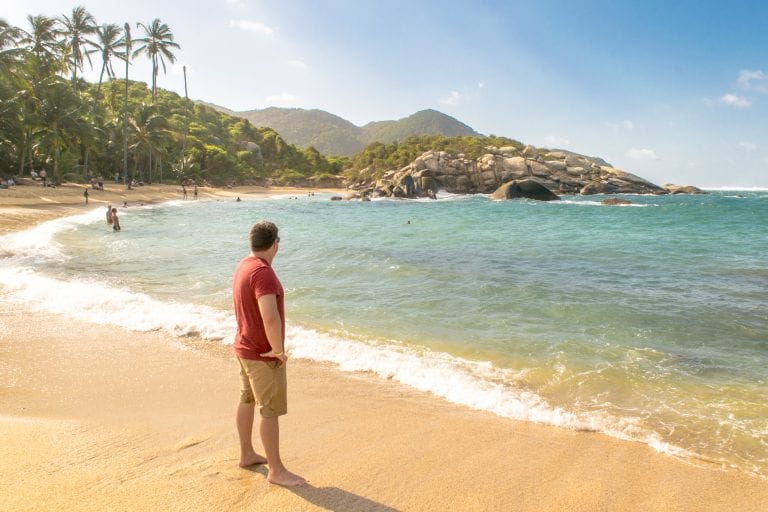
21 International Travel Checklist Items To Make Your Life Easier
Planning a big overseas trip–maybe even for the first or second time–and trying to put together the perfect international travel checklist to ensure you don’t forget anything before you leave?
We have you covered: as full-time travelers for more than 4 years across nearly 50 countries, we are well accustomed to preparing for international travel.
We’ve put together this international travel checklist to make sure you leave for the airport stress-free and ready to enjoy a phenomenal vacation abroad!
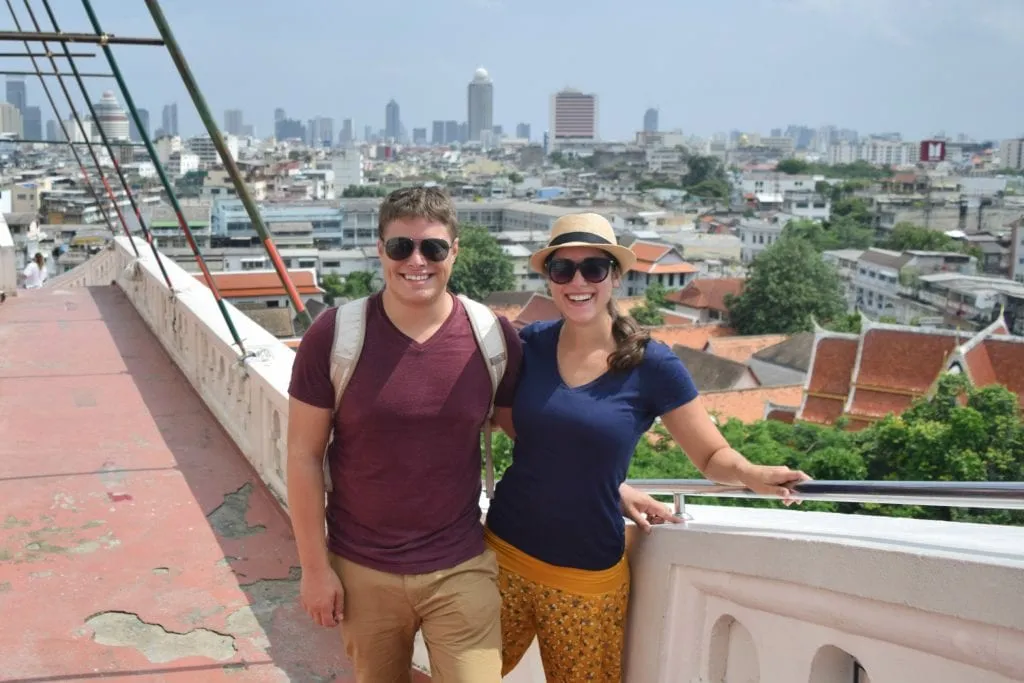
Some links in this post may be affiliate links. If you make a purchase through one of these links, we may earn a small commission at no extra cost to you. Please see our disclosure policy for more detail.
International Travel Checklist: Booking Your Trip
Calculate your travel budget and plan with your eyes open..
Before starting any of your trip planning, we recommend setting a budget for your travels.
Having a number in mind (though this is a very, very old post, we still stand by this formula for calculating your travel budget) will not only keep you from overspending, it’ll also keep you from underspending in the early planning stages.
You don’t want to get to the end of your trip and realize you could have splurged on that once-in-a-lifetime opportunity after all!
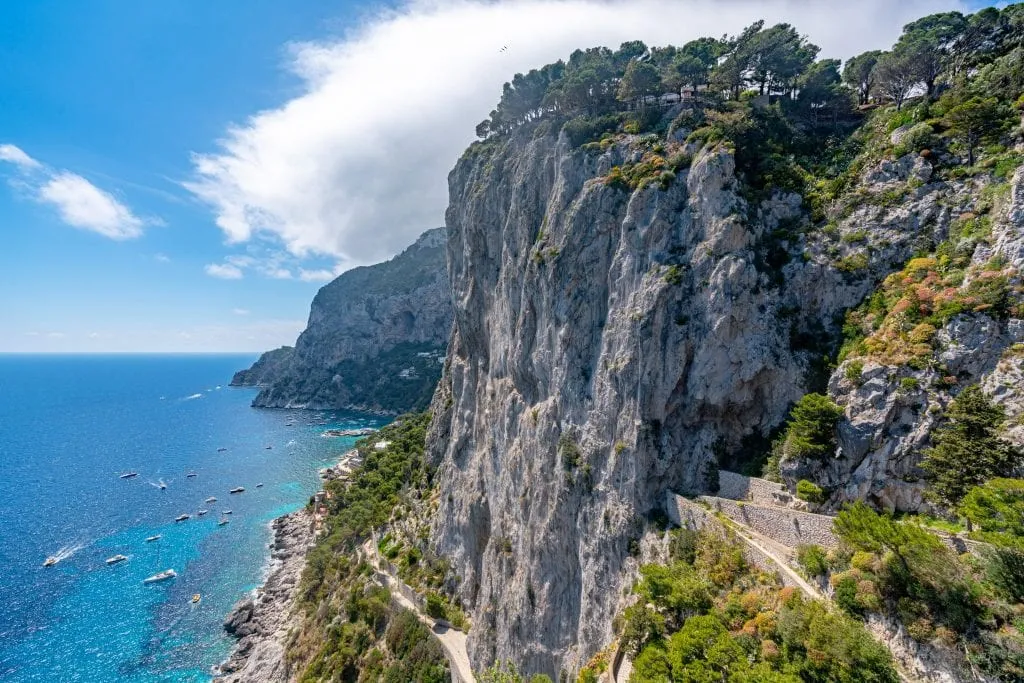
Sketch out your travel itinerary.
Once you have a budget in mind, go ahead and sketch out an itinerary for where you want to go once you arrive at your destination.
There is no limit to the variety of bucket list-worthy trips in the world, making narrowing down your options most of the challenge of this step!
This is one of our favorite things to do on this international travel checklist, and detailed itineraries are also my favorite blog posts to write.
If you’re headed to a destination we’ve covered on Our Escape Clause, use the search bar on the top right of the screen to find what suggested itineraries we have for your trip!

Check visa requirements.
Depending on where you are coming from and where you are going, this step might vary from a cursory Google search all the way up to planning a year in advance so you have time to gather your documents and get to an interview.
For US citizens, we recommend checking visa requirements for your intended destination on the travel.state.gov website , which will always have the most up-to-date official information.

Check COVID-19 documentation requirements.
In 2021 (and let’s be real: probably in 2022 and quite possibly beyond that), it’s a whole new world as far as traveling abroad goes, and this checklist would not be complete without mentioning COVID-19 documentation.
Whether you need to show your vaccination card, a negative test, or both, odds are you’ll need to square away some documentation to travel internationally.
Don’t forget to check any requirements for coming home, too!

Buy your plane tickets!
Personally, the moment that we finally purchase our plane tickets is virtually always the moment that a trip really, truly starts to feel real.
It’s exhilarating, and hopefully, a highlight for you as you work through this international travel checklist as well!
Book your hotels & rental car.
Once you have your travel itinerary ready to go, your plane tickets purchased, and your visa sorted (if applicable), it’s time for the next phase of preparing for international travel: booking your hotels for each destination and your rental car.
We typically use Booking.com (and occasionally Airbnb ) to find our hotels and apartments, Get Your Guide to book most tours and tickets, and use Discover Cars to find our rental cars.
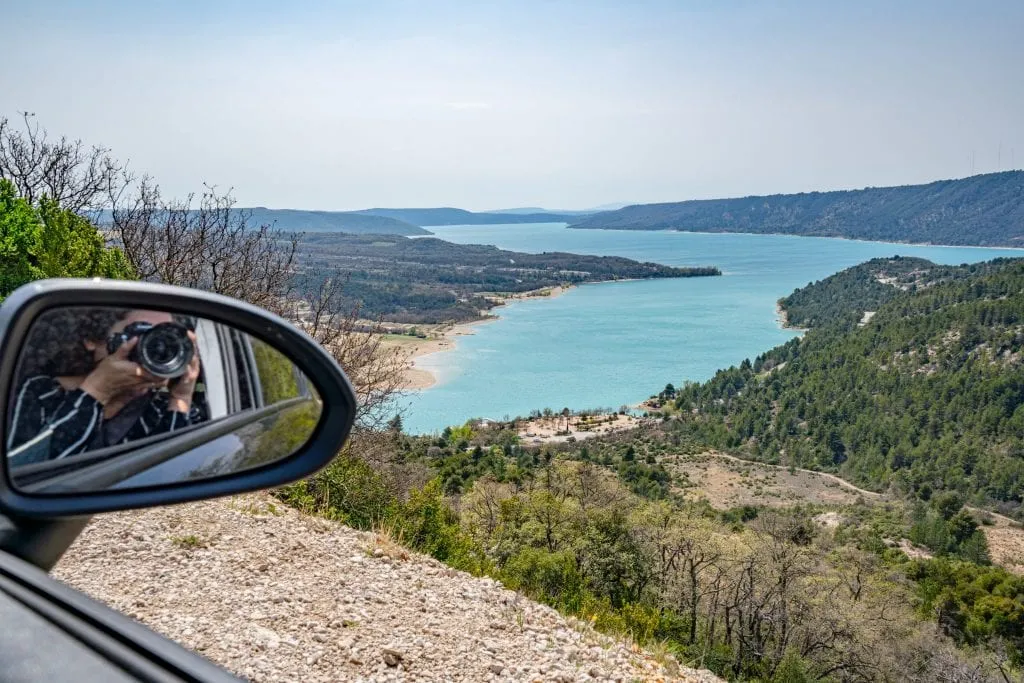
Start learning phrases in the language of your destination.
For the vast majority of international trips, this is more out of politeness than an extreme necessity, but still: as your trip starts getting closer, start learning a few phrases in the language spoken in your destination!
A few to start with are: yes, no, please, thank you, hello, goodbye, I would like, where is the toilet, and excuse me.

International Travel Checklist: Getting Your Documents in Order
Check the expiration date on your passport..
For most countries, your passport will need to have an expiration date more than 6 months after you leave the country.
If yours is getting close to expired, get that taken care of ASAP, especially if your trip is coming up (like, start looking at the process of renewing your passport this second ).
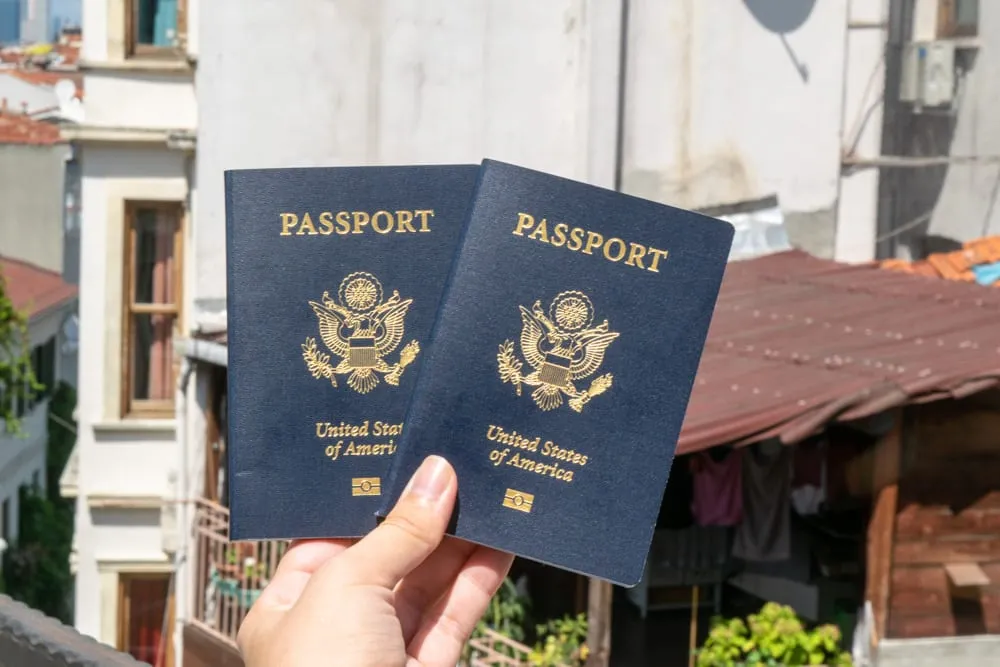
Book onward travel if needed.
Technically speaking, most countries around the world require you to have your exit plan firmly in place in order to enter their country.
Depending on where exactly you’re going and your level of passport privilege, this may be a very important step on your international travel checklist or more of a CYA move, but either way, it’s good to have it taken care of.
If you have a round-trip plane ticket booked, no worries, this doesn’t apply to you.
If you have a one-way ticket booked, print out or download it to your phone (don’t rely on having the internet to look something up in your email–we’ve learned that one the hard way) proof of your plan to leave the country in question.
If you don’t have a plane ticket, perhaps because you are planning to take a train or bus to your next stop, a hotel reservation or visa for your next destination may sometimes work, but it depends on the immigration officer or airline employee (as they often are de facto in charge of enforcing these rules) in question.
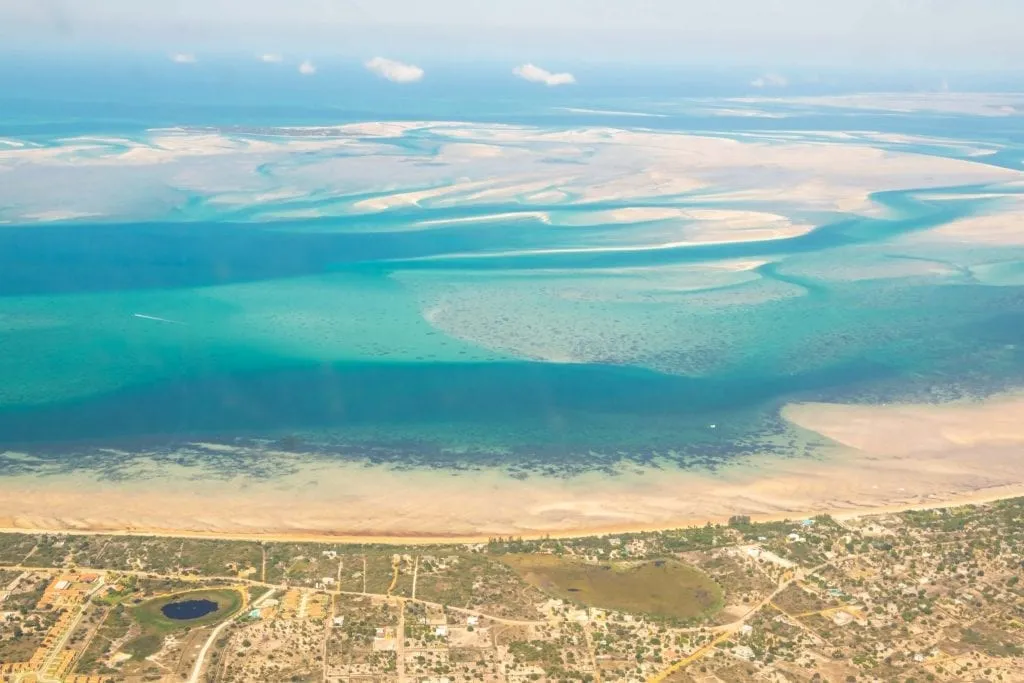
Buy travel insurance.
Given how inexpensive travel insurance is as compared to traveling in general, and how much money and headache it can save you in the face of something going wrong, it is absolutely worth buying when preparing for international travel.
We don’t ever suggest traveling without travel insurance–anything can happen on the road, and traveling abroad is definitely a case of better safe than sorry.
For the vast majority of destinations, we use and recommend Safety Wing for travel insurance.

Get an international driving permit if needed.
If you’re planning on driving on your trip abroad, be sure to check and see if you need to add an international driving permit to your checklist for international travel before you go!
These are essentially translations of your license into many languages–some countries require them, some technically do and rarely enforce it, some require it only if your license isn’t in one of several languages, and some don’t require it at all.
You can obtain a permit at home before you go by following these steps .

If necessary, get vaccinated.
Depending on where you’re going, what you’re doing, and how up-to-date your immunizations are, you may need anywhere from a slew of vaccines to prepare for your international trip, documentation of vaccines you’ve already received (especially in 2021), or nothing at all.
The more prep time you have to get any vaccines that you do need, the easier your trip planning will go!
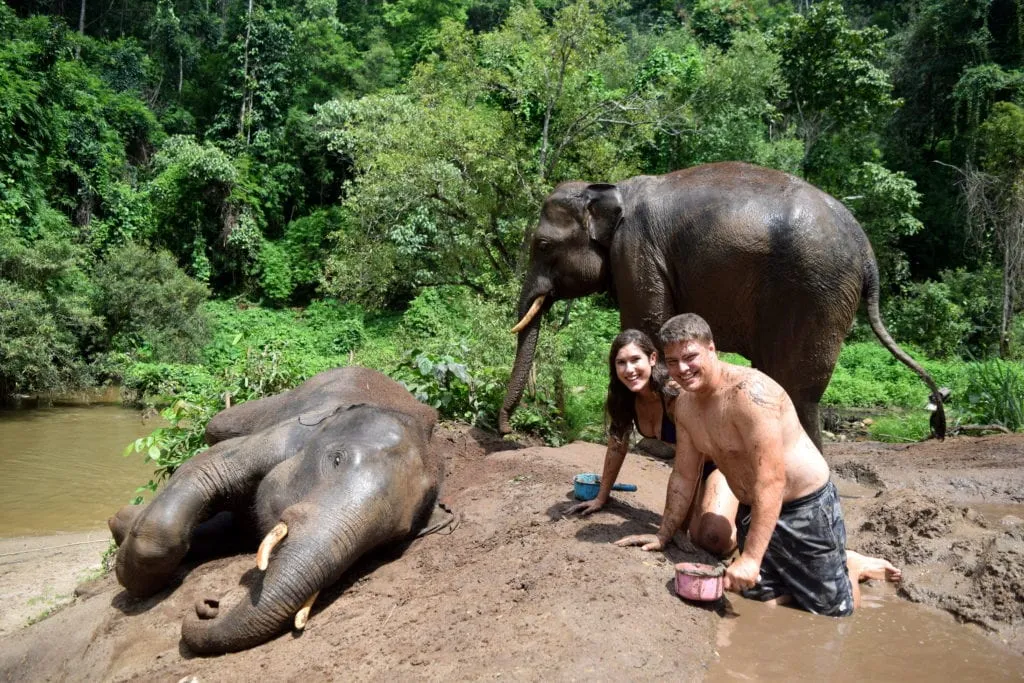
Email a copy of your itinerary to yourself and a trusted loved one.
The odds of a loved one needing to access your itinerary during your trip abroad are small, but even still, there’s no downside to making sure someone back home knows where you are!
On your side, it’s always handy to have a copy of all your hotel bookings, rental car bookings, plane tickets, etc, handy–you never know when you might need to refer back to something.
Generally, as part of planning a trip, we make an email folder specifically for that trip and put all relevant reservations and information in there to ensure we’re able to keep track of everything.

International Travel Checklist: Taking Care of Your Home
Stop your mail..
Don’t let mail pile up at your home while you’re away–make sure it is held at the post office for you for the duration of your trip.
For travelers from the USA like us, you can easily set up a mail hold here through USPS online .

Let family and friends know how to contact you.
Do you plan to stay in touch with family and friends through an international phone plan? Skype? Whatsapp? Email? Social media?
Whatever the plan, be sure to let your loved ones know–especially if you’re planning a longer trip–and if it makes sense for your situation, help them set up any necessary apps that they may not have yet.
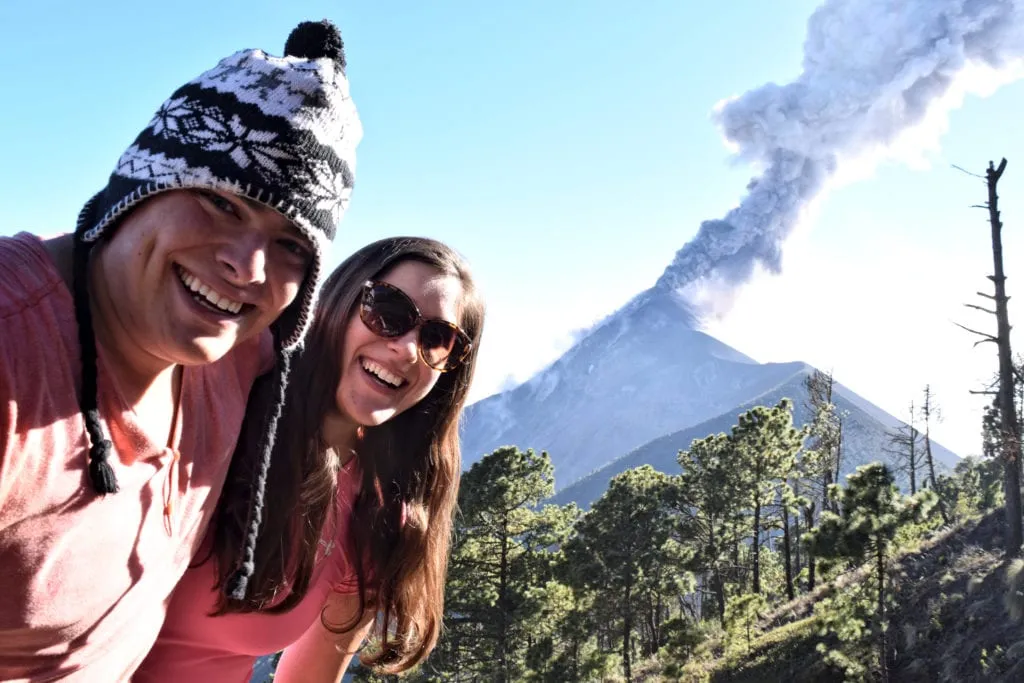
Hire a house or pet sitter if needed.
If you have plants that need watering, a pup that needs walking, a pool that needs cleaning, or just a house that needs someone to come by and make sure everything is okay, get a house and/or pet sitter worked out as far in advance of your trip as possible.
The closer to your travel dates that you start making arrangements, the more stressful the process can be.
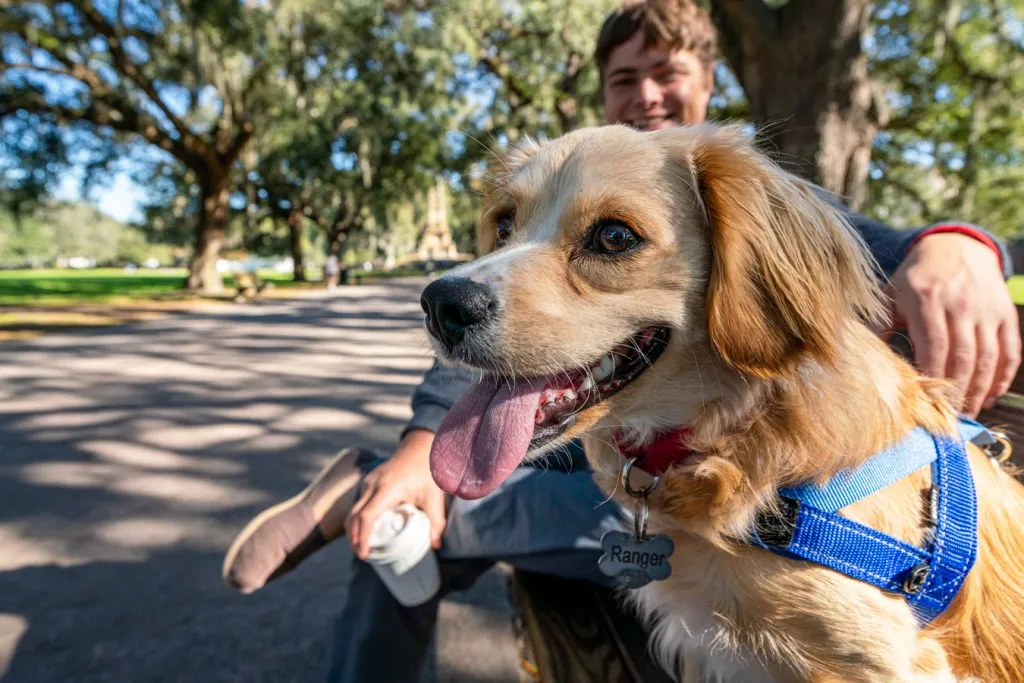
International Travel Checklist: Getting Everything Packed
Make a packing list and buy anything you need..
Obviously, your packing list will vary dramatically based on your destination, but here are a few items that are on our own international travel checklist, typically regardless of destination.
Comfortable Day Bag — We currently use Pacsafe’s sleek anti-theft backpack and love it, but if you don’t want to shell out the cash for this trip, that’s totally understandable. Just aim for something comfortable to wear, not flashy, and medium-sized–we used a Northface Jester backpack for years and loved it as well.
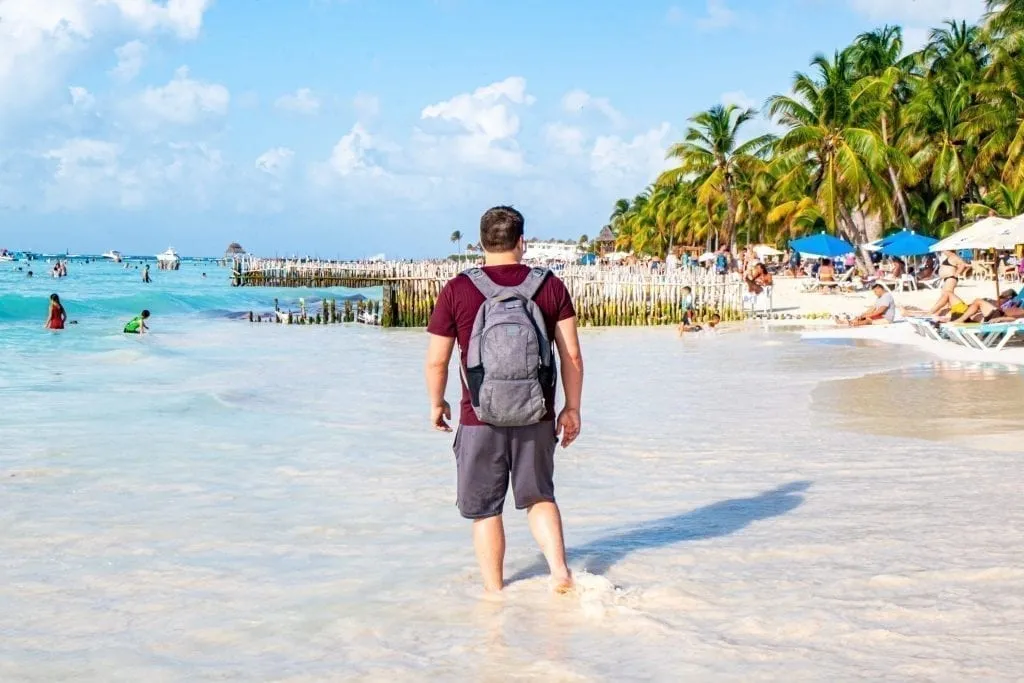
Money Belt — This is up to you, but I’ll include it here due to its popularity. We no longer use a money belt, but if you’re more comfortable having your passports on your person while exploring you can consider bringing one.
If you’re looking for a detailed packing list, we have dozens of them on Our Escape Clause including for summer in Europe , winter in Europe , Italy , Mexico , Colombia , and Ireland .

Check your prescription medications.
Do you have enough of a supply to last the length of your trip?
If you need to bring it with you in your carry-on luggage, is it in original packaging?
Let your banks and credit card companies know that you’re traveling abroad.
For most banks, this can be done online these days, but you can also choose to call to set a travel notification in a pinch.
Generally, they’ll want to know what countries you’re visiting and for how long, and simply make a note in your file.
Forget to do this, though, and you risk your card being denied when you try to use it abroad!

Be sure you have all your long-haul flight essentials.
We’ve dedicated an entire post to making sure you bring the right things with you for the endurance event that is getting through a long haul flight semi-comfortably, but here are a few things to get you started: an eye mask , lip balm, cozy socks, hand sanitizer, offline entertainment, and a portable USB charger .
If you like to download things to watch or listen to for flights, consider picking out one of the best travel shows to watch along the way!
Weigh your luggage before you leave.
… and compare it to not only the airline you’re flying with to reach your initial destination, but also any other airlines you’re flying for different legs of your trip, as well.
For example, if you fly from New York to Paris with Delta but are flying from Paris to Rome with Ryanair, make sure your luggage meets Ryanair’s requirements as well to avoid a headache later in your trip.
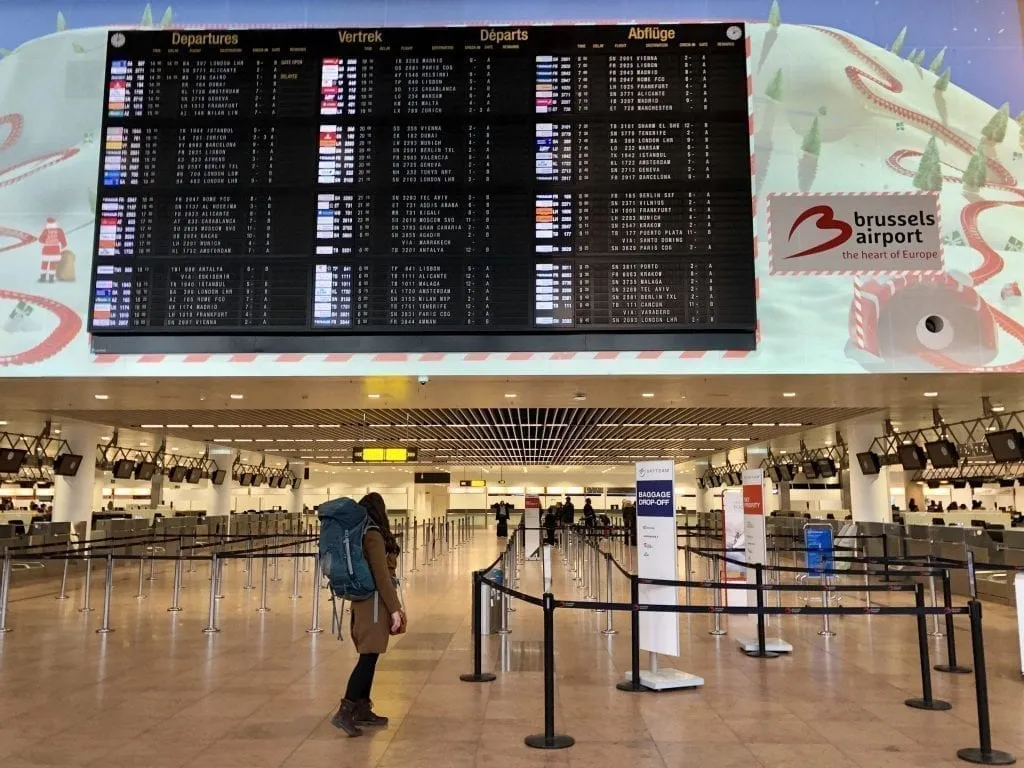
International Travel Checklist: Streamlining Your Arrival
Keep a pen in your carry-on..
If you end up needing to fill out an arrival card before passing through immigration, either on the plane before landing or upon arrival before getting in line for processing, you’ll be so glad to have a pen with you!
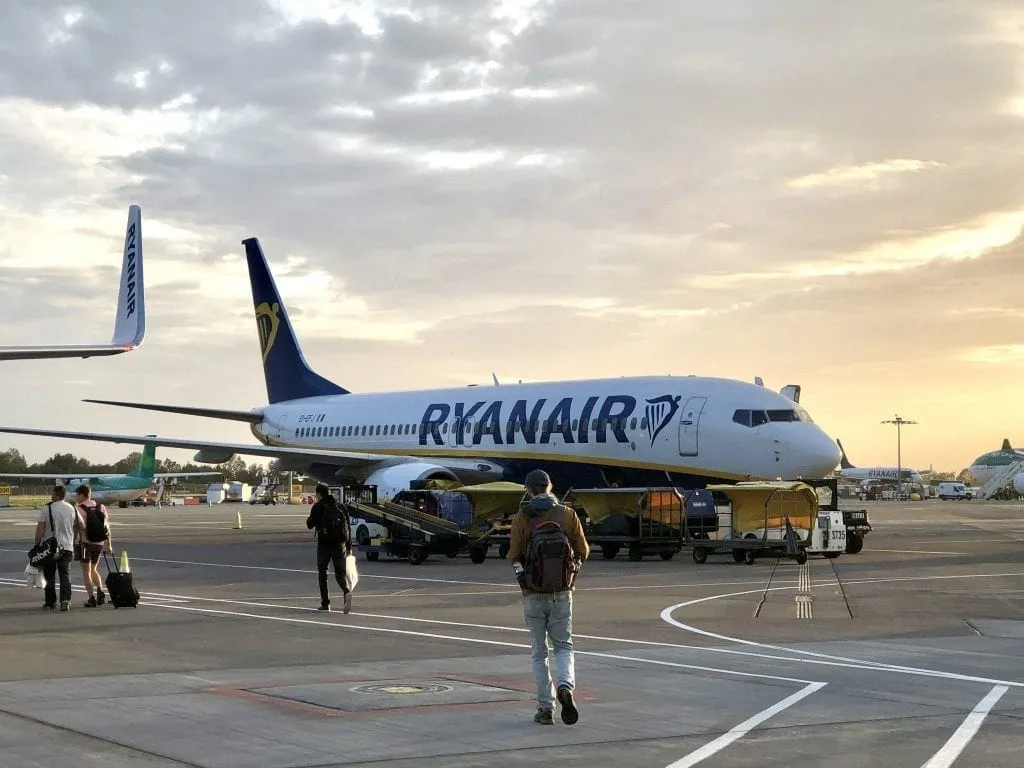
Have a plan in place to get from the airport to your hotel.
The final step of your international travel checklist is as simple as it is important: make an arrival plan.
When you arrive at your destination, you’re undoubtedly going to be exhausted, overwhelmed, and probably a bit jet-lagged, too!
No matter how many times we arrive in a new country, it never stops being a tiny bit stressful, simply because there are a lot of variables at play in the first few hours of arriving somewhere new.
Make life easier on yourself by thinking ahead: when planning your trip , figure out your exact steps of what will happen after the plane lands.
That means exactly how far away your hotel is, how you’ll get there from the airport (train, bus, rental car, taxi?), and if you’ll be traveling by taxi, what a reasonable price is and/or if there is set fare from the airport to the city center (there often is)
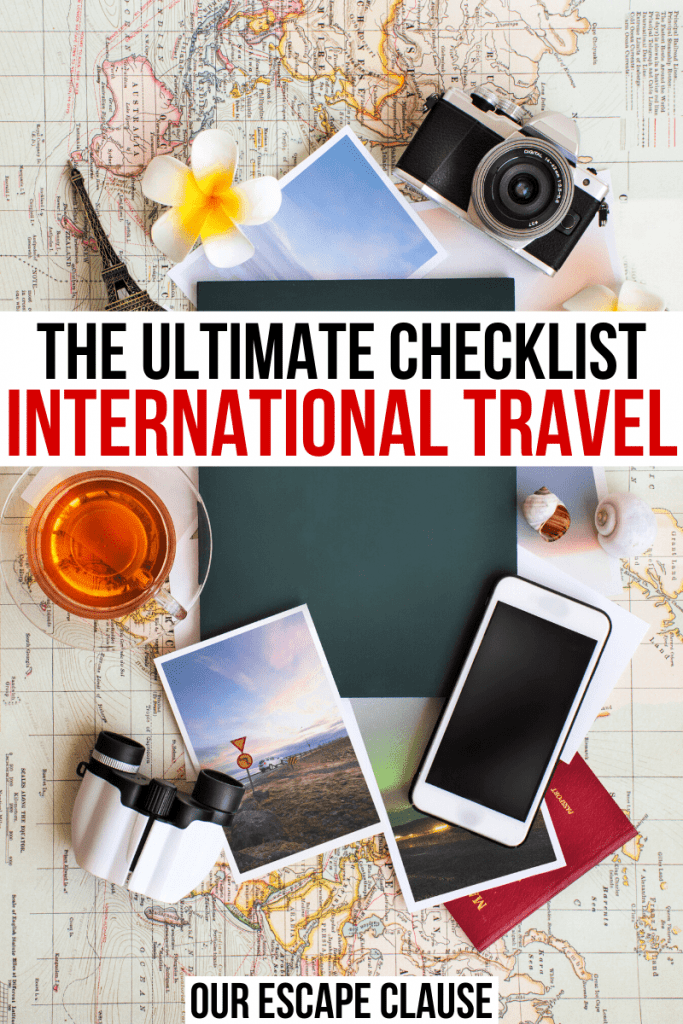
Planning a trip?
Subscribe to our newsletter to follow along with our travels and to receive tips and new content via email!
We won’t send you spam. Unsubscribe at any time.
About Kate Storm

In May 2016, I left my suburban life in the USA and became a full-time traveler. Since then, I have visited 50+ countries on 5 continents and lived in Portugal, developing a special love of traveling in Europe (especially Italy) along the way. Today, along with my husband Jeremy and dog Ranger, I’m working toward my eventual goal of splitting my life between Europe and the USA.
5 thoughts on “21 International Travel Checklist Items To Make Your Life Easier”
Very Helpful to Get My Task List Started! If you have something specific to the Holy Land regarding packing list and preparation tasks, I’d love to get my hands on it!
Thanks, Val! Nothing specific to that area at this time, but you never know in the future. 🙂
So glad I found your blog! I’ve traveled to multiple countries over the years, yet, you gave me new things to consider and since it’s been awhile since I’ve traveled it’s helpful to have all of this info in one place! I was wondering whether you recommend we use our cell phones in Europe and talk to our carrier about an international plan or purchase a temporary one at our destination? We are traveling to France this summer and Ireland two times next year. Thank you so much!
Hi Marissa! If your phone is unlocked, purchasing a European SIM card will almost certainly be far cheaper than an international plan. 🙂 You can buy a SIM card once you arrive at the airport (there are virtually always stalls set up as you leave), or you can even buy one on Amazon before you go! I believe Orange sells theirs on Amazon.
Great, thanks Kate!
Leave a Comment Cancel reply
Nomadic Matt's Travel Site
Travel Better, Cheaper, Longer
12 Ways to Be Prepared for Anything While Traveling

When I was a kid, I was a Boy Scout. I made it pretty far too, but then I became a teenager, decided it was “lame,” and quit. As a Boy Scout, I learned how to tie knots, camp outdoors, be a good citizen, play with knives, and got to have cool sleepovers.
One of the most important things you learn as a Boy Scout is their motto to always “be prepared,” and as I’ve grown up and traveled the world, I’ve found this to also be a travel truism.
You never know what might happen on the road .
Stepping out your door into the unknown is what makes travel so exciting. Each day brings endless possibility, but that possibility is for both good and bad. You may end up enjoying a day sightseeing in Paris — or getting robbed in Berlin . You may spend an amazing day on the beaches of Thailand — or suffer food poisoning in Costa Rica .
But if you’re prepared, you’ll be able to face whatever happens to you on the road:
1. Take Multipurpose Gear
Packing multi-use gear ensures you can easily adjust to changing conditions and helps reduce the amount of clothing you need to take. For example, I like pants that zip off into shorts, walking shoes that look nice enough for an evening out, and using my swim trunks as a pair of shorts. This saves both room in my bag as well as money since I don’t need to buy as much stuff. This always ensures you are dressed for any occasion (after all, who knows when you’ll suddenly find yourself invited to party?!).
Here are some posts on gear that can help you:
- How to pick the right backpack
- My suggested packing list (and a women’s version too )
2. Carry a Small First Aid Kit
While you can find modern medicine anywhere in the world, I always carry a small first aid kit with a few essential items to be safe. I take Tylenol, stomach illness medicine, eyedrops, Band-Aids, scissors, hydrocortisone cream, antibacterial ointment, and a small supply of doctor-approved antibiotics. I’m usually able to find a pharmacy when I need one, but in case of an emergency, it’s good to have these items handy.
Here’s a detailed guide on putting together a first aid kit .
(And, on a similar note, here are 10 ways to avoid getting sick on the road .)
3. Pack a Small Flashlight
You’d be surprised how many travelers don’t carry one, but a flashlight or headlamp will prove to be invaluable when you suddenly decide to go caving in Panama , when your hike lasts longer than expected and nightfall sets in, or when the electricity goes out unexpectedly, which is not uncommon in a lot of places.
4. Carry a Reusable Water Bottle (with a Filter)
Carrying a reusable water bottle and filter not only saves you money as a traveler, but it also prevents tons of single-use plastic from ending up in landfills or the ocean. And yes, should an emergency arise, you’ll be prepared. Most people can survive for 3 weeks without food — but you’ll only make it 3 days without water. Never leave home without a reusable bottle and filter, so that even you’ll have access to drinkable water if you’re in places where drinking the tap water isn’t recommended. SteriPen and LifeStraw are both great options.
5. Learn Basic Phrases
Locals don’t expect you to be an expert in their language, but knowing how to say “hello,” “goodbye,” and “thank you” goes a long way. After all, wouldn’t you be annoyed if someone came to your home and expected you to know their language?
Knowing a few key phrases will not only make interactions easier, but it will also help you when you bargain for goods, order food, get lost, or need help.
Lonely Planet makes excellent pocket language guides for just about every language spoken, and Benny Lewis wrote this excellent guide on learning languages .
6. Study Nonverbal Communication
Most people interact using both verbal and nonverbal communication, so paying attention to facial expressions can help you appropriately read a situation, even if you don’t understand the verbal part. When you don’t know the language, keep calm and take a moment to read the feelings of the person. This has helped me defuse tense situations with taxi drivers, vendors, and hotel owners. Understanding nonverbal communication doesn’t happen overnight and it does take practice. Here are some helpful guides for getting started:
- A Guide to Non-Verbal Communication
- How to Read Body Language
- Tips on Non-Verbal Communication
- 10 Websites for Non-Verbal Communication Tips
7. Keep Emergency Cash with You
While there is almost always an ATM around these days, you never know when emergency cash might come in handy. You could end up in an airport and find that none of your ATM cards work and you are stuck without any money (which happened to me once). I recommend having a stash of $200 USD for emergency situations. I don’t carry this money around but leave it in my hotel room safe in case something happens. It will be useful if you get robbed or lose your wallet.
8. Have Backup Credit and Bank Cards
I always keep one backup credit card and bank card with me in case of emergencies. You never know when one bank might decide to lock your account for suspicious activity without telling you (yes, that has also happened to me) or when you might get robbed. I once had my bank account information stolen while I was traveling in Europe. My bank had to deactivate my card, and if I hadn’t had a second one with me, I wouldn’t have had access to any money.
Here are some helpful blog posts on credit cards and banking for you:
- How to Pick the Best Travel Credit Card (With Suggested Favorites)
- How to Avoid Bank Fees When Traveling
- The Best Travel Credit Cards
- Points and Miles 101: A Beginner’s Guide
9. Make Copies of Your Passport and Important Documents
Keeping copies of your documents can come in handy during an emergency, especially if you lose your originals. If you get robbed or lose your passport, having copies ready for officials can make filing police reports and obtaining new documents much easier. When I lost my passport, my backup copies helped with my police report and served as my proof of identity at the American embassy. Copy your passport, your health/travel insurance paperwork, and your credit cards.
10. Carry a List of Emergency Contacts
If something happens to you, having a list of emergency numbers on you will help medical professionals know who to contact. I also keep a list of my allergies with me so if I need treatment and can’t answer questions, doctors know what I’m allergic to.
I keep two copies: one with me and one in my bag in my hotel room. Because having backups is important!
11. Have Travel Insurance
The ultimate form of preparedness, having travel insurance will be a blessing if you have to go to the hospital because you popped an eardrum scuba diving, got sick on the road, or broke a leg. Chances are nothing is going to happen to you while traveling, but, when it does, you are going to want to have insurance. Only a fool travels without it.
Here’s a list of suggested articles on how to pick the best travel insurance:
- How to Buy Travel Insurance
- The Best Travel Insurance Companies
- The Best Backpacker Travel Insurance
- Safety Wing Review
12. Read Before You Go
There’s nothing more important than knowing about the place you’re visiting. Head to a library or bookstore and get a few books on what life is like where you’re going. If someone came into your home and ignored all your rules, you would get upset — the same guidelines are applicable when you travel overseas. Knowing basic rules and etiquette can help you avoid any misunderstandings and leave a favorable impression in your host’s minds.
You never know when you might face the unexpected, and if there’s one thing I’ve learned from my years of traveling, it’s that even the best-laid plans can go awry. You may not use everything on this list, and, hopefully, you won’t ever need some of them, but the point is to be ready when you do. After all, a scout is always prepared.
Book Your Trip: Logistical Tips and Tricks
Book Your Flight Find a cheap flight by using Skyscanner . It’s my favorite search engine because it searches websites and airlines around the globe so you always know no stone is being left unturned.
Book Your Accommodation You can book your hostel with Hostelworld . If you want to stay somewhere other than a hostel, use Booking.com as it consistently returns the cheapest rates for guesthouses and hotels.
Don’t Forget Travel Insurance Travel insurance will protect you against illness, injury, theft, and cancellations. It’s comprehensive protection in case anything goes wrong. I never go on a trip without it as I’ve had to use it many times in the past. My favorite companies that offer the best service and value are:
- SafetyWing (best for everyone)
- Insure My Trip (for those 70 and over)
- Medjet (for additional evacuation coverage)
Want to Travel for Free? Travel credit cards allow you to earn points that can be redeemed for free flights and accommodation — all without any extra spending. Check out my guide to picking the right card and my current favorites to get started and see the latest best deals.
Need Help Finding Activities for Your Trip? Get Your Guide is a huge online marketplace where you can find cool walking tours, fun excursions, skip-the-line tickets, private guides, and more.
Ready to Book Your Trip? Check out my resource page for the best companies to use when you travel. I list all the ones I use when I travel. They are the best in class and you can’t go wrong using them on your trip.
Got a comment on this article? Join the conversation on Facebook , Instagram , or Twitter and share your thoughts!
Disclosure: Please note that some of the links above may be affiliate links, and at no additional cost to you, I earn a commission if you make a purchase. I recommend only products and companies I use and the income goes to keeping the site community supported and ad free.
Related Posts

Get my best stuff sent straight to you!
Pin it on pinterest.
- Work With Us
How to Prepare for a Long Trip
Written by Dan
Updated on March 13th, 2024
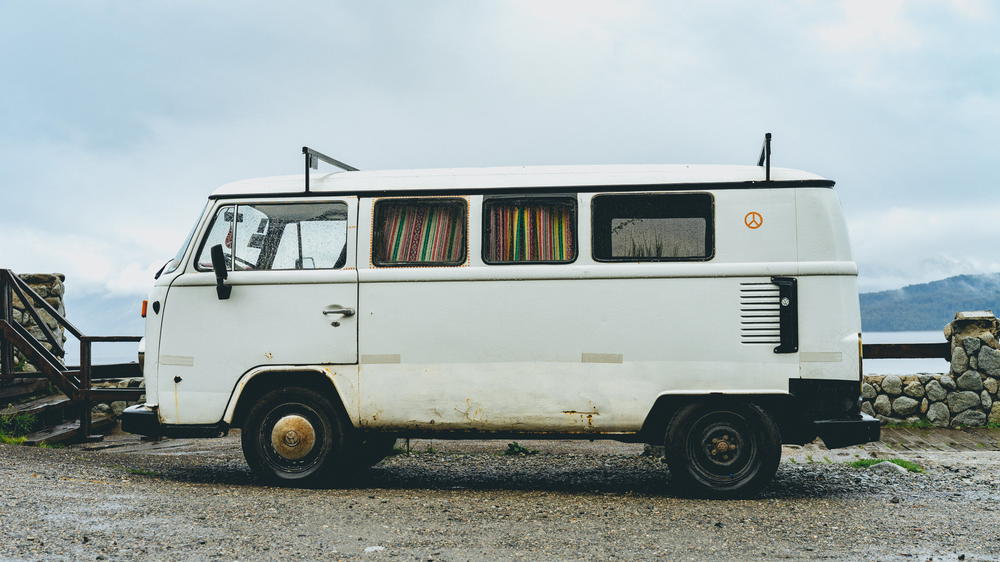
How do you prepare for a long trip abroad? Here's a list of things to do before long-term travel, including long-term travel preparation and how to prepare to travel the world for several months.
This article may contain affiliate links. We earn a small commissions when you purchase via those links — and it's free for you. It's only us (Becca & Dan) working on this website, so we value your support! Read our privacy policy and learn more about us .
Table of contents
- Selling everything and traveling for a year
- Travel with an organized remote work and travel program
- Rent on Airbnb
- Stay in a hostel
- Find a roommate from Facebook or other expat groups
- How do you do laundry when you travel?
- What if I need something specific while I’m in a new country or city?
- Get some AirTags to protect against lost valuables
- Set up travel insurance for traveling abroad
- Using Google Fi for your international phone plan
- Get set up with a bank that reimburse foreign ATM and transaction fees
- Get a credit card with no foreign transaction fees
- Create a travel first aid kit with products you trust
Fun fact: I’ve sold all my things and moved across the world to travel long-term, more than once.
I’ve packed up and left NYC twice, to travel the world and work remotely , and after traveling long-term both times, I came back!
In these experiences, I’ve learned a lot about selling the things that aren’t important, what to know before taking a long trip, traveling full-time and everything that is involved in preparing for a long trip.
I’m happy to share my knowledge and experience, because preparing for long-term travel and leaving everything at home sure doesn’t happen overnight. Here’s my step-by-step guide for a checklist for long-term travel.
First steps: What to do with your house or apartment before traveling
Figuring out what to do with your house or apartment can be tricky. It’s really different for every person, and depends on if you rent or own, and the duration of your upcoming trip.
The variables to consider are:
- How long is the trip?
- Do you rent or own your apartment or house?
- Are you planning on storing your stuff somewhere, or selling everything?
I won’t get into too many specifics about how to handle every variable, but I can go into detail about the two times that I sold everything to travel, while moving in (and then back to) New York City.
Selling everything and traveling for a year
This was a straightforward process for me, the first time. I was moving out of an apartment at the same time that I was expected to leave for my trip.
I was living with roommates, at the time, so I helped get a person to take over the lease of my room, getting someone that everyone else would get along with. I asked my roommates if they would like to buy any of my furniture.
One roommate bought my mattress. Then, I listed everything else on Craigslist, some of the best websites for selling your stuff online .
I held on to a few things that were important to me, like small keepsakes and art. Luckily, my family lives close by, outside Philly, so I was able to store a few small boxes with my parents.
In a slightly different situation, when I was living with Becca, we did a similar process together. Except, her parents (thanks, Becca’s parents!) stored some of our larger items, like a bed, two bar stools and all of our 16 plants.
We still sold most replaceable items, like four bookcases, my desk, our other bar stools, rugs and my desk chair.
We also chose to downsize, rather than throwing things out.
We gave away around six bags of clothing to a weekly clothing drive that we found out was a pop-up on Thursdays, half a block from our apartment.
This time was different because our lease didn’t quite end at the same time of when we wanted to leave to travel.
We found a close friend that was able to sublet our apartment for six weeks while we traveled for the first three months, until the lease ended.
This worked out great because we could keep most of our things in the apartment for her to use. We also knew we’d be back to do the actual move-out.
We adore our old neighborhood, Brooklyn Heights, and if you’re in NYC, we have a list of local tips and secrets for seeing this beautiful neighborhood.
When we came back to the apartment to officially move out, we knew that what we had left in the apartment wasn’t important to us, but, a lot of it went into storage at Becca’s parents’ house.
We were able to determine that some of it wasn’t stuff we missed, because we traveled for three months in Europe without all of those things!
Because of that, it was easier to part with some extra kitchen items, clothes that we weren’t wearing and other random house stuff.
The funny thing about stuff is that after it’s gone, you kind of don’t miss it.
For you, if you own your house or apartment, you can rent it out for long periods of time with no issues. I know people who’ve done this.
I’d suggest against doing several short-term rentals, like Airbnb for homes, as they can become risky and can be a lot to manage over a long period of time with all the cleaning in between guests and whatnot.
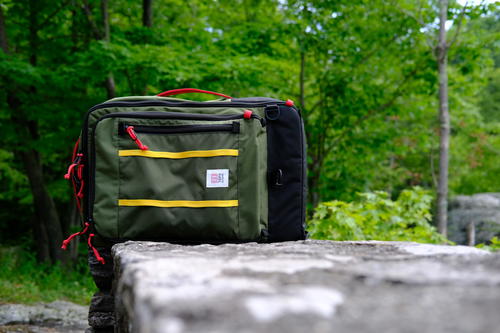
Planning for your trip: Where will you stay while you’re away?
After you’ve figured out what to do with your home, you can now move on to planning where to live while you’re away.
It’s a similar process of comparing your options for accommodation while traveling short-term, but with a few more kickers.
Depending on your situation, you may have long-term accommodations set up for you. If that’s the case, feel free to skip ahead.
Assuming that you don’t know where you’re going to live yet, don’t worry. There are a few tricks that I want to share about how to set up long-term accommodations.
Travel with an organized remote work and travel program
I’ve been on two segments of a trip with Remote Year .
It’s a great way to travel away for a while, while working remotely on your job (if you can do this) and to go with the flow, rather than doing all the logistical accommodation, flight and coworking space stress on your own.
With Remote Year, they’ll set you up with an apartment for the month. They’ll do everything from transportation to and from the airport, to apartment maintenance. Easy.
During my travels with Remote Year, I’ve had electrical issues, water issues and even a small fire [that did not start, yet one that I put out, and saved everyone]!
Remote Year (or the local apartment staff) has helped to make sure everything was safe and up to satisfying living standards.

Rent on Airbnb
When Becca and I were in Taipei, Taiwan for almost a month, we decided to rent an apartment through Airbnb.
We found that the apartments were relatively expensive in the neighborhood where we wanted to stay because it was centrally-located and close to all sorts of MRT stations.
Because we were going to be long-term guests for the Airbnb property owner, we knew that we had some wiggle room in negotiating a price.
For the owner, it’s expensive and time-consuming to turn over an apartment for lots of guests through lots of weeks.
If you, as the traveler, are able to stay in a place for a few weeks, it’s much more favorable for the owner.
Interested in saving money during your trip ?
Check this out: we sent a few messages to a few properties and told them our situation. We said that we’re coming in for a few weeks and asked if they were able to provide a special offer and discount for the long-term stay.
We got a few offers and ended up with a newer listing for almost 40% off the listed price.
This included the 12-20% discount that some owners offer for guests who stay more than two weeks. If you hunt around, you’ll also see that owners sometimes discount for stays of four weeks or longer, and some even discount if you book far in advance, like three months before your trip.
Want $50 off your first Airbnb? Sign up with this link and get an immediate credit on your first booking.

Stay in a hostel
Sometimes hostels have private rooms that seem more like apartments.
When we were in Mexico City, we stayed at the Selina Mexico City Hostel in the downtown neighborhood of Centro Historico.
This was a unique experience because our room was more like a studio apartment, but without a kitchen. It had its own bathroom and plenty of space for us, even a couch, a desk, an entrance area and a closet with shelves.
There was a shared kitchen down the hall on another floor that was different from the regular hostel kitchen because it was for studio apartment guests only.
It was tons (and I really mean tons) cleaner, had a locked door with a code and it was safe to leave our groceries in the fridge even without our names on them.
This was important for us, because you probably know by now how much we love cooking, to stay healthy while on the road .
We met several people that were living in Selina Mexico City for several months.
It’s a little more expensive than a regular apartment, but had so many more accommodation types available. Also, it came furnished, so to speak… so that comes at a premium.

Find a roommate from Facebook or other expat groups
Lastly, you can find a roommate or someone renting an apartment through local connections.
If you’re going to be living in a new city for long-term, join a few expat groups in the area. For example, we’re familiar with Medellin and we know that the expat and community for digital nomads there is very strong.
There are several Facebook groups and meetups that you can find and attend, and you’re bound to meet new like-minded people.
Another example is that our friends Cyd and Marc are currently living in Hanoi as expats.
They later told us that our friend Sean, who we know through the Remote Year network, was living with them for a bit during his digital nomad lifestyle month in Hanoi. Isn’t it a small world?
You can always rent an Airbnb or stay in a hostel private room for a few weeks to get to know the city.
During that time, you can meet local people that are looking to fill a room in an apartment elsewhere.
How to meet people in a new city when you’re traveling
So you’ve relocated to a new city and now you’re sitting alone in your room on a Friday night and don’t know what to do.
I’ve for sure done this when I’ve traveled solo or didn’t know too many people in a new city.
When you are planning on taking a new trip, you’re basically moving to a new city for as long as you plan to stay there.
So, whatever you would normally do to meet people in a new city applies for travel, as well.
You can join meetup groups, like a fitness group or a meetup for another shared interest, such as art, reading, history, culture, hiking and more.
You can reach out to your existing network and see if any of your friends have a local or expat connection to someone in your new city. You can join a coworking space and see if there are any events. The ideas are endless, and will be different depending on where you find yourself.
If you plan to be working remotely during your travels, we have a few suggestions for networking and meeting other professionals that you can check out.
How to pack for a long trip
Like most things in this article, everyone has a different situation and different style of travel. I’ll speak to my personal style and hopefully some (or all) of this will also apply to you.
I believe that if you want to pack for a year, you need the same amount of things that you’d pack for a week. You can get by with a few of your favorite shirts and extra pair of versatile travel pants .
If you have space in your new destination, you can always pick up some locally-purchased clothes. You can also ‘dump’ belongings along the way, to lighten your load. You can sell stuff online, if any of these tips for selling your stuff online may work for you.
It’s all part of the minimalist travel mindset .
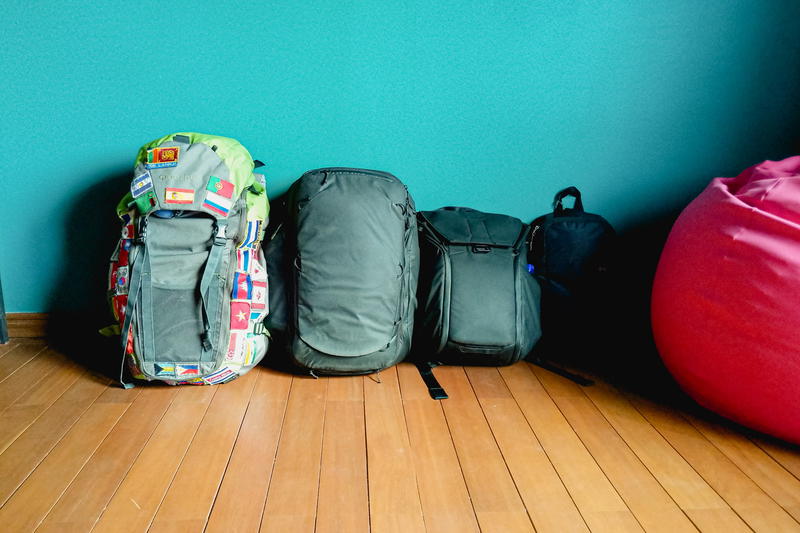
Buying local is not only a sustainable travel practice , but also supports the local economy and also makes you fit in a bit more with the local culture.
For example, locals in warm-weather countries usually wear pants all the time, and it’s only the travelers, expats and backpackers who wear shorts every single day.
If you want to start doing the local thing, look out for what locals do. That includes having a heavy-duty jacket like a winter parka if winters get cold and windy where you are headed.
How do you do laundry when you travel?
What I realized is when I’m home, I do laundry about once a week. This means that I only need about a week’s worth of clothes.
I don’t have to worry about packing 20 T-shirts and 30 pairs of underwear (even though Becca wishes she could).
You can get by with much less.
Also, isn’t it fun to try to figure out laundry machines in other countries? And also fun to see how people dry clothes all over the world? At Nine Coliving , we hung the laundry out to dry on long clotheslines on the beautiful rooftop that had a view of the town and the volcanic islands.
In Taipei , our washer turned into a dryer, but it took around an hour, and we chose to hang-dry anything that wouldn’t dry naturally in the super-humid climate.

What if I need something specific while I’m in a new country or city?
I thought that I needed to bring everything that I could think of when I left the US to take a long trip.
What I didn’t realize is that there is an entire city, somewhere else, of people that probably need the same thing. For example, if you break a phone charging cable, you can find the local version at a local market.
Unless you are traveling with medication that you can’t get anywhere, I’d think that there’s nothing that you can’t find wherever you’re going to be living long term (that is, unless you’re very particular about brands or if you have super-specific needs like name-brand whey protein or something…I’ve seen people ask about that).
Get some AirTags to protect against lost valuables
We got ourselves some Apple AirTags to bring along on our trips. AirTags can be placed on your checked luggage, backpack, laptop or even your wallet, to help be able to location-track these items if they become lost, stolen or just misplaced.
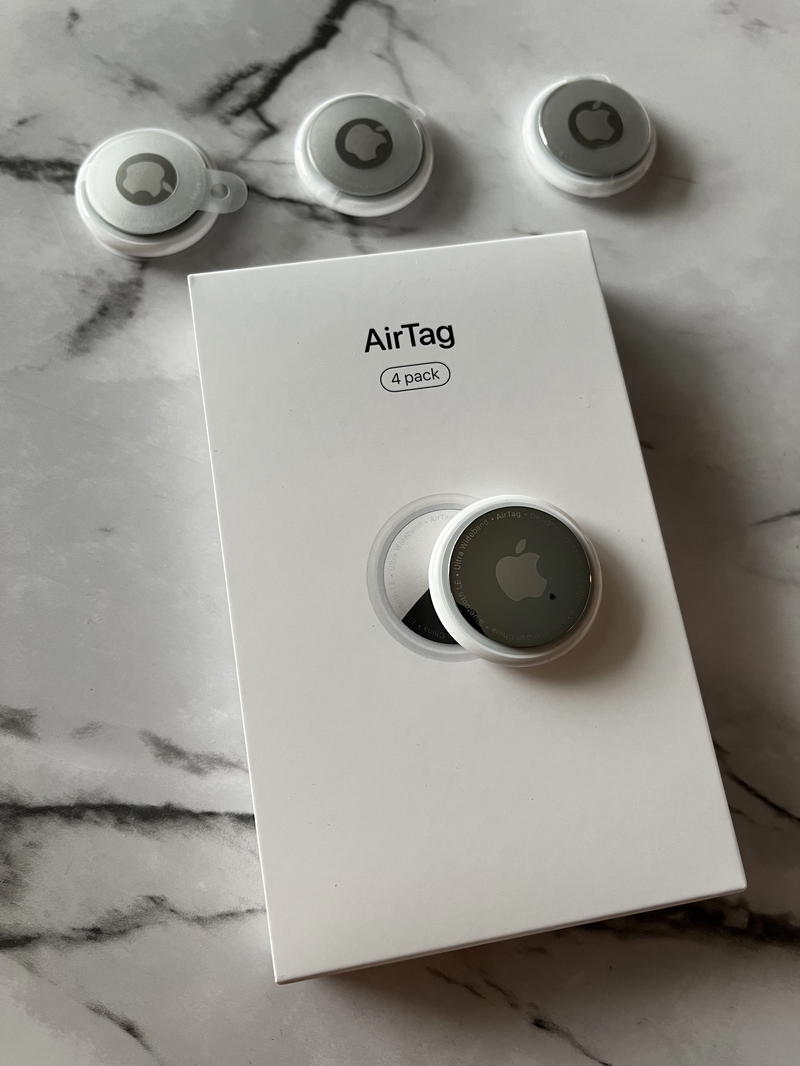
We’ve seen a lot of travelers invest in AirTags as a way of having peace of mind during long-term travel, and we’ve even seen how they work out (see our safety guide for Mexico City for the full story).
What to set up at home before traveling long-term
Set up travel insurance for traveling abroad.
Becca and I use World Nomads travel insurance to insure us on our international trips.
We’ve also heard great things about SafetyWing . Depending on your age, length of trip, destinations and a few other factors, World Nomads will give you a quote and you can choose to proceed with getting reliable travel insurance.
World Nomads will help insure things like delayed baggage, emergency medical expenses overseas, flight cancellations due to severe weather and hospitalization abroad.
If you’re a scuba diver, there are also specific insurance plans for diving. Our friends Alex and Ryan chose this add-on. You can ask them how it’s going!
We initially signed up with World Nomads based on a recommendation from a friend.
The rates are reasonable and we’ve heard that World Nomads are responsive if you ever have to make a claim. We haven’t had to make a claim yet, but we feel at ease knowing that if anything were to happen, we are covered.
Using Google Fi for your international phone plan
I use Google Fi and have data usage all over the world. You can now bring most phones to Google Fi!
Check to see if your phone is supported to get all of the amazing benefits.
I like Google Fi because it’s flexible and affordable, and it even works in places that many people would consider to be off-the-beaten-path countries . It’s about 25 USD for a phone and text plan and 10 USD per GB that we use.
Most of the time, I’m on WiFi in a coworking space and we don’t end up using that much data.
Local SIM cards are almost always cheaper. I like to have Google Fi to help navigate a new destination for a few days.
I’ll switch to a local SIM if I know that I’m going to be using a lot of data.
When Becca and I were in Taipei, we got a local SIM and tethered off of it to do work in our Airbnb because the WiFi was a little slow at times.
This goes along with a general recommendation of researching WiFi speeds, one of our best tips for remote work during travel.

Get set up with a bank that reimburse foreign ATM and transaction fees
You’ll want to take out cash, obviously, but might not want to always pay the ATM fees that go along with taking our money. It’s the worst when you have to take our large amounts of money because you’re trying to justify the fee for the ATM.
I use checking accounts from Fidelity and Charles Schwab bank. They both offer excellent checking accounts that reimburse all ATM fees domestically and internationally.
It’s been a lifesaver to pull out the equivalent of 10 USD to pay for a cab or something here and there without having to pay 3 USD in ATM fees.
See more about our recommendations for traveling with money when you’re ready to take your next trip.
Get a credit card with no foreign transaction fees
We often get asked about our moey advice for trips abroad .
For credit cards, I use the United Explorer card , which doesn’t have any foreign transaction fees. It also has a nice sign-up bonus, Global Entry reimbursement and many more great benefits.
We typically like using credit as much as we can while we’re away. We’ve found that we get the best conversion rates and don’t need to take out too much cash if we’re using credit often.
Typically, the best credit cards for getting no transaction fees might be travel credit cards that come with a fee. But, in exchange for that fee, you’re probably going to get nice benefits like 3x points or miles on travel purchases and things like that! You can see more in our guide about travel hacking with travel credit cards .
If you use a point of sale machine, make sure to use their local currency. Let your bank do the conversion and not the point of sale device!
Create a travel first aid kit with products you trust
As much as Becca and I try to not get sick while we travel, it happens. We even wrote this list of tips for avoiding being sick while traveling .
When we go away for a while, we share a travel first aid kit that has a few trusty items from home: Band-Aids, travel packets of Advil tablets, a travel-sized Neosporin, travel-sized Vaseline, a small bottle of travel illness pills and some sheets of Benadryl/antihistamines.
These things have come in very handy, especially if we’re traveling in a place where pharmacies are closed on Sundays, for example.
It’s also good to have products you know and trust in case you cannot read the language in the country where you’re traveling. Our travel-sized first aid kit has gotten us pretty far.
As a bonus tip, you can bulk up your emergency travel kit while you’re abroad. Did you know that lots of medications are tons cheaper outside the US?
Maybe you’ve realized this by now, but in case you haven’t, try grabbing antihistamines, antidiarrheals or other types of medications that are sold by local pharmacies in different parts of the world and you’ll see how affordable the prices are.
Your travel-sized health kit should only take up the size of two decks of playing cards. If it’s any bigger, it will start to feel in the way.
Remember that you can usually get help to buy medicine while you’re abroad, but in case you’re in a remote location like on a hike, take enough with you so that you’re set and not regretting bringing more medication along.
If you’re looking for more specific travel gear suggestions, make sure to check out our list of the best travel accessories to see what we use on all our trips.
You may also like
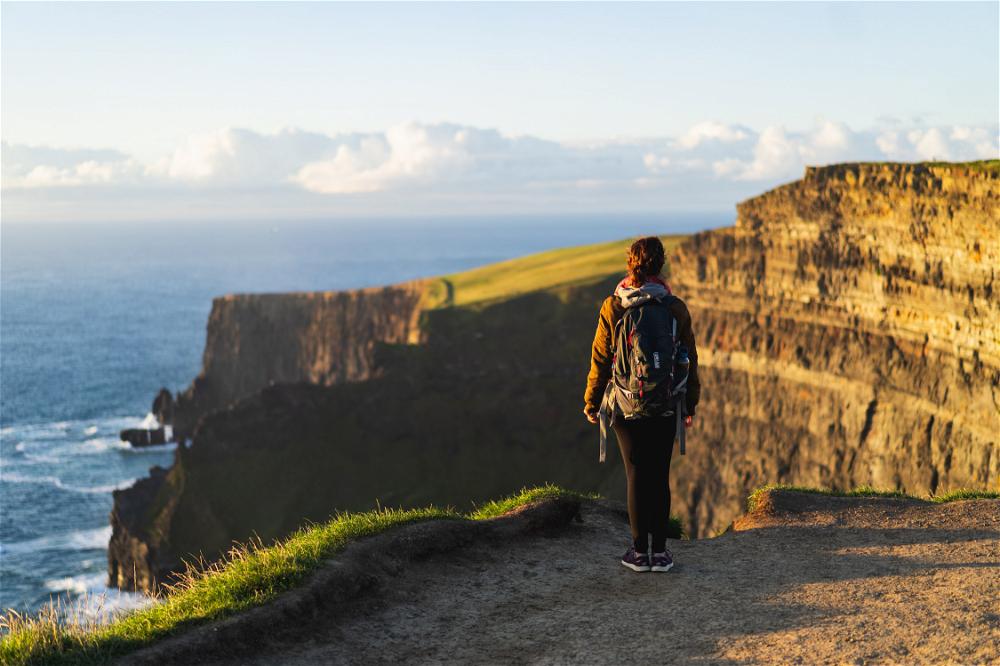
9 Minimalist Packing Tips (Smarter Packing and Planning)
How can you start minimalist travel planning and prepping? Here, we teach you our tips and tricks to pack like a minimalist, bring less stuff and choose versatile travel products.
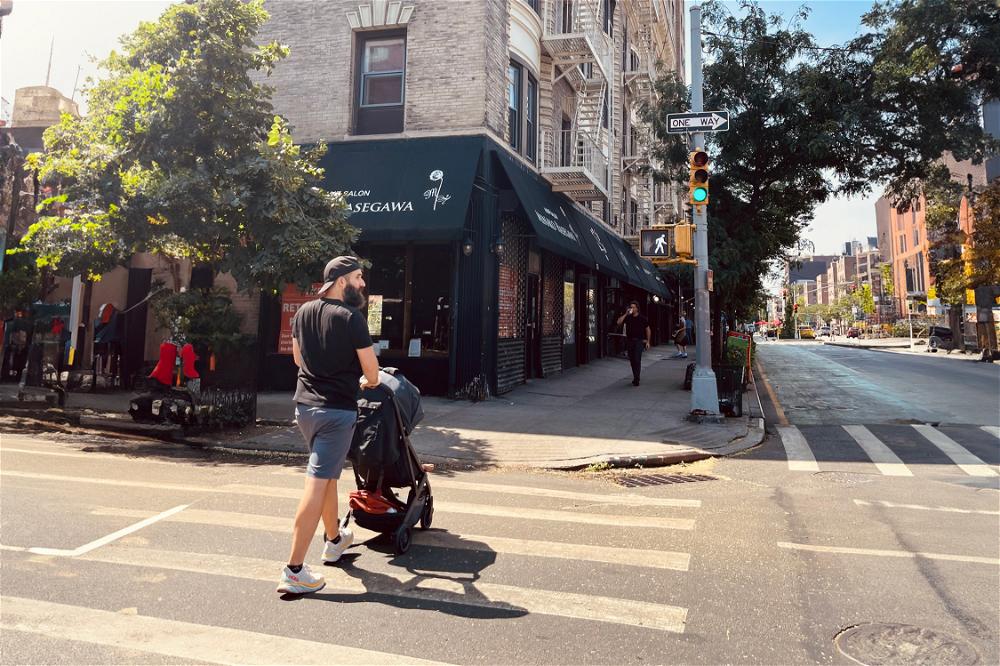
How to Plan a Trip to NYC with a Baby (What to Know)
Going to NYC with a baby for the first time doesn’t have to be hard! In our list of local tips, find out what to do and see with your baby in New York City to make the visit easy.

Top Tips for Booking Hostels (Experience from Years of Backpacking)
Booking a hostel for the first time on your trip? See my list of tips for traveling and staying in hostels, from my decade of hosteling and backpacking around the world.
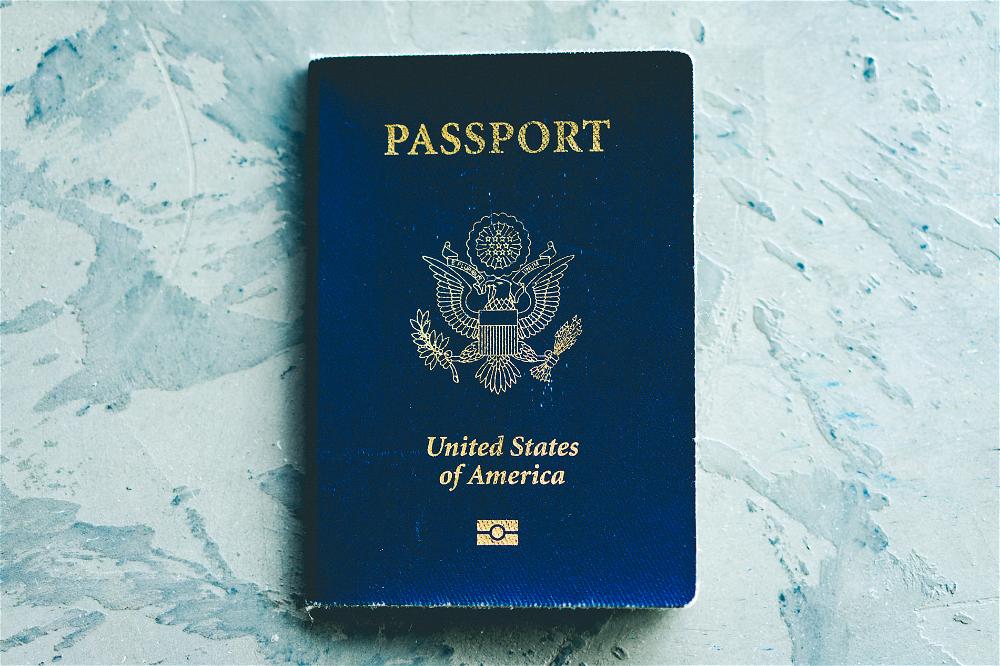
How to Know If You Need an International Travel Visa
How do you know if you need a visa to travel to another country? Getting visas can be one of the challenges of international travel. Our how-to guide will show you a few steps to determine if you need a visa for your trip.

14 Best Destinations for Gluten-Free Travel (and Where to Eat)
Is it easy to find gluten free places to eat when you travel? We have a list of some of the best and worst countries for celiacs and eating gluten-free food.

How to Feed a Baby During Travel (Nursing, Bottles, Formula & Solids)
Whether feeding your baby by nursing and breastfeeding, with bottles, formula or solids, there are lots of products to help with feeding a baby on the go. See my best travel tips for your next trip!

Hujambo ! We’re Becca & Dan.
We created this blog to share some of the knowledge and experience that we have around travel , remote work , photography and beyond!
We're currently researching the next best travel gear.
Join the club
You’ll get emails with our latest articles, tips, advice and so much more! You won't find this content anywhere else!
This website may contain affiliate links. We earn a small commissions when you purchase via those links — and it's free for you. It's only us (Becca & Dan) working on this website, so we value your support! Read our privacy policy and learn more about us .
Among other programs, Half Half Travel is a participant in the Amazon Services LLC Associates Program, an affiliate advertising program designed to provide a means for us to earn fees by linking to Amazon.com and affiliated sites.
June 1, 2020
Due to travel restrictions, plans are only available with travel dates on or after
Due to travel restrictions, plans are only available with effective start dates on or after
Ukraine; Belarus; Moldova, Republic of; North Korea, Democratic People's Rep; Russia; Israel
This is a test environment. Please proceed to AllianzTravelInsurance.com and remove all bookmarks or references to this site.

Use this tool to calculate all purchases like ski-lift passes, show tickets, or even rental equipment.

Pre-Trip Checklist: What To Do the Day Before You Travel
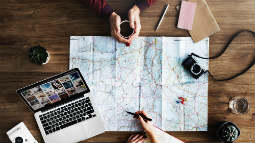
Get a Quote
{{travelBanText}} {{travelBanDateFormatted}}.
{{annualTravelBanText}} {{travelBanDateFormatted}}.
If your trip involves multiple destinations, please enter the destination where you’ll be spending the most time. It is not required to list all destinations on your policy.
Age of Traveler
Ages: {{quote.travelers_ages}}
If you were referred by a travel agent, enter the ACCAM number provided by your agent.
Travel Dates
{{quote.travel_dates ? quote.travel_dates : "Departure - Return" | formatDates}}
Plan Start Date
{{quote.start_date ? quote.start_date : "Date"}}
Share this Page
- {{errorMsgSendSocialEmail}}
Your browser does not support iframes.
Popular Travel Insurance Plans
- Annual Travel Insurance
- Cruise Insurance
- Domestic Travel Insurance
- International Travel Insurance
- Rental Car Insurance
View all of our travel insurance products
Terms, conditions, and exclusions apply. Please see your plan for full details. Benefits/Coverage may vary by state, and sublimits may apply.

Insurance benefits underwritten by BCS Insurance Company (OH, Administrative Office: 2 Mid America Plaza, Suite 200, Oakbrook Terrace, IL 60181), rated “A” (Excellent) by A.M. Best Co., under BCS Form No. 52.201 series or 52.401 series, or Jefferson Insurance Company (NY, Administrative Office: 9950 Mayland Drive, Richmond, VA 23233), rated “A+” (Superior) by A.M. Best Co., under Jefferson Form No. 101-C series or 101-P series, depending on your state of residence and plan chosen. A+ (Superior) and A (Excellent) are the 2nd and 3rd highest, respectively, of A.M. Best's 13 Financial Strength Ratings. Plans only available to U.S. residents and may not be available in all jurisdictions. Allianz Global Assistance and Allianz Travel Insurance are marks of AGA Service Company dba Allianz Global Assistance or its affiliates. Allianz Travel Insurance products are distributed by Allianz Global Assistance, the licensed producer and administrator of these plans and an affiliate of Jefferson Insurance Company. The insured shall not receive any special benefit or advantage due to the affiliation between AGA Service Company and Jefferson Insurance Company. Plans include insurance benefits and assistance services. Any Non-Insurance Assistance services purchased are provided through AGA Service Company. Except as expressly provided under your plan, you are responsible for charges you incur from third parties. Contact AGA Service Company at 800-284-8300 or 9950 Mayland Drive, Richmond, VA 23233 or [email protected] .
Return To Log In
Your session has expired. We are redirecting you to our sign-in page.
Up and away with the Iowa State University high-altitude balloon course and a solar eclipse

Early spring snow clung to the tree branches surrounding the Howe Hall parking lot as a dozen Iowa State University students began filling a high-altitude balloon with hydrogen just after dawn on Saturday, March 23.
They popped the hood of a sport utility vehicle and attached the battery to a laptop they use to predict and track the balloon’s movement. They blocked off several adjoining parking stalls and wheeled in a cart carrying a heavy tank filled with hydrogen gas.
Then they attached a hose to the base of the balloon and started the painstaking inflation process.
“Start flow. Give me 20 PSI,” said Kellan French, an Iowa State University senior in aerospace engineering from Weeping Water, Nebraska, after he secured the hose to the balloon. Air started flowing from the hydrogen tank into the balloon with a hiss.
“Boost me up to 40,” French called a few moments later. “Then slowly go up to 80.”
At first, the balloon looked like a flat sheet, but it inflated as the minutes ticked by, taking on the shape and color of an enormous egg standing on its narrow end. The pale sky was clear and the wind minimal, which meant the conditions were right for launch, frosty temperatures notwithstanding.
More: Reiman Gardens prepares for thousands of tulips to bloom in April
With the balloon fully inflated, the team members counted down from five and French released the balloon. It ascended into the cloudless sky, carrying a payload of electronics capable of sending and receiving radio signals. It remained visible for several minutes, a pale dot rapidly receding into a sea of blue, but it soon reached an altitude beyond the team’s ability to track with the naked eye.
The High Altitude Balloon Experiments in Technology ( HABET ) course at Iowa State University conducts a handful of these balloon launches each semester. The balloons allow them to gather data at the highest reaches of Earth’s atmosphere. They’ll follow the recent launch with perhaps their most anticipated experiment yet on April 8, when they travel to Illinois to launch a balloon during the upcoming total solar eclipse that will cross North America.
The March 23 launch helped the team members improve their familiarity with the gear and procedures they’ll use during the eclipse to make sure they get the most from the experience, said team leader Brody Echer, a senior in information management systems from Huxley.
“Launching a balloon is a really satisfying experience when everything works the way you plan,” Echer said. “It’s a team effort, and you learn something new every time.”
More: Ames' new renaissance faire will have fire-breathing and sword-fighting. When does it start?
Nearly outer space
The March 23 balloon launch reached an altitude of around 77,000 feet. Other balloons used by the students can reach even higher than that, to around 130,000 feet.
That puts the balloons above 99% of the Earth’s atmosphere.
It’s not quite outer space, but it’s close, said Matthew Nelson, assistant teaching professor of aerospace engineering and director of the Make to Innovate program, which encourages students to pursue solutions to real-world aerospace challenges. Nelson serves as the ballooning team’s director, and Make to Innovate manages the course.
“Reaching space is expensive. Launching something into outer space costs millions of dollars. With high-altitude ballooning we get access to near space at a fraction of the cost,” Nelson said. “These balloons get so high up, you can see the curvature of Earth and the blackness of space. We’ve done some really cool experiments at those altitudes.”
The team has tested how the near vacuum conditions of the upper atmosphere affect instruments. They also collect data on atmospheric conditions and light.
The balloons expand as they ascend and eventually burst. When they do, a parachute opens and carries the equipment safely to Earth. It can take a couple of hours for the payload to return to the ground, and winds can carry the parachute for miles. The team utilizes software that predicts where the parachute will land, and they send a recovery team to retrieve the equipment.
The March 23 launch landed about 61 miles southeast of Ames near Malcolm.
The team files a form with the Federal Aviation Administration before every launch to make sure they have permission to access the airspace.
More: Innovation at work: Iowa State's Research Park paving the way to success with soybean additive
Preparing for the solar eclipse
On Monday, April 8, the moon will pass between the sun and the Earth, blocking out the sun across a major stretch of North America. The HABET team will travel to Carbondale, Illinois, for Monday’s total solar eclipse so they can launch a balloon into the path of totality to take readings on how an eclipse affects conditions in the upper atmosphere. The team will join a NASA-led network of high-altitude balloons recording data during the eclipse.
The balloon will take readings on temperature, air pressure and humidity to see how those variables fluctuate before, during and after the solar eclipse at different layers of the atmosphere. They’ll also livestream video of the eclipse from their balloon.
Seven team members will make the trip along with Nelson.
The team has deep ties with NASA and bases many of its operational procedures on how NASA conducts balloon experiments. Some of the team’s funding comes from the Iowa Space Grant Consortium , which connects Iowans with NASA-relevant research opportunities and internships. Iowa State University is a core member of the consortium.
Iowa Space Grant Consortium Director Sara Nelson said HABET trains students to aim high and explore science, technology, engineering and mathematics.
“What they do with the balloons is hands-on innovation training,” Nelson said. “They’re taking what they learn in class and applying it in creative ways. The students that come here get the unique experience of literally seeing their work launched into near space.”
Fred Love covers design, student affairs, the Iowa State lectures program and Reiman Gardens for the Iowa State News Service. This piece can be found on the Iowa State News Service website.
Preparing for the 2024 Solar Eclipse: Your Ultimate Guide
Here's your ultimate guide on preparing for the 2024 solar eclipse, complete with tips, hacks, and must-have products.
Dominique Jackson • Apr 5, 2024

2024 is a celestial treat for avid travelers and stargazers: a mesmerizing solar eclipse! This awe-inspiring event, where the moon passes between the Earth and the sun, promises a breathtaking spectacle. The solar eclipse will take place on April 8th, 2024. Proper preparation is essential to ensure you make the most of this rare cosmic occurrence. Here’s your ultimate guide on preparing for the 2024 solar eclipse , complete with tips, hacks, and must-have products.
Research Your Viewing Location
First, start by researching the best locations to witness the 2024 solar eclipse. Websites like Eclipse2024.org can provide detailed maps and information about the path of totality, duration of the eclipse, and optimal viewing spots. Choose a location with clear skies and minimal light pollution for the best possible experience.
Next, mark your calendar and plan your trip well in advance. Solar eclipses are highly anticipated events, and accommodations in prime viewing areas tend to fill up quickly. Aim to arrive at your chosen destination at least a day before the eclipse to avoid any last-minute rush or travel delays.
Protect Your Eyes
With proper eye protection, only look directly at the sun during a solar eclipse. Invest in certified solar viewing glasse s to safeguard your eyes from harmful solar radiation. These glasses are designed to filter out the sun’s intense light, allowing you to observe the eclipse safely. Remember to check for any scratches or damage on your glasses before use.
Equip Yourself
Furthermore, pack essential items for eclipse viewing, including a sturdy tripod to stabilize your camera or binoculars, a solar filter for your camera lens, and a portable solar charger to keep your devices powered throughout the day. Bring plenty of water, snacks, and sunscreen to stay hydrated and protected from the sun’s rays.
Practice Photography Skills
Practice photography techniques beforehand to capture the magic of the 2024 solar eclipse with your camera or smartphone. Experiment with different exposure settings, focal lengths, and composition angles to capture stunning eclipse photos. Consider using a remote shutter release or timer function to minimize camera shake and blur.
Stay Flexible
Weather conditions can be unpredictable, so be prepared to adapt your plans accordingly. Have a backup viewing location in mind if your original spot is clouded or obscured. Stay informed about local weather forecasts and be ready to relocate if necessary to maximize your chances of witnessing the eclipse.
Consider Joining a Guided Tour
For a hassle-free eclipse viewing experience, consider joining a guided tour led by experienced astronomers or tour operators. These tours often include transportation, accommodations, and expert guidance to prime viewing locations. You’ll also have the opportunity to learn about the science and significance of solar eclipses from knowledgeable guides.
Embrace the Moment
As the 2024 solar eclipse unfolds, take a moment to soak in the experience fully. Feel the excitement and wonder of witnessing this rare cosmic event with fellow travelers worldwide. Cherish the memories and reflect on the profound beauty and mystery of the universe.
Preparing for the 2024 solar eclipse requires careful planning, proper equipment, and a sense of adventure. By researching your viewing location, ensuring eye safety, packing essential gear, and staying flexible, you can maximize your chances of experiencing this extraordinary celestial phenomenon. Whether you’re a seasoned eclipse chaser or a first-time observer, witnessing a solar eclipse is a truly unforgettable journey that will leave you in awe of the wonders of the cosmos. So gear up, protect your eyes, and prepare for the celestial adventure of a lifetime!
Subscribe to travel noire
Get more travel content
Subscribe to Travel Noire, a free daily newsletter that features the best of travel, destinations, and guides to the cities you love from a new point of view — yours.
By subscribing to this newsletter, you agree to our terms of service and privacy policy.
Popular posts
Trending stories in world travel
Here’s How the 2024 Solar Eclipse Will Impact Air Travel
Meghna Maharishi and Elizabeth Casolo, Skift
April 4th, 2024 at 8:51 AM EDT
The solar eclipse will have a minimal impact on air travel, but airlines are operating a slew of flights that will give flyers a special view of the once-in-a-lifetime event.
Leading up to April 8, cities in the eclipse’s path of totality prepare for an influx of tourists. But, even with some extra traffic for airports and airlines, operations likely won’t look too different.
Skift named April’s eclipse “this year’s top travel phenomenon,” with cities such as Buffalo, Indianapolis, and Dallas gearing up for the big day. Some airlines offered specialized experiences for eclipse travel, and tourism bureaus coordinated events to celebrate the evening.
With these plans in place, those flying in may wonder about what to expect in the air.
Will There Be Any Travel Disruptions?
It’s possible. The Federal Aviation Administration warned of potentially higher traffic at airports in the eclipse’s path.
“Traffic should anticipate delays during peak traffic periods,” the FAA said in a statement .
Some airports did not express concern about incoming travelers but still plan to take precautions. The Niagara Frontier Transportation Authority operates the Niagara Falls International Airport and Buffalo Niagara International Airport, two airports on the eclipse path. NFTA Aviation Deputy Director Russell Stark said air traffic control is preparing for more traffic, but the airport itself has not observed more traffic than usual.
“We have not seen any increase in the traveling public coming via airplane,” Stark said. He expressed concern about the roadways beyond the airport and does not have enough information to know if air traffic from other airports would impact arrivals or departures.
A spokesperson from Dallas Fort Worth International Airport also did not have clarity on the airport traffic, but “the airport’s rental car partners… expect to have the busiest days on record for car rentals around the time of the eclipse.”
Other than the special eclipse flights run by certain airlines, Indianapolis International Airport does not foresee a big change in operations. The airport estimates the highest traffic period will be April 9, as people leave the morning after the eclipse.
“Nearly 20% of our traffic on Tuesday, April 9, will be departing by 7 a.m.” said Megan Carrico, director of public affairs for the Indianapolis Airport Authority.
So, while there may be more air traffic congestion in the hours after the eclipse, expect busier roads in cities along the eclipse’s path, as well.
What Are Airports Doing to Prepare for the Eclipse?
The FAA advised airports to minimize procedures that could take attention away from potential traffic. The agency said pilot training operations at airports may either be “extremely limited” or “possibly prohibited” during the eclipse.
“The bottom line is it’s ‘operations normal’ around here with a few minor changes on our part,” Stark said. Stark emphasized that contractors working on projects around the airport need to prioritize eclipse safety, something that’s been incorporated into their daily briefings. NFTA employees also have access to eclipse glasses in case they work outside during that time.
Carrico said Indianapolis International Airport will apply its experience handling traffic from major sporting events during the eclipse. The airport also partnered with art students and Visit Indy to make decorative posters commemorating the event.

Is It Safe to Fly in the Middle of a Solar Eclipse?
Yes. Whenever a plane is in the path of a solar eclipse, the sky will look dark for a few minutes. A solar eclipse doesn’t interfere with an airline’s operations — it’s almost no different than flying in the night, said Dr. Frederic Bertley, the CEO of the Center of Science and Industry, a museum in Columbus, Ohio.
“It shouldn’t impact how the aircraft itself will fly in terms of solar radiation or flares or darkening of the skies,” Bertley said.
A solar eclipse wouldn’t impact a pilot’s ability to fly an aircraft, either.
“It’s really from an aircraft and a pilot’s viewpoint,” Bertley said. “It’s just a matter of light versus less light. That’s all it is.”
The Air Line Pilots Association said pilots could expect to see skies as dark as night if they are flying in the path of totality. Otherwise, travelers on flights further away from the path may see a dusky sky.
Can I Experience the Eclipse From a Plane?
Yes. While many may purchase solar eclipse sunglasses to view the event from the ground up, witnessing it on a plane can also have its benefits.
The main advantage of viewing an eclipse from a plane is that it’s above cloud cover, which could offer the clearest view. Bertley said around 40% to 60% of the country that’s in the path of totality will most likely have some cloud cover.
And while someone on the ground might see an eclipse for a mere two to three minutes, a passenger on a plane in the path of totality could possibly view the eclipse for as long as six-and-a-half minutes.
This is because a plane flies at around 500 miles per hour while the eclipse moves at 1,000 miles per hour, which essentially gives passengers the ability to see 50% more of the eclipse, Bertley said.
However, for passengers on flights that are in the path of the eclipse, where you sit on the plane to view the eclipse matters. For example, if a traveler is on a flight leaving from Texas that goes along the path of totality from west to east, that traveler would need to sit on the right side of the plane to view the eclipse. Passengers sitting on the left side in this instance won’t see the eclipse. According to a spokesperson at Delta Air Lines, though, the airline is working with the FAA to approve S-turns on its special path-of-totality flights, ensuring both sides of the plane can view the eclipse.
American Airlines also said it was working with the FAA to ensure smooth operations and was anticipating increased air traffic at locations in or near the path of totality.
Delta offered a special flight from Austin to Detroit that covers the path of totality. After this flight sold out in under 24 hours, Delta started offering a flight from Dallas Fort Worth to Detroit . United Airlines is offering a slew of flights from Chicago and Houston that will allow travelers to catch a glimpse of the event. And Southwest Airlines has flights departing from Dallas Love Field, Austin, and St. Louis in the eclipse’s path.
The Daily Newsletter
Our daily coverage of the global travel industry. Written by editors and analysts from across Skift’s brands.
Have a confidential tip for Skift? Get in touch
Tags: ALPA , austin , dallas/fort worth international airport , delta air lines , faa , solar eclipse , southwest airlines , united airlines
Traveling through the Austin airport for the solar eclipse? Here's how to plan.
Travelers will flood the state of Texas to catch the total solar eclipse on Monday afternoon.
This means that Austin-Bergstrom International Airport is preparing for a "high volume" of travelers during the solar event.
Whether you are flying in or picking someone up from the airport, here is everything you need to know about traveling in Texas during the eclipse.
What will traffic be like in Austin, Texas, for the solar eclipse?
Prepare for heavy traffic on roads around the Austin-Bergstrom International Airport. Presidential Boulevard is the main entrance to the Barbara Jordan Terminal. If it is busy, drivers can use Spirit of Texas to access the terminal instead, according to a news release from the Austin airport. Travelers should plan to spend more time than usual in traffic due to congested major highways and roadways across Central Texas.
Busy times will be 8 a.m. April 9 on Highway 71, north of the airport. So leave the house with plenty of time to spare.
"Airport roadways will be busy and congested and could contribute to delays for passengers and staff getting to the airport," according to the news release.
More: Cloud coverage will 'most likely' impede eclipse viewing in Texas, NWS reports
Will there be flight delays for the solar eclipse?
Possibly, the Austin airport warned of flight disruptions in air travel due to recently issued air traffic procedures by the Federal Aviation Administration for the eclipse. This could cause delays or changes to flights.
Expect lines for rental cars, airline ticket counters and security screening checkpoints. Build this additional time into your travel plan.
"AUS is prepared to utilize every square foot of the terminal to ensure a safe and smooth operation," according to the news release. "Extra Department of Aviation staff will be in the terminal to provide assistance to passengers and to help keep ticket counter and security screening lines organized."
More: Where to buy solar eclipse glasses, according to the experts
Can I still get a rental car at the airport for the solar eclipse?
Rental cars will be in high demand due to the nature of the event. Visitors will drive into Austin and fly out after the eclipse is over. The airport expects a high volume of rental car returns at the Rental Car Facility, making lines and wait times longer. Rental agencies are "100% booked" for available rentals on the day of the eclipse. They are also expected to be booked on April 9.
"The Department of Aviation is working with our rental car operators to support their operations contingency plan," according to the press release.
More: Austin airport's rental car agencies are '100% booked' for eclipse
Where to drop off passengers at the Austin airport?
Drop-off can happen at the upper departures or the lower arrival levels of the airport. The airport recommends dropping passengers off at whichever location is least congested.
Tips for traveling during the solar eclipse
- Get to the airport early: Plan to arrive at least two and a half hours before departure for domestic flights. International flights should arrive at least three hours in advance. If you have to return a rental car, check luggage or have a large group, plan to arrive even earlier than the two-and-a-half-hour early recommended arrival time.
- Keep traffic conditions in mind: Roadways outside of the airport will also be congested. Austin-Bergstrom airport recommends allowing for extra time while traveling to the airport.
- Returning a rental car: Rental cars must be returned by the renter in person at the Rental Car Facility. Plan to wait in line and allow for extra time on April 9 at the car drop-off.
- Getting assistance: There will be additional aviation staff on the day of the eclipse and after to provide support to travelers. You can also call the airport at 512-530-2242 if you need any assistance. The airport also will provide real-time updates via its X account .
Eclipse towns have two big concerns: Traffic and port-a-potties
Small towns are pulling off logistical feats to welcome a boom of visitors for the solar eclipse.
As people across North America prepare to look up at the sky on April 8 — when the moon will stand between the sun and the Earth in a rare total solar eclipse — officials in Bandera County, Tex., are thinking about one very down-to-Earth thing: traffic.
County officials have been planning for the eclipse and the thousands of visitors it will draw to their Texas county for upward of three years. Bandera County falls entirely in the path of totality — a narrow, 115-mile-wide arc cutting across 15 states , stretching from northern Mexico to Maine.
How would an area with a population of some 24,000 accommodate an influx of tourists, their business and their cars?
“In October, we did a trial run of what we’re going to do in April, and at all of the major intersections, we put deputies to direct traffic when needed,” said Jack Moseley, a county commissioner.
Cities across the path of totality have been coordinating tourism campaigns, launching promotional events and setting up countdown clocks over the past year ahead of what the Great American Eclipse website predicts could be one of the largest mass travel events in the country. But planning for a boom in visitors in a place like Dallas or San Antonio (also in or near the path of totality) and a place like Bandera is very different.
No port-a-potties, no cell service
Without the infrastructure and resources of a large metropolis, officials in small counties and towns say preparing for the larger-than-life astronomical phenomenon requires attention to very human, somewhat banal details.
2024 total solar eclipse

“All the port-a-potties in the county are booked,” said Johanna Johnston, the event coordinator for Maine Eclipse and the executive director of Southern Aroostook Development Corporation.
Johnston and her colleagues in Aroostook County, Maine, began preparations for the eclipse nearly three years ago. The path of totality includes a large swath of the county, including Houlton, the county seat, where many out-of-towners are expected to congregate. Johnston’s conservative estimate is that Houlton will see about 10,000 visitors — more than double the town’s population of about 4,000. It’s a flood of bodies Johnston said the area hasn’t seen since a 1997 Phish concert . Hotels and rental homes through services such as Airbnb have been booked up for months , schools are closing for the day, and locals have been warned to complete any necessary errands the week before.
“All the port-a-potties in the county are booked”
County resources will be stretched thin in the days leading up to and after the eclipse, meaning emergency services, police and firefighters have to be strategically allocated. Emergency management teams have procured extra cellphone towers for the county in the event that an overload of users downs connections and people need to contact 911.
“Our county services are very limited. The state patrol, the sheriff’s department, they’re all going to be having to spread their resources throughout the entire county. They can’t just concentrate on Houlton,” she said. “So as far as safety and security, we’re just dependent on the Houlton Police Department, which is very small.”
In Bandera County, crews are making do with even fewer resources.
“Cellphones probably will not be working because of the amount of people,” Moseley said. “As a matter of fact, in a large part of the county, cellphones don’t work anyway.”
Police stationed at major intersections will be equipped with radios to reach the main office in the case of an emergency, and people will be directed to those intersections for service. The county also doesn’t have its own fire department; Bandera relies on nine volunteer departments, four of which will be equipped with more ambulances on eclipse day.
With only one major grocery store in the county, officials have been encouraging residents to get whatever they might need for several days, pick up any prescriptions and fill up their tanks well ahead of time.
“We ask and will continue to ask the citizens to take care of any gasoline purchases, any food purchases — not to stock up, but just be cognizant of it — by the Wednesday prior to the eclipse, because it may be the following Wednesday before we can be fully serviced,” said Patricia Moore, executive director of the Bandera County Convention & Visitors Bureau.
Gassing up early
To avoid clogged roadways on the day of, Bandera’s RV parks and rentals are pushing folks to make a weekend out of the eclipse experience and book campgrounds for three to four days. But Moore said she has some concerns about the true “eclipse chasers,” who may travel around that morning in search of the clearest skies. (Even after years of preparation, the weather is one thing officials won’t have any control over.)
“We as Texans know our weather; it was very cloudy this morning, and right now it’s gorgeously sunny, and that’s a common occurrence for us,” she said. “The other people that are coming in, if they wake up and it’s cloudy that morning, they’re going to try and go somewhere else. Our roadways are very rural, and that migration could be a challenge, not just for us, but for everyone in the region.”
In Fredericksburg, Tex. , a city north of Bandera, crowd estimates for the eclipse range from 50,000 to 150,000. Sean Doerre, the public information officer for the city, said that, when planning for the eclipse began three years ago, officials decided to focus on crowd management and logistics rather than marketing and tourism — trusting that the crowds would come.
Fredericksburg sits in the heart of Texan wine country, so officials are largely relying on the promotions and special events of local wineries to draw visitors as they concentrate their efforts on the tedious details of crowd management.
Like many other small towns ahead of this eclipse, Fredericksburg formed an eclipse task force that met with local officials from other small cities and counties that navigated the 2017 eclipse about best practices. “It was really about focusing on those most basic needs — so trash, extra restrooms, designated public viewing areas — so you don’t have people running all over town looking for the best place to watch,” Doerre said.
Erie, Pa., has taken a bit of a different approach. It’s the fifth-largest city in the commonwealth and may become the third-largest, population-wise, on April 8 with the eclipse visitors. Christine Temple, the director of communications for VisitErie , said that it’s been an all-hands-on-deck approach — involving layers of coordination with state and city police, the Pennsylvania Transportation Department and local school boards — but that officials have tried to get the residents excited about the day, too, while also preparing them for inevitable inconveniences.
She and her colleagues launched a local initiative called SHINE — an acronym for “schedule your appointments, have a plan, inform yourself and others, navigate traffic and enjoy.” While she said there are always going to be naysayers who won’t take the warnings seriously or get into the spirit of the day, by and large, residents and especially local businesses have been looking forward to their town’s chance in the spotlight, so to speak.
“It’s been such a community, a cohesive process, that it’s been kind of cool to watch,” said Temple, who was born and raised in Erie. “We sometimes get a bad rap; people think that there’s nothing to do here unless you come up for the beaches. … I would really love for a lot of these people that are first-timers to our area, that they’re pleasantly surprised by what they find and that they come back.”
For Johnston in Maine, this will be the first eclipse she’s experienced, and she said she’s enjoyed going into local schools and community groups with “cheesy PowerPoints” to get her community excited about this rare day. But with the nitty-gritty planning — mapping traffic patterns, organizing stakeholder meetings and ordering port-a-potties — it’s been easy to lose sight, literally, of some of that excitement herself.
Asked what she’s most looking forward to about April 8, Johnston joked: “the end of it.”
Colleen Grablick is a writer based in D.C. Find her on X: @colleengrablick.
A total solar eclipse will pass across the United States on Monday, April 8. See what the eclipse will look like in your city .
Path of totality: Our interactive visual map allows you to traverse the eclipse’s path from Mexico to Maine. If you’re traveling for the eclipse , we rounded up the top things to do in several major cities prime for viewing. In Carbondale, Ill., lucky residents are preparing to experience totality for the second time in seven years .
Preparing for the eclipse: The most important thing you’ll need is eclipse glasses — here’s how to get them and avoid buying fakes . If you want to capture the magic of the moment, check out our guide for photographing the eclipse with your phone. Here’s what to expect in terms of cloud cover and eclipse traffic .
The science: This eclipse may be especially dramatic because the sun is at its most active period in two decades. In the past, solar eclipses have helped scientists learn more about the universe . Here’s everything else you need to know about the solar eclipse.

Up to a million people expected to travel through Kentucky during April 8 solar eclipse
by Sydney Keller

PADUCAH, Ky. (WZTV) — Kentucky officials discussed traffic concerns ahead of the April 8 Total Solar Eclipse on Friday.
Officials with the Kentucky Transportation Cabinet's Paducah office are warning Kentucky residents and those traveling through the state to expect traffic on interstate systems, connector roads and local streets.
"We anticipate that there could be an influx of traffic that leaves directly after the totality ends," Kentucky Transportation Cabinet (KYTC) District 1 Chief Engineer Kyle Poat says.
Officials said the totality is around 2-3 minutes in western Kentucky, meaning traffic is expected to ramp up right after the main event.
The KYTC says it's possible to have up to a million people to be traveling through Kentucky on Monday as they head to other viewing sites in Illinois, Indiana and Ohio.
ALSO SEE | Up to 500,000 people expected to travel to Ohio for April 8 solar eclipse
"We fully anticipate that there will be a lot of travelers that are traveling through Kentucky to get up to those areas," Poat says.
Officials urge the public to treat the viewing of the solar eclipse as a huge sporting event or a large concert, where an influx of traffic is inevitable.
"One of the things we are encouraging people to do is bring plenty of patience," Kentucky Public Information Officer Keith Todd says. "The other thing we are telling people to do is don't forget the patience..."
See the following tips to prepare for the April 8 total solar eclipse:
- Have your vehicle fully fueled up
- Have water and snacks available in your vehicle
- Leave early or stay longer than eclipse totality to avoid traffic , if possible
- Arrive early to viewing areas to ensure you have a safe spot to see eclipse
- Have proper eyewear for safety and protection against solar eclipse
Hear from Kentucky Governor Andy Beshear on the April 8 eclipse below (Timestamp 31:15) :
More information on the solar eclipse from the KYTC can be found here .
Get reports like this and all the news of the day in Middle Tennessee delivered to your inbox each morning with the FOX 17 News Daily Newsletter.

Erie County reminds residents to prepare for the Total Solar Eclipse on April 8, 2024
Arrive early, stay put, and leave late to avoid traffic congestion.
On April 8, 2024, residents of Erie County will experience a total solar eclipse. The last total solar eclipse in New York State was nearly 100 years ago. With such an exciting and rare event, Erie County wants to ensure community members are safe and prepared for the eclipse .
A total solar eclipse occurs when the Moon passes between the sun and the Earth, completely blocking the face of the sun. Since eclipses are rare phenomena, Erie County expects a large influx of tourists and visitors, with the projected number of visitors nearing one million people.
Eclipse tourism will increase the chance of congestion and traffic and h eavy traffic may cause travel delays and detours. For the safety of everyone in Erie County, residents need to plan ahead. Residents should celebrate the eclipse from their own homes. As long as the skies are clear, visibility should be good from most locations. If residents choose to travel, it is crucial to arrive early to events, stay put for the eclipse, and leave late to avoid causing significant congestion.
Erie County encourages residents to prepare in advance for the eclipse through the following considerations:
- Plan travel ahead of time. Try to arrive early to viewing locations, utilizing public transit or carpooling if possible. Stay put for the duration of the eclipse, and plan on leaving late from viewing events.
- Stay informed on traffic patterns. Increased congestion and potential accidents mean traffic may change frequently. Visit 511wny.org to stay updated.
- Create a communication plan. Increased cell phone usage in the area can burden cell networks. Text when possible and create backup plans for communicating with family members.
- Pack accordingly. Erie County's weather can be unpredictable in early April, so residents should consider preparing for wet, cold, or hot conditions. To make an eclipse experience more enjoyable, consider bringing camping chairs, jackets, water, snacks, and first aid supplies.
- Prevent medication emergencies. Check your medication stock regularly and call your pharmacy if running low. Keep your medication with you if traffic delays get you stuck somewhere longer than anticipated.
“We want to make sure that everyone enjoys the eclipse, and eye safety is essential for making that happen,” said Commissioner of Health Dr. Gale Burstein . “Eclipse safety glasses are necessary during the partial phases of the eclipse. Looking directly at the sun without these glasses can damage your eyes and cause permanent retinal burns. Symptoms of retinal burns include a loss of central vision or distorted vision, and anyone experiencing symptoms should seek professional treatment.”
Erie County urges residents to get eclipse glasses in advance of April 8. Solar eclipse glasses must have an ISO 12312-2 safety standard. It is essential to ensure that eclipse glasses are not scratched or damaged. Sunglasses are not an acceptable substitute for solar eclipse glasses. Camera lenses, binoculars, and telescopes are only safe for looking at the sun if equipped with special-purpose solar filters, even if wearing eclipse glasses.
Eclipse viewers must wear solar eclipse glasses during the eclipse's partial phases. For Erie County, the partial eclipse begins at 2:04 pm. Totality, from 3:18 pm to 3:22 pm, is the only time eclipse glasses do not need to be worn. From 3:22 pm onwards, eclipse viewers must wear eclipse glasses again. Parents must supervise children to ensure that eclipse glasses are correctly worn.
Impaired and Distracted Driving
Make sure everyone gets home safely from eclipse activities. Drivers who are impaired by alcohol, cannabis, illicit drugs or some prescription or over-the-counter medicines can cause vehicle accidents that lead to traumatic injury, property damage and death. Distracted drivers who are texting, checking map directions or making phone calls while driving can also cause devastating accidents. If you are planning to drive on April 8, drive cautiously and courteously; know your route to and from your destination; plan for delays and potential detours. If are planning to use an impairing drug or substance, plan ahead for a responsible driver. Do not let friends drive if they are under the influence of an impairing drug. Don’t make or answer calls or texts while driving; if you need to talk or text, pull over to a parking lot or other safe space off the roadway. And, always wear your seatbelt.
2-1-1, 3-1-1, 5-1-1 and 9-1-1
2-1-1 WNY is available 24/7 for free referrals to health and human services and other basic needs. 3-1-1 is a service for city of Buffalo residents to get information about city services and share complaints. 3-1-1 will be open on April 8. 5-1-1 NY (phone) and 511ny.org have current traffic conditions and delays statewide.
ECDOH has compiled a list to remind people when to call 9-1-1, and when not to call 9-1-1. ( https://www3.erie.gov/health/sites/www3.erie.gov.health/files/2024-03/urgentcare911.pdf )
When to call 9-1-1:
- Breathing difficulty /shortness of breath/breathing has stopped
- Choking (cannot talk or breathe)
- Constant chest pain - in adults (lasting longer than two minutes)
- Uncontrolled bleeding or large blood loss
- Gunshot wounds, stabbings
- Vomiting blood
- Sudden fainting/loss of consciousness
- Severe allergic reaction (difficulty breathing or unresponsive)
- Broken bones
- Severe injuries from: traffic accidents; head injury; significant falls; physical entrapment
Erie County: Total Solar Eclipse Resources
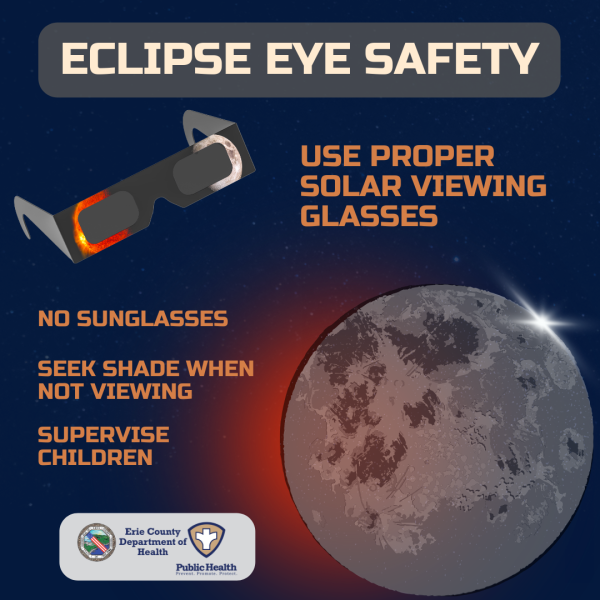

IMAGES
VIDEO
COMMENTS
Packing can be one of the biggest hassles of any trip, but it doesn't need to be. Use this vacation packing list to make preparing for your travels a breeze. This vacation packing list covers the ...
The trick is finding that balance. ( We didn't find it at first on our year-long honeymoon - read about what NOT to pack and learn from our mistakes.) Here's how I plan out what to pack for a trip in advance. Clothes: To plan my clothes for a vacation, I think of the environments I'll encounter on my trip.
1. Determine which credit card (s) you plan to use. Ideally, choose the one (s) that offers the lowest, or zero, foreign transaction fees. 2. If you use a mobile hands-free payment like Apple Pay, ensure your default credit card linked to your mobile payment account is the card with the lowest foreign transaction fees.
24. Do any before-travel grooming or beauty activities. Gotta make sure those brows and feet look nice! 15. Make a copy of your passport, ID and the front and back of your credit cards. And keep somewhere safe, in case anything happens to your wallet. 16.
8. Let your bank or credit card companies know you'll be traveling. If you plan to use credit or debit cards on your trip, call the customer service number listed on the back of your cards and provide the dates you'll be traveling and where you'll be. Otherwise, charges may be considered fraudulent and denied.
On the other hand, if you plan your next trip for a holiday or peak travel time, prepare for inflated prices and larger crowds. If it takes place at a specific time—like during a famous festival or peak tourist season—then start your planning process early. 5. Research Travel Deals.
Here are nine things you should do in the run-up to your trip and before you leave for the airport, from preparing your home and choosing a phone plan to packing the essentials. Make sure your passport is up to date. While a standard adult U.S. passport is valid for 10 years from the date of issue (or renewal), you should renew sooner than that.
Step 7: Stay Focused and Inspired. While you get closer to your goal, make sure that you keep feeding your desire to travel. Travel planning can be exhausting and overwhelming — especially if you don't have support from your friends and family (and especially if your trip is still months away).
2. Make a budget. Let's say you figure your trip will cost $1,500, including airfare. It's six months away. That means you have to save $250 a month for the next six months in order to meet the costs of your trip. [6] Here are a few ideas where you can start saving: [7] Ditch that daily sugary latte.
Pack snacks and/or a sandwich for the plane ride. Reconfirm your ride to the airport. Make sure you've left plenty of time so you're not rushing and stressed about missing your flight departure. Get a good night's sleep before the trip. Turn off all appliances.
Pre-Trip Checklist for Home/Pets. Turn off AC/fans. Take out trash. Clean out fridge/throw out food. Return due library books. Close/lock windows. Unplug electronics. Turn off lights/set timer for ...
Contents show. 1. Book Your Flights in Advance. The first step in planning your trip is booking your flights. This will help you get an idea of how much your entire trip will cost. Compare flight offers and keep a list of important details, including departure and arrival airports and times, fees, and cancellation policies.
1. Save money for the trip. This one is kind of a given but it's important to save money for your trip. While traveling is certainly a wonderful adventure, it's decidedly less fun if you're counting your pennies all of the time or having to skip things that you really want to do because you can't afford it.
Bob Chamberlin/Los Angeles Times via Getty Images. "Buy 'snack size' plastic bags for packing necklaces. To prevent tangling, give each one its own bag and fasten the clasp." — Kathy Roberson ...
Travel insurance provides financial protection for your trip. The best travel insurance companies charge between 4% and 12% of your total trip price, so you should expect to pay around $200 to $600 for a $5,000 trip. Travel coverage can vary significantly from one company and plan to another.
Everything is piling up. Preparing for a trip is stressful. Contents hide. 1. 1. Make a Packing List. 2. 2. Decide How You're Going to Document Your Trip.
Portable USB Charger — Don't worry about your phone dying while you're out sightseeing on your trip abroad: be sure to come prepared by packing a portable USB charger! Purell Hand Sanitizer — We carry this everywhere, and never been sorry to have it floating around in our day bag. READ NEXT.
9. Make Copies of Your Passport and Important Documents. Keeping copies of your documents can come in handy during an emergency, especially if you lose your originals. If you get robbed or lose your passport, having copies ready for officials can make filing police reports and obtaining new documents much easier.
This included the 12-20% discount that some owners offer for guests who stay more than two weeks. If you hunt around, you'll also see that owners sometimes discount for stays of four weeks or longer, and some even discount if you book far in advance, like three months before your trip. Helpful Tip.
Set the heat to at least 50 degrees (to prevent pipes from freezing) and the air conditioning to 85. i. Turn off your water heater, or set it to the minimum temperature. If you're a morning-shower person, you can wait to do this until just before you leave. Unplug appliances, such as your toaster and coffeemaker.
Figure out your main form of transportation in Europe: Get a rail pass, rent a car, and/or book flights within Europe. You can generally buy rail tickets as you travel, but it can be smart to reserve seats on certain trains before you leave. If you'll be renting a car, check the expiration date on your driver's license and renew it if needed.
1.7 Washington DC Explorer Pass. 1.8 Wear comfortable shoes in Washington DC. 2 Top Washington DC Tips for Your First Visit: The Fun Stuff. 2.1 How Many Days To Spend in Washington DC. 2.2 Where To Eat in Washington DC. 2.3 Washington DC Highlights You Can't-Miss. 2.4 The best gift shops in Washington DC.
3. Take the Path Less Traveled. When you are preparing for travel, the appeal of resort confinement or visiting the tourist hotspots may provide you with a sense of comfort. However, the resulting stories can often become just like everyone else's experience.
Preparing for the solar eclipse On Monday, April 8, the moon will pass between the sun and the Earth, blocking out the sun across a major stretch of North America. The HABET team will travel to Carbondale, Illinois, for Monday's total solar eclipse so they can launch a balloon into the path of totality to take readings on how an eclipse ...
2024 is a celestial treat for avid travelers and stargazers: a mesmerizing solar eclipse! This awe-inspiring event, where the moon passes between the Earth and the sun, promises a breathtaking spectacle. The solar eclipse will take place on April 8th, 2024. Proper preparation is essential to ensure you make the most of this rare cosmic occurrence.
Leading up to April 8, cities in the eclipse's path of totality prepare for an influx of tourists. But, even with some extra traffic for airports and airlines, operations likely won't look too ...
Plan to wait in line and allow for extra time on April 9 at the car drop-off. Getting assistance: There will be additional aviation staff on the day of the eclipse and after to provide support to ...
Small towns are pulling off logistical feats to welcome a boom of visitors for the solar eclipse. By Colleen Grablick. March 28, 2024 at 1:47 p.m. EDT. Ryan Mammone, of New Hartford, N.Y., relaxes ...
Up to a million people expected to travel through Kentucky during April 8 solar eclipse. LOS ANGELES, CALIFORNIA - NOVEMBER 23: Heavy afternoon traffic moves along the I-5 on November 23, 2022 in ...
Erie County encourages residents to prepare in advance for the eclipse through the following considerations: Plan travel ahead of time. Try to arrive early to viewing locations, utilizing public transit or carpooling if possible. Stay put for the duration of the eclipse, and plan on leaving late from viewing events. ...